
Improve your practice.
Enhance your soft skills with a range of award-winning courses.

How you can Improve your Presentation Skills with VR
April 9, 2021 - Dom Barnard
In today’s business environment, you must have good presentation skills to be successful. We live in a world of meetings, presentations and conferences, in which a clear and assertive presentation can get you a promotion, fund your idea or secure a contract.
Presenting information clearly and concisely is the key to getting your message across. However, most people feel terrified when asked to speak in public. Through practice and preparation, you’ll become more confident in your presentation skills, and you’ll find yourself being less nervous when public speaking.
We’ll explain why virtual reality is the perfect tool to increase your confidence and improve your presentation skills.
What is virtual reality?
Virtual reality is the term used to describe a three-dimensional, computer generated environment which can be explored and interacted with by a person. That person is immersed within this environment, giving the impression that the person is really there, and can perform a series of actions within this virtual world.
We’re using virtual reality (VR) to immerse people in different realistic presentation styled environments, where they can practice and perfect their skills.
- Read our complete guide to virtual reality .
Practice in the safety of your own home

Give a TED talk in front of hundreds of people, deliver a speech at a wedding, teach a room full of students – all from the safety of your own home. By practicing your presentation skills in virtual reality, you’ll build up a positive visualization in your mind of you delivering a great presentation.
Plenty of studies have proven the effectiveness of positive visualization . When we imagine a positive outcome to a scenario in our mind, it’s more likely to play out the way we envision. Instead of thinking “I’m going to completely forget what to say on stage”, use VR to visualise yourself delivering an inspiring speech with great enthusiasm.
Practice with your own slides
With the VirtualSpeech app , you can add your own presentation slides into the virtual room with you, so that you can practice for an upcoming event. Simply save your presentation as a PDF document and add it to the app – you can change the slides in the virtual world by pressing your VR headset trigger.

Add your own slides to the virtual meeting or conference room to practice with.
Poor delivery and timing are the most common problems people have when they make a presentation. Being able to time what you say, at the correct point in your speech, with the right presentation slide, are important skills and require you to know your content well.
Practicing your timing in the virtual world will make you much more confident when delivering the speech for real. You can even try out several different ways of delivering the same material and decide which sounds better.
Speakers that practice come across as confident , and avoid the “umms” and uncomfortable silences that detract from the message. Knowing your slides and practicing your delivery with them, will help keep the presentation within a reasonable timeframe. Audiences appreciate presentations that make the point clear and concise.
Video showing how you can practice presentation skills in VR .
Listen back to presentations
One of the best ways to improve your presentation skills is to listen back to your own speeches. Once you’ve delivered a speech with the VirtualSpeech app, you have the option to save your speech and listen back to it at any time in the future. When listening back to it:
- Listen for timing of deep breaths – when we’re nervous, our muscles tighten and we take shallow breaths – you may even hold your breath as you try and get all the information out at once. Instead, take deep breaths to relax your body and expand your vocal range.
- Listen for timing of pauses – When you’re nervous, you might speed up your presentation and end up talking too fast, which in turn causes you to run out of breath. Don’t be afraid to slow down and use pauses in your speech. Pausing can be used to emphasise certain points and give you time to think about what to say next. This is particularly useful when answering questions after a presentation. If you feel yourself losing control of your pacing, just take a nice pause and keep cool.
Practice deep breaths and pauses using VR to get you ready for the real event.
Instant feedback on your presentation
Using our speech-to-text technology, you can receive instant feedback on the pace of your voice, any hesitation words used, eye-contact and more.

Feedback includes:
- Hesitation words : gives the number of hesitation words used out of the total number of words in your speech
- Eye contact : gives you a score out of 10, related to how long you were giving eye contact to the virtual avatars
- Pace of voice : gives you a rating and words per minute you can use to improve your next speech
Track your progress
Track eye contact, hesitation words, speech length and more – you’ll be able to analyse how you’re improving these metrics over time.

Variety of presentation rooms
Need to prepare for a team meeting? Presenting at a conference? Giving a TED talk? VR can immerse you in a variety of rooms to suit your needs and improve your skills for the correct type of event. The more adjusted to your environment you are, the more comfortable you’ll feel.
With VR, you can spend time in a similar room to where you’ll be delivering your presentation. You’ll be able to practice with a realistic audience, sound (audience and environmental), lighting distractions and even audio feedback like you’d get with a microphone.
Our presentation rooms include:
- TED styled theatre
- Meeting rooms
- Conference room
- Press and media styled room
- Wedding / occasions room
- Networking room
Gamification
Eye contact, distractions and impromptu speeches can all be improved in a fun and engaging way. We’ve build mini-courses to help you learn the essentials of presentation skills, including:

- Eye contact training – Ace your eye contact skills and connect with the audience more than ever before. Our VR training will show you a heatmap of where you’re looking in the audience and where you should shift your focus to, so that your speech has a greater impact.
- Sound and visual distractions – Successful speeches require focus and it’s easy to get distracted. Learn how to deal with various sound and visual distractions, including mobiles phones ringing, audio feedback from speakers and flare lighting, so that you’ll look like an expert in no time!
- Impromptu speaking – Didn’t have time to prepare for your speech? No problem! Our fun game lets you practice quick-thinking by talking about a series of random slides for 30 seconds each. You’ll be able to give speeches at short notice and answer questions more easily with this brain training.
- Speech insight – Use cutting-edge technology to receive feedback on 15 different areas of your speech such as persuasiveness, aggression, and openness. You’ll be a lot more prepared for the real thing knowing how your audience are likely to perceive you.
Practice as often as you like
You’ll want to rehearse your presentation multiple times – it’s essential if you want to deliver a great presentation. However, it’s hard to improve without actually presenting to an audience. With VR, you can practice in a realistic way as often as you like – whether it be ten or a hundred times. This is a great way to build confidence in your presentation abilities.
Some leading public speakers suggest rehearsing lines in various positions and in different orders – this will ensure you don’t just memorise the speech line for line and can handle unforeseen distractions.
The more you mix up your presentation and setting, the more comfortable you’ll feel with your speech.
Start improving your presentation skills today with our public speaking course integrated with VR.
Contact: [email protected]

Using VR for Company Presentations – Benefits & Considerations
As virtual reality (VR) grows in popularity, businesses are starting to recognise its potential for businesses. Compared to static slide decks, presentations in virtual reality can be a more engaging way to jot through the agendas of meetings.
Though unique and niche, these types of presentations have their uses for many reasons. They can provide more opportunities for engagement than traditional methods of sharing information, as a clear way to deliver info that leaves a lasting impression. PowerPoint and two-dimensional pieces of paper just can’t compete with it. Because of this, VR is useful in training , sales, marketing , and internal communication, among many other areas. It presents ideas and designs clearly, making it a brilliant presentation tool that leads to a lasting impact.
Not Another Boring Presentation
But first, let’s touch on the flaws of presentations nowadays. At best, they can be static and sprawling behemoths of information which help communicate vital information, with a set journey and purpose. At worst, the slow presentations are distilled at a snail’s pace, as a slide show of banality that viewers watch as their eyes glaze over in boredom.
The fundamental issue is that there is a lack of engagement with traditional presentations. Viewers are expected to sit back and absorb, but the content itself may not be engaging or interesting enough to land in the way that may be desired. User participation is important for maintaining interest across the length of any presentation, as it keeps them on their toes and makes them feel that they have a stake in its presentation. Some companies added the option for users to ‘vote’ on polls during a presentation, which serves the same purpose; but the number of times the tool can be used are few and far in between.
To avoid the banality of corporate presentations, companies need to consider the following questions:
- How can I make the presentation as interesting as possible?
- How can I keep the viewers engaged over a longer period of time?
- How can I make the purpose of the presentation clear, so that I can build towards the goal throughout the process?
With all three questions, VR presentations offer a natural solution.
Why use VR for company presentations?
VR has many unique advantages over its printed or PowerPoint counterparts. For one, VR presentations are more interactive, leading to a greater level of engagement from viewers. No presentation can match the immersive nature of standing in a virtual world that reacts to your actions, while a narrator explains the significance during the session. That impact has an effect that no piece of paper can match.
A presentation outlining images of the product – like a car, for example – can seem boring and dull, as the static images cannot convey the full spectrum of qualities that a product may convey. But showing the same product in VR – where users can roam around and go inside the car – can let users fully grasp why it can service their business needs. The approach can help to convert sales or reel people further into the brand’s world, which makes them understand the significance of a product or service.
The range of potential applications are widespread. VR can create a virtual tour of the company’s facilities or show off its products and services in action, which can be deployed on tour or at events like MWC. Companies can also use VR for internal communication presentations, such as town hall meetings, where employees can better understand their business and where it is heading.
Additionally, VR presentations can be viewed on a wide variety of devices, making them more accessible to a broader audience. The most common headsets are the Quest 2, created by Meta. Standalone and cheap, the headsets can be deployed at a larger scale, and then be used over and over again where necessary. Further, if one breaks for any reason, they are cheaper to replace than an expensive counterpart.
What to consider when presenting in VR
Yet with all the promise of VR presentations, they must be applied properly. Like all other tools, it must be backed by sound reasonings and plans in order for it to land with the impact it warrants, while straying away from gimmicky territory. For that reason, companies need to keep a variety of items in mind when planning their approach.
Many companies could gain from using VR and augmented reality . The technology is helpful for product demos, business presentations, internal communication events, and more. Despite being new technologies, VR and AR are good tools for displaying any message for any brand. You can use VR to gain a much more in-depth understanding of a topic, place, or product.
- Start with a goal in mind
When designing VR presentations, you first need to determine how to achieve the intended outcome, which kind of images you want to use, and the plan for your VR content. If the point is to convert potential customers, then the VR presentation should outline its positive attributes with no blemishes to the user experience. If the point is to engage people in a meeting , then it must find ways to bring people in while educating them on the company’s core endeavours. With a clear goal, the path to success can be built more clearly.
- Explore how to make a presentation more interactive
Engagement is one of the most important elements to consider, as it keeps them focusing on the presentation at hand. Companies can make their presentations interactive by adding more features to the display, including clickable links and hotspots to provide even more information. If you want to take things a step further and involve the audience, you could include quizzes and other activities within your VR presentation. Find ways to make your users move, and it will keep them on their toes in the long-run.
- How long should I make the VR experience?
A VR headset can be intense, and some headsets can even be uncomfortable a little longer. Don’t worry about increasing the length of your VR integration. You can have lasting memories with just 2 minutes of video. Prioritise making a short but impactful experience over a long and drawn-out one, which can help to land the full piece when necessary.
Taken together, VR content offers a whole new immersive experience for company presentations. They can be used in sales, marketing, or internal communications to create an exciting and engaging meeting that your team will remember long afterwards, bringing them together into (literally) your own world.
For VR presentations to succeed, teams must consider the full breadth of qualities needed for it to land with the impact it deserves. They must align closely with the intention and contents of the meeting, rather than languish as a gimmick, and recyclable so that they can be used many times over. With these aspects in mind, businesses can use them to help convert sales and land a positive impression with prospective clients.
Get in touch with our team and we’ll help you make something extraordinary!
Subscribe for our Monthly Newsletter on using VR for Business

Extended Reality for Business – Why You Should be Interested

Extended reality in manufacturing – Benefits of XR & Uses

What is extended reality and what can it be used for?

Extended reality in healthcare – benefits and examples
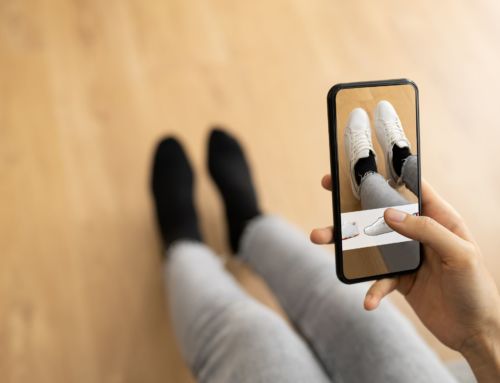
Augmented Reality Marketing – Benefits & Examples

How augmented reality can be used for engineering
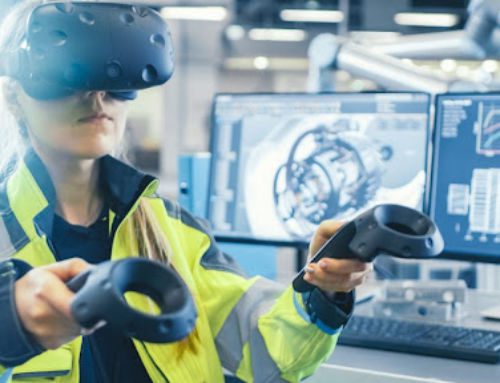
The metaverse and applications for oil and gas
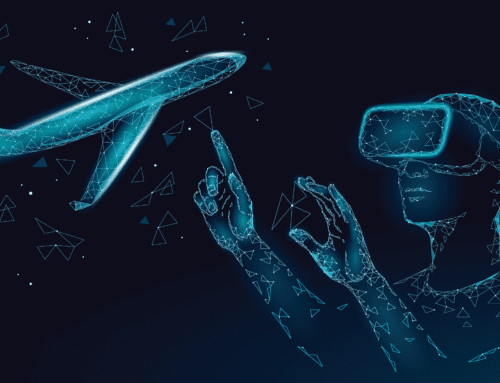
Virtual reality in aviation training
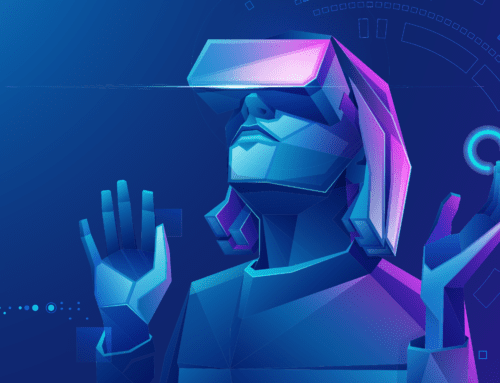
Disadvantages of VR Training
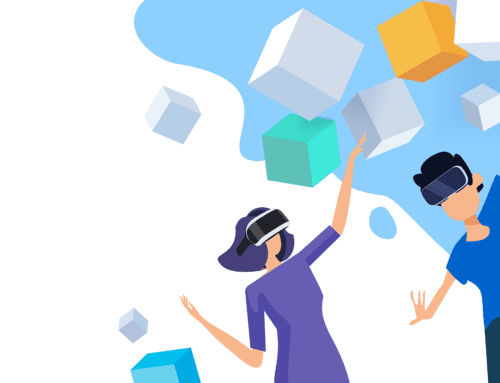
How Can VR be Used in Business

VR Training Data – New Opportunities to Improve Learning Performance

6 ways to make training more engaging

Digital Transformation in the Energy Sector

How VR is Driving Digital Transformation

Innovative working at height training using VR

How to work at height safely

How to Promote a Culture of Remote-First Work
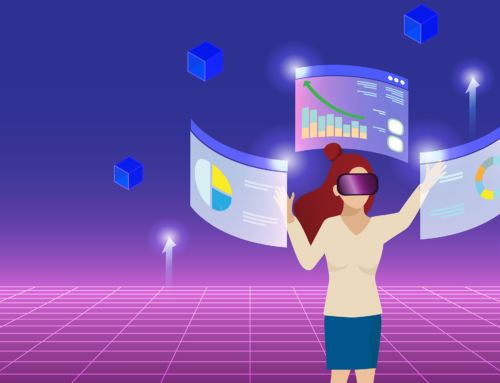
The Metaverse Workplace – The Future Of Work?
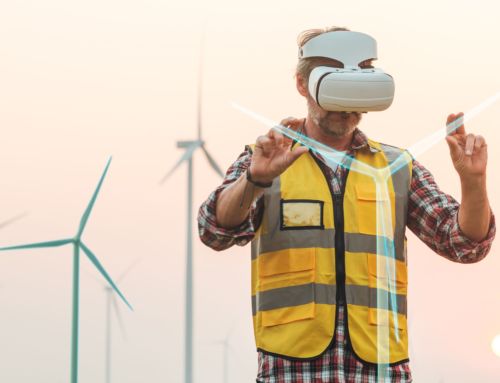
Why virtual reality is the future of wind turbine training
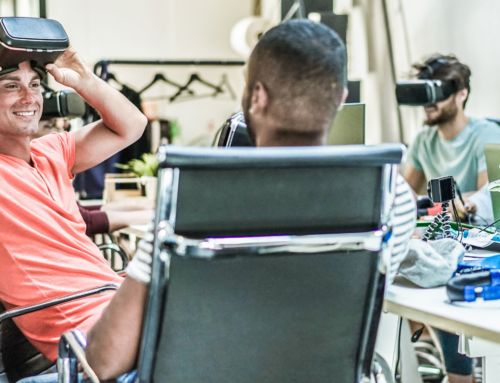
How to Scale VR Training
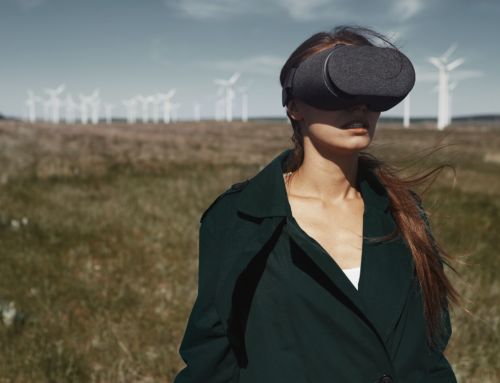
Why Using VR for Training in the Renewables Sector Makes Sense
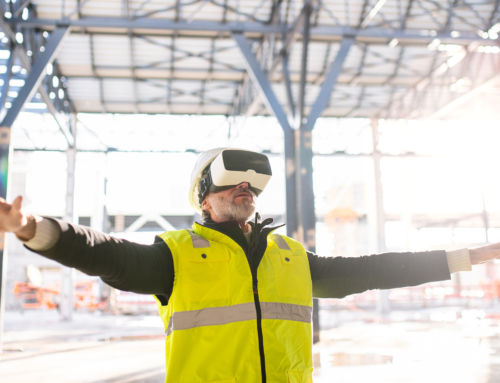
Using VR for Construction Safety Training
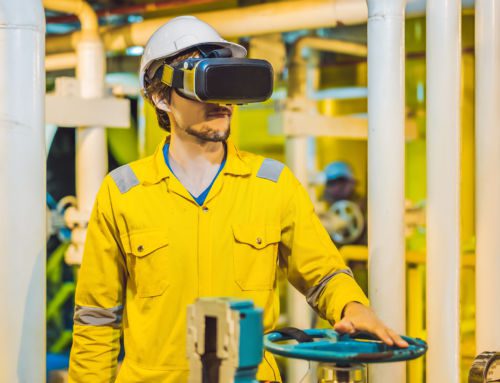
How VR Can be Used for Safety Training in the Oil & Gas Industry

VR Safety Training – Benefits & Use Cases
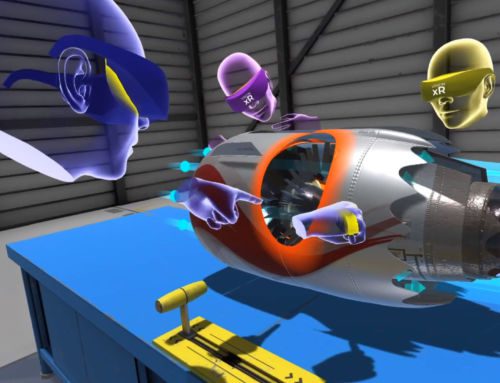
Group Training in a Multi-User VR Environment

Why Businesses Need to Consider VR for Marketing

What are Distributed Teams?
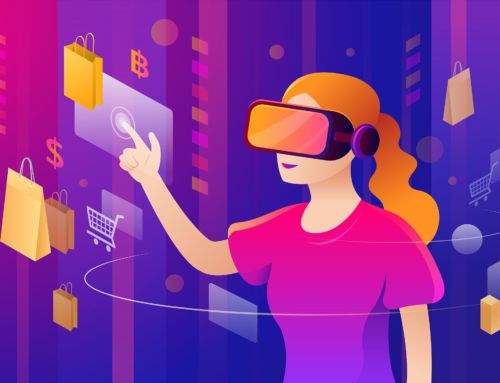
VR Marketing – Benefits and Examples

How to lead a distributed team in 2022

What is Hybrid Working?
Let’s talk.
Ready to get started? Book a demo with us today and see the benefits that virtual reality could bring to your business.
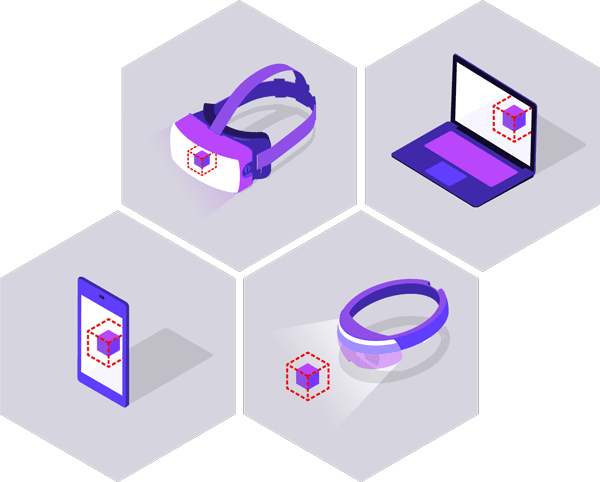
Visit: 29-30 Castle Street Brighton BN1 2HD
Email: [email protected]
Future Visual Privacy Policy | All content copyright FutureVisual 2022
Privacy overview, third party embeds.
- Tracking Cookies

How to Use VR to Improve Your Company Presentations

How to Use VR for a Company Presentation
This past week, the UK Department for Digital, Culture, Media and Sport released their long-awaited “ Culture is Digital ” report. They did something unique to promote their findings — they created a 360 WebVR presentation using InstaVR.
Check out that 360 VR Presentation here .
This innovative use of InstaVR and the VR medium reminded us how the technology can be used to add visual and auditory flair to what used to be fairly standard presentations.
Let’s be honest: PowerPoint is starting to get a little boring. So we’re seeing more and more companies turning to VR. It helps presentations come alive, incorporating video and CGI, and makes for a unique and memorable viewer experience.
So this week we’re doing a deep dive on how to incorporate InstaVR-created apps into your internal and external presentations.
Jump to Section
- Why Use VR for Company Presentations?
- Begin With a Goal in Mind
- How to Distribute Your VR Presentation
- Authoring Your VR Presentation
- Using Hotspots to Augment Your VR Presentation
- Publishing Your VR Presentation
Virtual Reality (VR) has a number of unique advantages over printed or PowerPoint materials:
- It’s exciting , incorporating the visual (images & videos) and auditory senses. A picture is worth 1,000 words. But a 360 image or video — particularly a stereoscopic one — is worth way more than 1,000 words.
- It’s immersive , capturing the full attention of the user if they’re in a VR headset. This leads to greater recall and a stronger impression on the viewer of the experience.
- It’s interactive , if you add Navigation or Hotspot overlays to your presentation. This allows your audience to Navigate to the info or media they want, as well as enabling you to augment it with informative or entertaining image/video-based hotspots.
- It’s easily accessible , both for you in terms of making the experience using InstaVR, but also to your employees, partners, and clients. You can create an iOS/Android app that the user can pull up easily on their phone anytime they want.
VR isn’t just the future of presentations — it’s the present. In fact, a VR company late last year did their entire pitch to Venture Capitalists in virtual reality. And it worked! Don’t underestimate the power of VR to leave a good impression on your audience.

(Image from “ Culture is Digital ” 360 VR Presentation)
The first step in creating a compelling VR presentation is deciding what the goal is. Once you have the goal, it will inform other questions like how to author the application and how to distribute it. It will even help determine which type of 360 media you want to use — images, video or CGI.
Do you want your presentation to educate the user?
This is the main goal of the UK Department for Digital, Culture, Media and Sport. They wanted to take the information found in the “Culture is Digital” report, and have it come alive with an interesting visual presentation. They mainly did this through Hotspots they overlaid in the 360 space, that users could interact with to get more facts.
You can also see this done excellently in client Mimacom’s VR application . Their office tour is augmented throughout with informational Hotspots informing you about facts concerning the company. So in the presentation, you not only get to see the office and the workers, you get to learn something.
Do you want your presentation to transport the user?
One of the huge benefits of VR is the ability to transport users immersively to a new location. So when we spoke with Charles Jordan of Nestle , it wasn’t surprising to hear they’re planning to use VR to get employees excited for a move to a new office in St. Louis. A company can use 360 videos to transport users immersively across the country, or across the world.
Do you want your presentation to energize the user?
VR is a great way to energize others — be it clients, partners, or employees. For instance, for their annual sales meeting, our client Premise LED put together a compelling before & after VR experience to showcase how their lighting has improved car dealerships. This type of application will later be used by the sales associates themselves. But the introduction of the new technology as part of their presentation at the sales event was a nice departure from the typical PowerPoint that you might see at these types of meetings.
Once you’ve determined what your goal is, you can start creating the media to author in the InstaVR platform. If you’re trying to educate, you may have to spend a bit more time in Photoshop creating innovate Hotspots. If you want to transport users, you may have to fly to a different location to take 360 video (or you can do like TUI Group, and mail Nikon KeyMissions to your other offices ). But the first step is always determining what you want your users to feel once they take off their VR headset.

(Image courtesy of Premise LED )
3. How to Distribute Your VR Presentation
It may seem odd to start with distribution… this is usually the last step in your VR creation process. But which headset — or mobile device, tablet, or web screen — your audieence plans on using to access your VR presentation will affect your approach to creating it. So it’s best to go in knowing exactly how you plan to distribute. We’ll discuss the Pro/Cons of each of the major platforms for Presentation distribution.
WebVR — Either on Mobile Phone or Laptop
Pros — Widest distribution possible. All you have to do is either link to your VR hosted on our InstaVR CDN or embed your experience into your web page. Thus, you could theoretically easily send to all your employees through email, Slack, Intranet, etc. Also, you can utilize our Call-to-Action functionality to allow users to click through to relevant non-VR web pages.
Cons — Not as immersive. Also, WebVR is not as good for 360 video, something we’ve discussed more in depth here . But if you’re just going to be doing an image-based VR experience, and are not as concerned about the user experience, the positives of easy distribution (like with the “Culture is Digital” project ) is important.
Low-Cost Mobile VR Headset — Google Cardboard or a Generic Plastic iOS or Android Headset
Pros — Low cost, so you can purchase many of them if you need it for a company event. You can also brand Google Cardboards, making the VR presentation even more memorable. User will have your app on their phone until they delete it.
Cons — Not nearly as immersive as the other headsets. So if your presentation is for say an important client, it’s probably best to invest in a more heavy-duty, larger Field of View VR headset such as Gear VR or Google Daydream.
Higher-End Mobile VR Headset — Samsung Gear VR, Google Daydream, or (soon) Oculus Go
Pros — Easy to carry or ship for presentations at other offices, including clients and partners. Nicely immersive and can also be enabled for long-form VR, if necessary.
Cons — Can be fairly expensive (each phone + Gear VR will cost you about $800 USD) or lack phone compatibility (Daydream still limited to only a handful of phones).
Higher-End Tethered VR Headset — HTC Vive or Oculus Rift
Pros — Can do very detailed, high-resolution, long-form VR. No chance of overheating (as sometimes happens with Gear VR, if used for too long).
Cons — Can be expensive, as you need a higher-end computer and graphics cards to run these. Because most companies will purchase only one or two of these, only 1-2 people can experience your VR presentation at a time.
Picking the right distribution model is important. It also informs what kind of VR you create — image vs. video, short-form vs. long-form, passive vs. interactive. Definitely consider distribution model on your VR presentation before you actually even start the 360 filming or CGI creation process.

We already have a couple of tools for helping you to author your VR application, including:
- Our “ Comprehensive Guide on How to Author a VR App Using InstaVR “
- The Interactive Tutorial, which you can access directly in your Console (or watch on video)
- Live training every Thursday at 10am EDT at https://join.me/instavrandrew
So we’ll use this section to discuss some of the questions you’ll have to answer while Authoring your VR presentation.
How long should I make the VR experience?
Those new to VR might be tempted to make a fairly long VR presentation. When using standard video, it’s not uncommon to have 4, 5 or more minutes of video. But VR is a little different. Being immersed in a VR headset is pretty intense, and for some headsets (ie HTC Vive), can get uncomfortable if worn for too long.
There’s no perfect length for a VR presentation. But you can make a strong impact, with lasting memories, with 2 minutes or less of 360 video. If you overshoot and overproduce, you get diminishing returns.
Should I Make the VR Passive or Interactive?
Passive VR is when a user can sit back and just watch a 360 video. Interactive VR is when the user can engage with the material they’re watching — either by choosing the next scene, engaging with Hotspots, opening web pages from the VR, etc.
Generally, if you’re presenting to a large group or those completely new to 360 media, passive VR might be easier. It requires less activity by the watcher. Whereas in a smaller group — like if you’re doing a sales presentation or showing your VR on a Vive or Rift — making it interactive makes more sense. Interactive VR is by nature more memorable, as the user’s brain has to be engaged, so it’s definitely advantageous if used with the proper audience.
Should I Use 360 Images or Videos (or CGI)?
The CGI question is easy if that is your primary use case for VR, as is often the case for companies in the architecture or engineering space. But even if you’re planning to use a 360 camera, you can augment your application with “computer enhanced” imagery using a program like Photoshop or Adobe Premiere Pro . The UK Government Department for Digital, Culture, Media and Sport clearly spent some time and effort to make their 360 experience pop , using exclusively CGI graphics.
The question of 360 images or video really depends on the use case. Images are static and not as engaging, but you can enhance the overall experience using InstaVR by adding mp3 voiceover or music. Videos have a greater recall, but will take you longer to film and are best experienced in a VR headset. If you’re presenting information, 360 images might be better. If you’re trying to evoke a feeling through your presentation, you may be better off using video.
Authoring a VR experience is relatively simple with InstaVR’s drag-and-drop interface. If you haven’t read it already, our intro guide on app authoring can help you get started. You’ll have to answer some important questions though before starting — such as length of VR experience, passive or interactive, and image or video.

5. Using Hotspots to Augment Your VR Presentation
We’ll talk a little more in-depth about one particular part of using InstaVR to make your experience interactive: Hotspots . These are 2D images (png/jpg) or videos (mp4) that can overlaid directly on top of the 360 media. For non-WebVR apps, we also enable clients to customize the Hotspot appearance, via time-based Hotspots and auto-playing Hotspots. (Without utilizing those advanced features, the Hotspots can be triggered by users while immersed in a scene by gazing/clicking/using a hand controller).
For presentations, Hotspots can be used for:
Giving A Close-Up View or Video of an Object in the Scene
For presentations, you’re often virtually transporting a user to a new location. Within the scene, a user may have an interest in learning more about a particular object within the 360 scene. That’s where a Hotspot can be particularly valuable — a user can initiate a Hotspot and get a more close-up view or video of the particular item.
Providing Additional Information
Though Hotspot images have to be .jpg or .png, it doesn’t mean they have to be traditional camera images. Using a program like Photoshop, you can use Hotspots as an information delivery method to your users. For instance, if I’m looking at a presentation of a proposed building from a construction firm, the Hotspot could convey information on building materials, expected completion date, square feet, etc.
Entertaining
Not all presentations are meant exclusively for conveying information. In some presentations, you’re just looking to entertain or energize the viewer. If you’re showcasing your company in VR for a recruiting presentation, you can add Hotspots to showcase employees having fun outside of the office, for instance.
Hotspots in InstaVR allow you to augment your VR presentation. If you’ve decided to go the interactive route with your VR app, there’s no reason to not utilize Hotspots. Use them for practical purposes (close-ups), informational purposes (adding text information), or entertainment purposes (to add additional 2D video to your scene)

6. Publishing Your VR Presentation
We discussed a bit earlier in this post the potential VR outputs. Hopefully after reading that, you’ve selected your distribution method for your presentation. Below, we’ll get into the specific mechanics of distribution.
iOS/Android/Google Cardboard
InstaVR Pro offers the ability to publish to iTunes or Google Play. But since most presentations are for in-house or client/partner purposes, we’ll focus exclusively on in-house here.
Android is a very open platform, with Google allowing you to freely distribute the white-labelled InstaVR-generated .apk file. That means you could host the .apk on your company website, in a file sharing program like Google Drive or Dropbox, accessible via download through the InstaVR website, or through an InstaVR-created QR code. It’s simple!
Apple wants a little more control over in-house app distribution. So the main way to currently download this type of file, outside of the iTunes Store, is by sending an email invite for your users to download the application. That being said, you can create a generic username and password on InstaVR for the invite, and distribute that along with the link. So it’s not quite as easy as Android, but not too difficult either.
Samsung Gear VR / Google Daydream
Samsung Gear VR is a very popular headset for presentations, as it’s mobile and immersive. We cover the distribution methods towards the bottom of this article on publishing Gear VR apps . Using the InstaVR DeviceID app , you can easily collect phone IDs, create Oculus Signature Files, and publish a single app that will run on all the intended Samsung phones.
Google Daydream publishing is actually even a little simpler than Gear VR, as the DeviceIDs are not needed. Like with Android, you simply create an .apk file specific to Daydream-compatible phones, and sideload them to run in conjunction with the headset.
HTC Vive / Oculus Rift
The output file here is a .exe. So you just need to get that .exe loaded on the computer that is tethered to the Vive or Rift headset. Super easy!
You have two options with WebVR: utilize our CDN or embed on your web site using the InstaVR files. With the UK Government Department for Digital, Culture, Media and Sport, they use our CDN. They simply link to the presentation on their public web site and in press releases touting the presentation. Other companies would rather host it on internal-only sites, in which case the Zip File (self-host) approach makes sense. Self-hosting also allows you to provide additional context to the WebVR, meaning your VR could be incorporated as part of a larger presentation page.
Distributing your VR is made simple using InstaVR. Obviously publishing to the right VR headset, tablet or web is important. But distributing the VR is also important, to make sure your intended audience sees the VR presentation you spent time making.
6. Conclusion
Presentations are no longer boring. PowerPoint and paper handouts are a thing of the past. With 360/VR technology available to everyone, companies have to up their presentation game if they want to stand out.
Creating immersive, interactive, memorable VR is as simple as buying a 360 camera, a VR headset, and InstaVR Pro.
There are many things to consider when crafting a VR presentation. We’ve covered much of that above. But we look forward to helping you as you author your VR application. Don’t hesitate to reach out to us via email, Live Chat (business hours GMT on weekdays), or attend our live weekly training at 10am EDT on Thursdays.
Make your VR apps in minutes ! – InstaVR
Selected by 50,000+ companies and professionals..

Share with:
Related posts.

InstaVR Launches Academic Organization-wide Tier Pricing to Accommodate Distance Learning and Campus Virtual Tour Needs

How Virtual Reality (VR) Helps Companies During the Coronavirus Outbreak

Step-By-Step Guide for Building Quizzes Into VR Apps Using InstaVR

What are Colleges & Universities Using VR For?

What’s New in 360-Degree VR Cameras (Fall 2019)?
- Enterprise Java
- Web-based Java
- Data & Java
- Project Management
- Visual Basic
- Ruby / Rails
- Java Mobile
- Architecture & Design
- Open Source
- Web Services

Developer.com content and product recommendations are editorially independent. We may make money when you click on links to our partners. Learn More .
Development, like many tech processes, can generally be done remotely, so the impact of a pandemic and social distancing can be minimal. Even so, developers must interact with others on a project to ensure success. Oftentimes, this includes meetings as well as presentations.
Why Use VR for a Tech Presentation or Meeting?
Many meetings are being done using tools such as Zoom and Microsoft Teams. These tools are great for discussions and sharing a screen, but leave a feeling of being remote and isolated. Another option to help bring people together in a manner that feels more engaged and better simulates being together in person is the use of Virtual Reality, through one of the many existing VR platforms for interacting.
Consider that one of the reasons people travel to corporate offices or other locations is to meet in person. This is not only for the human interaction and collaboration, but also for greater focus on the issues under discussion. VR simulates being in a live meeting, making engagement greater without the cost of travel.
What Can Be Done in a VR Tech Presentation or Meeting
While most of today’s VR platforms don’t provide life-like avatars, they do provide human-looking avatars and meeting places that can mimic meeting rooms or conference centers. For normal meetings, they can provide the same “sitting around the table” atmosphere, including the table. For conference presentations, they can provide the stadium seating feel as well as the large-scale projection screens that can be used for presentations. Presentations within many of the VR platforms can pull in the same PowerPoint decks , videos, and demos that would be done in a live conference center presentation.
With some VR platforms, when doing a conference, multiple smaller rooms can be created to view the same presentation. This gives a more intimate feel for a conference or presentation while being able to support hundreds (or more) people. All individual rooms would see the same speaker and presentation at the same time. You can have the speakers on a stage with screens, a pointer, and a microphone just like a conference in real life. The stage can have a podium with a microphone that picks up conversation from those near it. People in the audience can whisper to the person sitting next to them if they want. A virtual microphone can also be handed out in an audience to allow attendees to ask a question of the presenter in the same manner as a live conference. After the presentation, the members in the audience can walk up to the stage and interact with the speaker just as if it were live. Of course, features from desktop conferencing and meetings such as chat windows, hand raising and screen sharing are options in some of the platforms as well.
In short, a VR presentation can have nearly every benefit of being in person, but without the need to be in person. The primary disadvantage is the loss of the ability to see body language.
Platforms for Doing a Technical VR Presentation or Meeting
There are several platforms available for doing VR meetings and presentations. There are two that I’ll cover, Engage and AltspaceVR, followed by a list of other platforms that offer similar features.
Engage is presented as a virtual reality training and educational platform to make it easy to collaborate, create, and learn in VR. The platform allows you to do meetings as I’ve described earlier in this article, including virtual meeting rooms and conferences.

Engage also lets you build immersive environments that go beyond a standard classroom. It also allows for interactivity and collaboration. Just like in a real world conference room, you can do presentations, share videos, and engage in interactive white boarding where participants can collaborate. Such collaboration on white boards allows you to do planning and designing just as if you were in the same room.

Another benefit of VR platforms like Engage is that you can create virtual rooms or worlds that can help in your presentations or training. Instead of just showing slides of modeling, you can create 3D renderings that can be reviewed. For example, if you were working on an embedded systems project, you could mock up a device and its use within a VR world so that people could see how it looks.
The Engage platform comes with a number of core features that let you work with up to 50 remote users. You can create and stream content. You can use existing objects (there are over 1,200 3D objects and effects), and you can use their virtual locations (there are over 21). They include collaborative features and objects as well as built-in quizzes and forms you can use inside the virtual environments.
AltspaceVR is an entire world where you can attend live shows, meetups, and classes as well as simply interact with people. Altspace is a more popular platform that has been used for conferences with VR as well as meetings and other events. It provides the ability to create event rooms and can include presentations, interactive forms and quizzes, and many of the features mentioned above. If you are doing public meetings within AltspaceVR, you have the ability to use features like block, report, and mute as well as tools to help with raised hands, stage blocking, hosting panels, and more.
AltSpaceVR is a more “public” platform in that there are many events happening that have nothing to do with technology. These mainstream events, however, are helping the platform to grow. While it can be easy to be distracted by the latest presentation on meditation or discussions on rock climbing, those events are drawing people to the platform. Additionally, this mainstream usage means that many of the needed features and customizations for doing technical or team meetings and presentations are already built into the platform.
Other VR Meeting Platforms
Of course, there are a number of other VR platforms that can be used for meetings. These include:
Connec2 – https://connec2.nl/
Dream – https://dreamos.com/
GatherInVR – https://www.meetinvr.com/
Glue – https://glue.work/
Immersed – https://immersedvr.com/
MeetingRoom – https://meetingroom.io/
MeetinVR – https://www.meetinvr.com/
Rumii – https://www.dogheadsimulations.com/rumii
Spatial – https://spatial.io/
vSpatial – https://www.vspatial.com/
Developers can customize VR tools
For developers, Engage and AltspaceVR are both extensible. To build your own worlds and features, you can use the Mixed Reality Extension (MRE) SDK as well as use their World Editor. The World Editor lets you add 3D objects, teleporters and extensions and more. In a future article, I’ll provide an overview of what the MRE SDK offers developers.

VR equipment needs
The downside of using VR for meetings, presentations, or collaborative efforts among a team is the need for the VR equipment. In most cases, you will need the VR headgear, VR controllers, and a machine with the appropriate specifications to support the equipment. Fortunately, the cost of VR equipment has dropped and the specifications for the average workplace computer has gone up.
The VR equipment can range from about $300 on up if bought on sale. This includes Mixed Reality tethered headsets that generally come with controllers. Entry level Oculus devices such as the Oculus Quest2 can be found for around $300, with controllers as well. HTC Vive devices with controllers start around $499.
While this might seem expensive, when you factor in the cost of a plane ticket, hotel room, and transportation costs, it is pennies on the dollar. When you add in the ability to gain better focus and engagement over using tools like Zoom and Teams for virtual meetings you gain additional value as well.
Virtual Reality is still evolving and has a way to go before a ‘real life’ experience will be possible; however, it is getting closer. Even using today’s entry-level equipment, the experience is at a level that works. VR also adds another intangible value in that it is leading edge and cool. While this might seem irrelevant, when working with developers and technical staff it is often such things that keep them engaged with your business. In a world where there are a lot of open technical positions, using VR might be the thing that sets you apart.
Get the Free Newsletter!
Subscribe to Developer Insider for top news, trends & analysis
Latest Posts
What is the role of a project manager in software development, how to use optional in java, overview of the jad methodology, microsoft project tips and tricks, how to become a project manager in 2023, related stories, best online courses for mobile development, best gantt chart software for mobile developers, top tools for mobile developers.

With literally two clicks within Revit or another supported design application, you can be in VR and exploring your model. This technology offers a compelling opportunity for design teams to verify and review the design internally as well as a more natural way for a client or stakeholder to explore and experience the proposed design.
This is clearly not a fad or gimmick as the response from clients, tech and non-tech savvy alike, have already given their high praise.

Dan is an author, blogger, educator, design technologist and Wisconsin-registered architect. He is the Director of Design Technology at Lake | Flato architects in San Antonio, Texas. Connect with Dan on LinkedIn .
Subscribe to Our Blog
How to deliver an engaging client presentation in VR
One of our popular use cases is delivering an engaging client presentation. From selecting the perfect sunset backdrop to using 3D objects, in VR you can create an immersive expereince for your clients.
.png)
Can you imagine fully immersing yourself in beautiful environments, feeling as if you are having an in-person meeting with real interactions, and literally walking your clients through engaging presentations remotely? Sounds fantastic, right?
If you are interested to know how you can use Arthur to deliver engaging presentations, keep reading!
Firstly, you can choose from various presentation rooms in Arthur, depending on your needs and preferences.

Once you know where you want to have your presentation, it is time to discover the different tools you can use to create an engaging experience.

You could have a classic presentation in one of our auditoriums, with a beautiful background and the opportunity for full focus and attention. You can also spread your presentation in a VR office environment and literally walk your clients through it slide by slide while also making real-time mark-ups and comments on the presentation.

If you want to showcase a video in a cinematic feeling, you can easily upload a mp4-video file to Arthur.

Want to have an in-depth discussion with your client but while keeping track of time? Use whiteboards and add a timer for this exact result!

A fun way of applying our text labels in such use cases is to create an interactive mind map about any topic to discuss with customers.

Did something that can be found on the web come into your head spontaneously during the presentation, or do you want to show your website to a remote client? We have a browser available in Arthur that can help you in such cases and many more.

Do you like creating different things with the 2D shapes in PowerPoint? With 3D shapes in VR, you can do exactly the same, except for the opportunity to leave all restrictions behind!

Finally, would you like to ask your clients whether they enjoyed the session and want to do it in an interactive way? You can build an interactive voting area using our 3D models! With the extensive library of 3D models, you can unleash your creativity!
Ready to take your client presentations to the next level? Just book a demo to learn more.
Related Articles

Beyond Video Calls: The Future of Remote Collaboration

The Future of Work: Embracing Hybrid Models at Scale
Subscribe to our newsletter. and we will send you more helpful information every month., book a vr session. discuss possible application areas in your organization and learn how to upgrade your toolkit, book a vr session. discuss possible application areas in your organization and learn how to upgrade your toolkit.
We use cookies to personalise content and ads, to provide social media features and to analyse our traffic. Please read our privacy policy for more information.
Free Download.
Guide to hybrid work.
- Documentation
Speak Confidently, from Virtual to Reality
Are public speaking jitters holding you back do you aspire to captivate every room with ovation, harness the power of vr and ai to practice, perfect, and perform when it matters most..
Request a Demo Get for Meta Quest
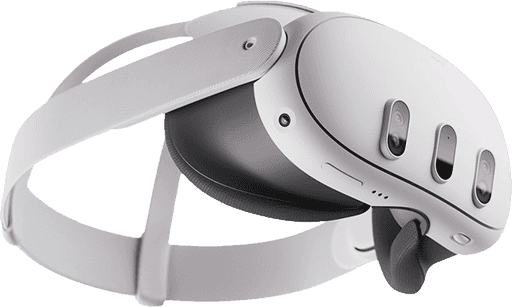
Why VR + Public Speaking?
The fusion of virtual reality and public speaking represents a groundbreaking advancement. now, individuals can confront their speaking anxieties by repeated exposure to virtual simulations of the real-world scenarios they dread. and as their fears are reprogrammed, their skills are also honed, transforming them into impactful speakers ready to command any stage., who is ovation for.
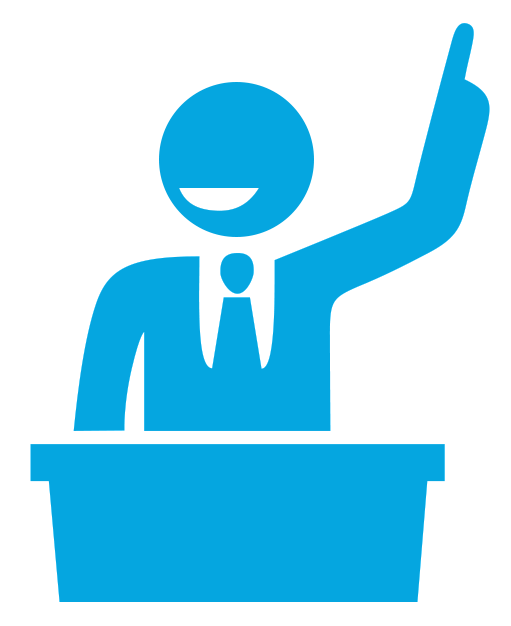
How Ovation Works
Take a closer look at the key features enabling you to elevate your speaking skills., realistic audiences & venues.
Audience members are real people scanned into 3D models. They smile, clap, ask questions, and get distracted by their phones. An ever-expanding collection of venues includes conference halls, classrooms, and boardrooms — all based on real-world locations.
Endless customization.
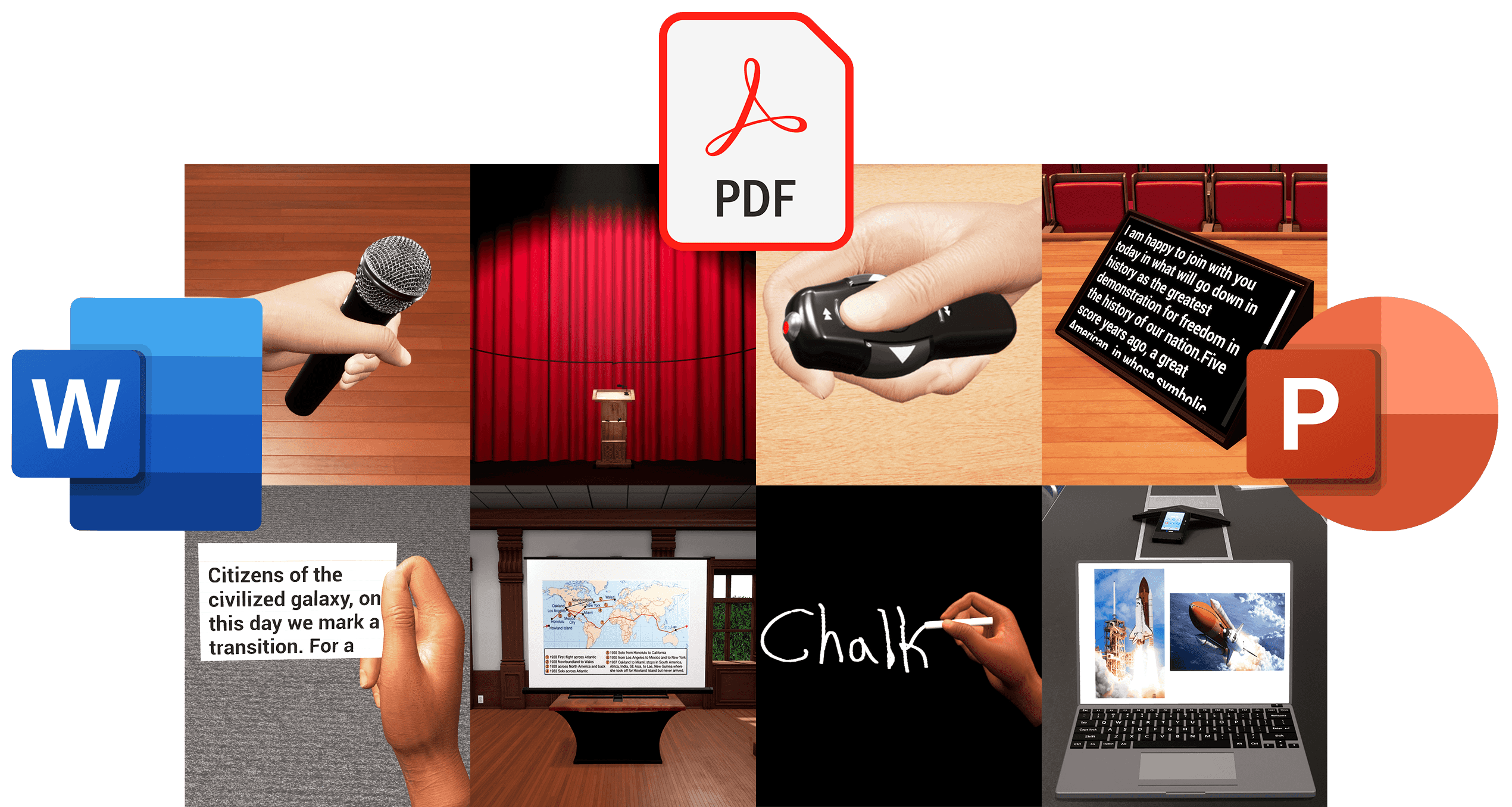
Import your own text, slides, and slide notes. Choose from dozens of interactive speech tools, including laptops, microphones, laser pointers, and projector screens. Adjust your audience's attire and attitude.
Ai-powered speaking scenarios.
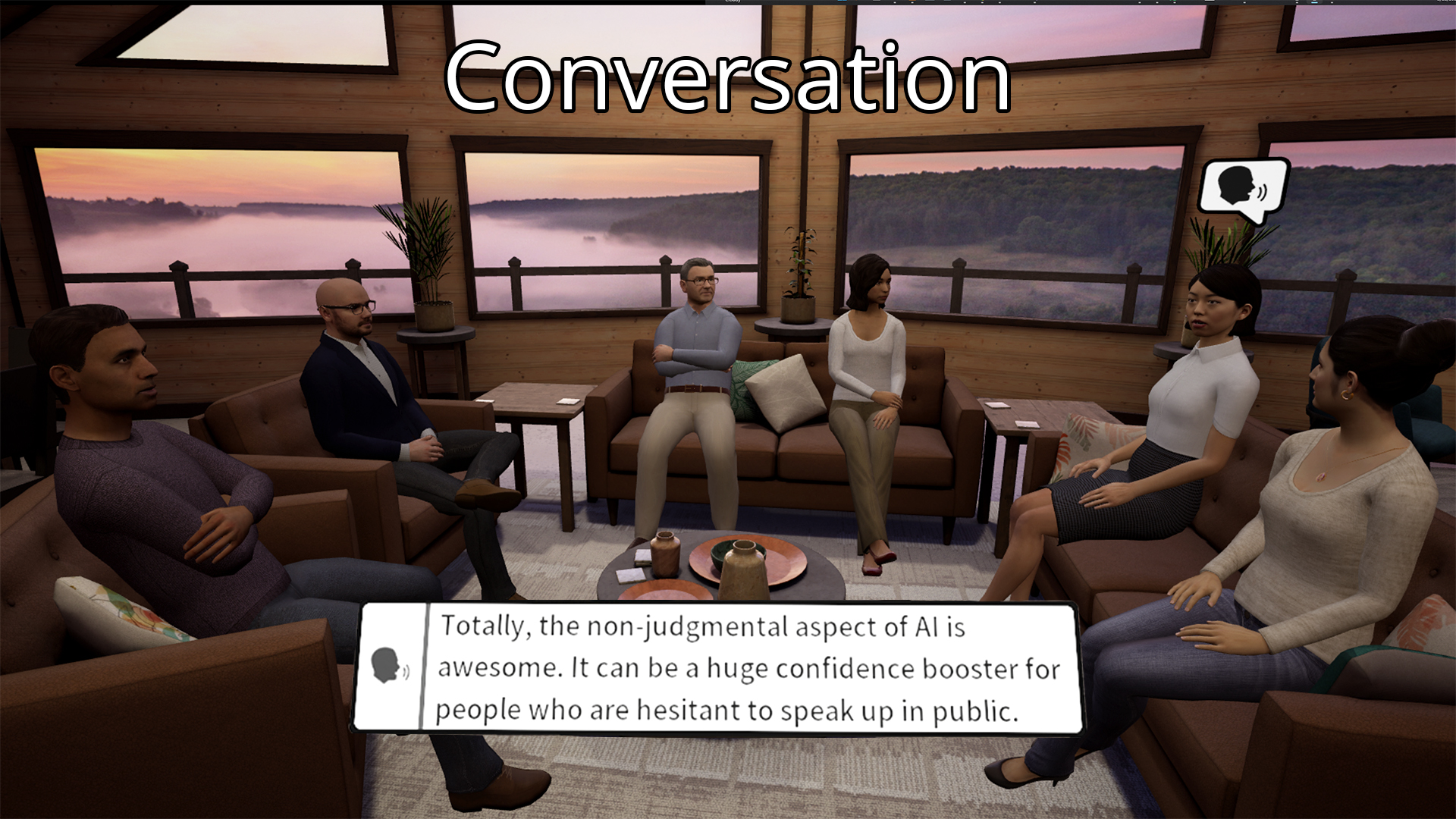
Ovation‘s simulated audience members can engage in intelligent dialogues, powered by OpenAI‘s ChatGPT and ElevenLabs. Speech + Q&A: Deliver your presentation then answer questions about it. Conversation: Choose any topic and discuss it with simulated participants. Interview: Prepare for any job interview in any industry. Alternatively, be the interviewer and evaluate AI applicants.
Real-time training, your performance is evaluated as you speak, with notifications informing you the moment you say a filler word, stare at one side of the audience, fail to gesture, and more. see ovation's training in action., recording & playback, practice sessions are recorded in 3d, enabling you to watch your performance from every angle and identify areas for improvement., ai-powered feedback & analytics.
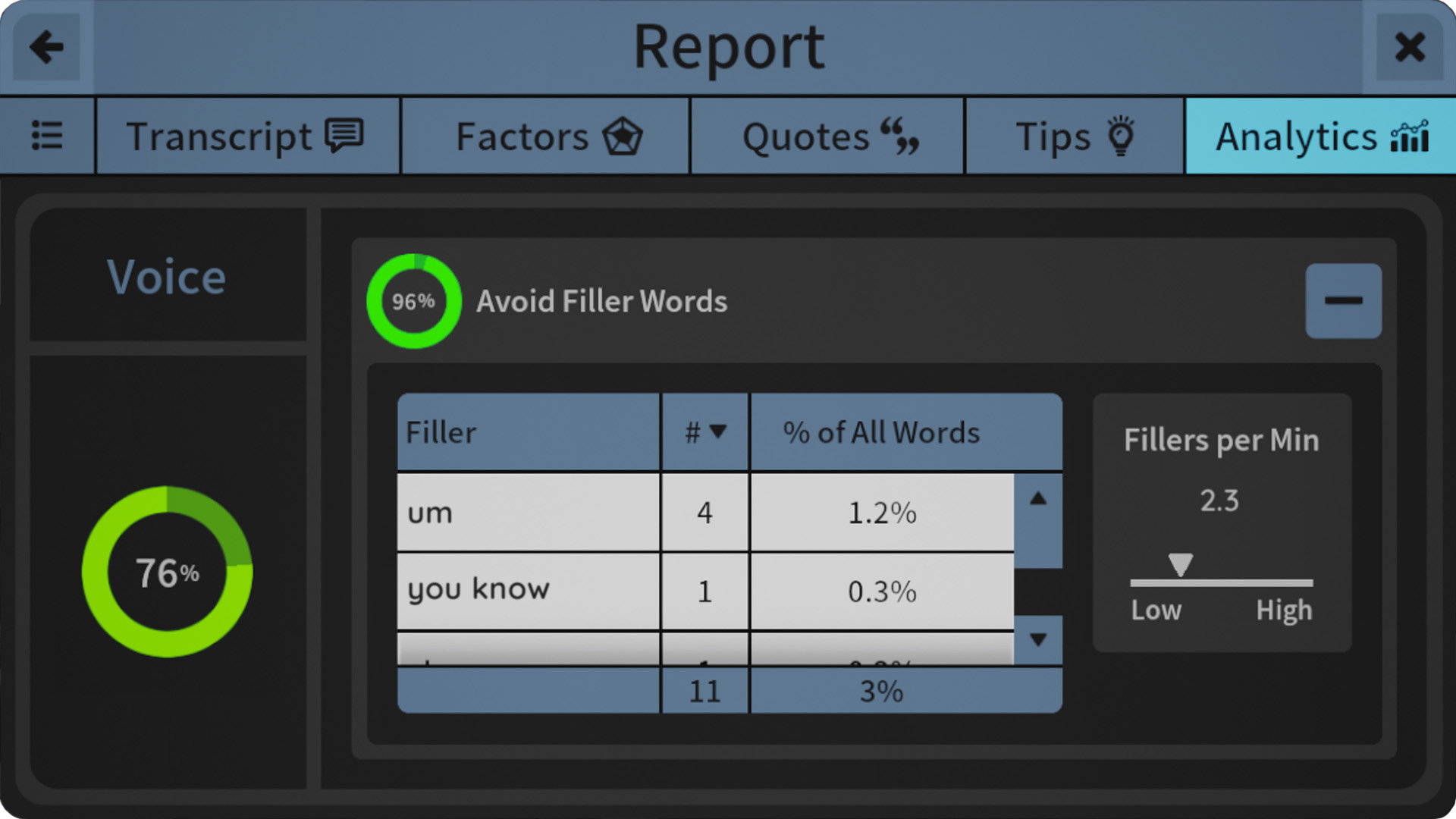
Each performance is evaluated by ChatGPT‘s latest model, providing insightful feedback to help you improve. Full transcripts are available in the app and downloadable on the web.
Multiplayer, meet up with others virtually in ovation, no matter where you are. practice a group speech with classmates, rehearse a meeting with a colleague, or get guidance on your keynote from a professional coach., designed for wireless vr, ovation is compatible with meta quest 2, quest 3, and quest pro headsets. if you already own a compatible headset, visit ovation's meta app store page to add ovation to your app library..
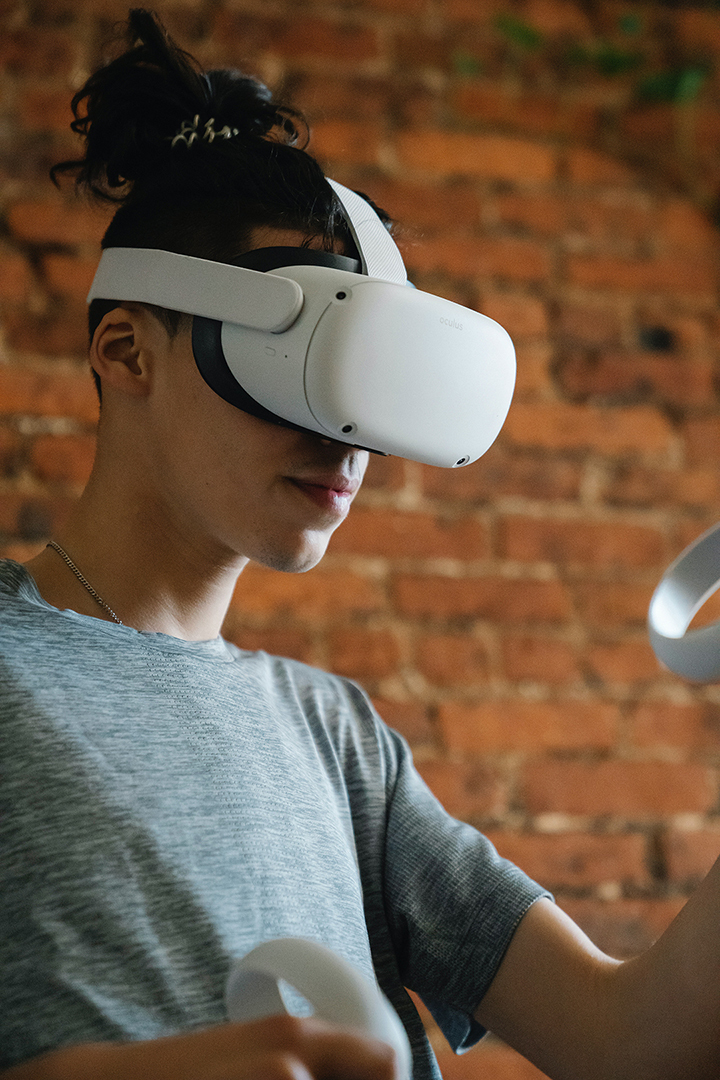
No VR headset? No problem!
Ovation is available for windows-based computers with our monitor application. if you prefer not to use vr, or want to try ovation before investing in a headset, this is a great option..

“As an executive communications and public speaking coach, I was looking for a VR platform to add to my suite of client services. And I was so impressed by the capabilities of Ovation that I decided to integrate it into my offerings to better serve a growing roster of clients, especially those who struggle with public speaking anxiety.“
Douglass Hatcher

“I've tried different public speaking apps and this one blows away the competition. For starters, the graphics are unrivaled. The feedback the app offers after a speech is invaluable if you're trying to improve your public speaking. I've also used this app as preparation for Toastmasters speeches and the crowd could not believe my progress.“
Luis Rancel
“As a professor and a privileged beta tester, I can confidently say that this app is a complete game-changer in my classroom. When it comes to presenting in front of a live audience (after using Ovation), my students report increased confidence and the ability to captivate listeners by delivering truly impactful presentations.“
Professor Kim Hyatt

Sign up to receive the latest news from Ovation, including software updates, tips, events, and more.
Stay connected on social media.
A quick note about our cookies
We use cookies so we can give you the best website experience possible and to provide us with anonymous data so we can improve our marketing efforts. Read our cookie policy and privacy policy.
Login to your account
New here? Sign up in seconds!
Use social account

Or login with an email
Create an account
Already have an account? Login here
Or sign up with an email

We’re uploading new templates every week
We’d like to send you infrequent emails with brief updates to let you know of the latest free templates. Is that okay?

Reset your Password
Please enter the email you registered with and we will send you a link to reset your password!
Check your email!
We’ve just sent you a link to . Please follow instructions from our email.
- Most Popular Templates
- Corporate & Business Models
- Data (Tables, Graphs & Charts)
- Organization & Planning
- Text Slides
- Our Presentation Services
Get your own design team
Tailored packages for corporates & teams
Virtual Reality PowerPoint Template
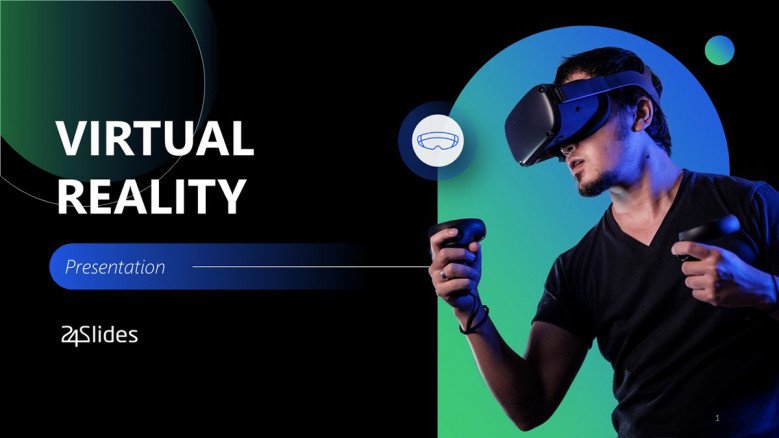
Number of slides: 10
A virtual reality (VR) PowerPoint template for professionals that want to share the latest trends in VR for education, VR for work, VR games, and interactive experiences. You’ll be able to showcase key findings, descriptions, data, and more in a simple manner to make VR accessible for everyone. With a sleek design and professional look, the virtual reality PowerPoint template is excellent for sharing your views with people interested in what’s coming for VR in business.
- About this template
- How to edit
- Custom Design Services
Free VR PowerPoint Presentation
What is vr slide.
Virtual reality may be the future of technology. This PowerPoint template will help you introduce people to virtual reality (VR). You’ll be able to guide your audience through the basics of virtual reality and help them understand why it is so important.
Virtual Reality for Education
Virtual reality helps teach students by immersing them in a situation through visuals and sounds. In this slide, you can give an overview of the status of VR in education and add relevant examples from your country.
Virtual Reality in Business
Virtual reality also has the power to revolutionize business meetings. With innovative technology, a company can hold immersive meetings through VR, which can be effective at communicating ideas, managing projects, and solving problems.
VR icons in PowerPoint
The virtual reality PowerPoint template has little line icons to enhance your content. Simply drag and drop the VR icons on your slide and start using them as visual aids.
Future of VR
The Virtual Reality Slide Deck is designed to showcase and discuss trends in the future of Virtual Reality. Present your information in a data-driven line chart that will catch the eye of executives
Virtual Reality images
The VR PowerPoint template includes VR stock images that will help you share your visualization and ideas in an immersive way
FIND OUT MORE ABOUT OUR CUSTOM DESIGN SERVICES
Todd Speranzo
VP of Marketing at Avella
"24Slides helps us get PowerPoints on-brand, and improve overall design in a timeframe that is often “overnight”. Leveraging the time zone change and their deep understanding of PowerPoint, our Marketing team has a partner in 24Slides that allows us to focus purely on slide content, leaving all of the design work to 24Slides."
Gretchen Ponts
Strata Research
"The key to the success with working with 24Slides has been the designers’ ability to revamp basic information on a slide into a dynamic yet clean and clear visual presentation coupled with the speed in which they do so. We do not work in an environment where time is on our side and the visual presentation is everything. In those regards, 24Slides has been invaluable."
"After training and testing, 24Slides quickly learnt how to implement our CVI, deliver at a high quality and provide a dedicated design team that always tries to accommodate our wishes in terms of design and deadlines."
What's included in Keynote Template?
I want this template customized class="mobile-none"for my needs!
69 beautifully designed slides 67 icons included PowerPoint and Keynote ready 16:9 full HD class="mobile-none"resolution
Check out other similar templates
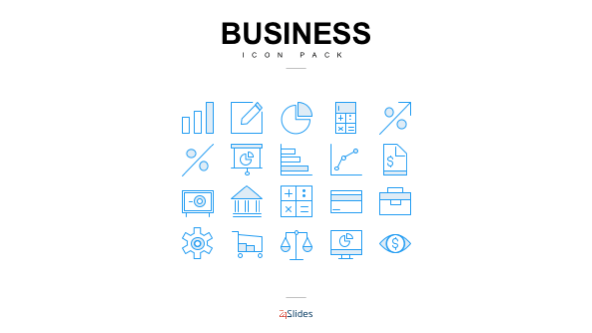
Presentation Business Icons
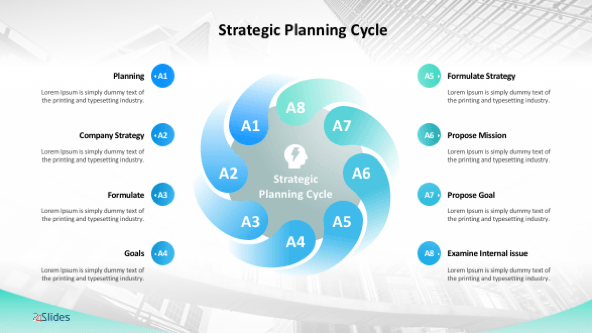
Management Strategy PowerPoint Template
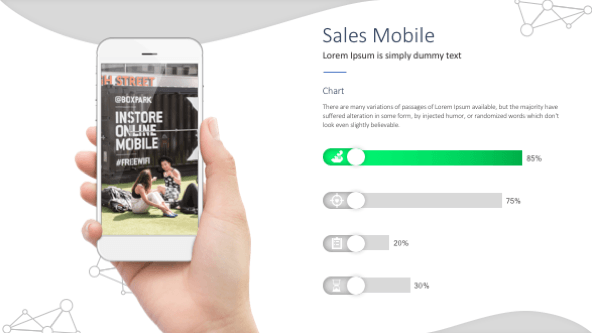
Mobile Sales Slides Template
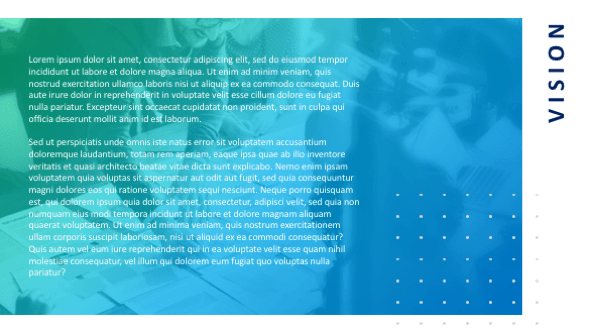
Pitch Deck Presentation Templates
- Hispanoamérica
- Work at ArchDaily
- Terms of Use
- Privacy Policy
- Cookie Policy
The Complete Guide to 360 Panoramas for Immersive Client Presentations
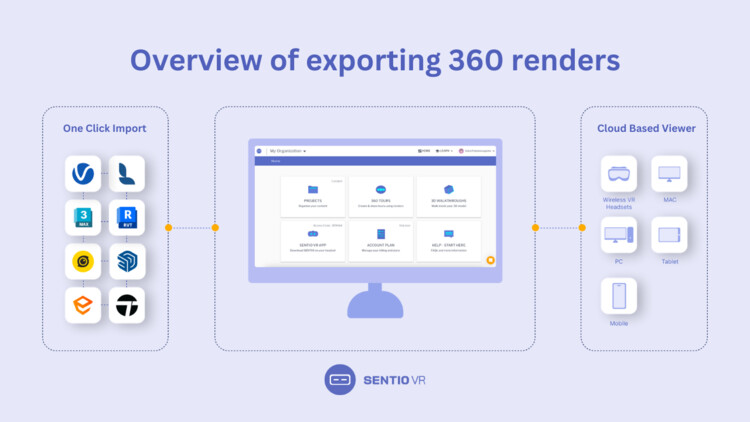
- Published on March 29, 2024
In the world of architecture and design, traditional methods of showcasing 3D designs via 2D floorplans, renders and video walkthroughs are standard practices. However, they lack one important thing: immersion. For clients, it is hard to visualize spaces by looking at 2D representations. This has led to a need to quickly create immersive environments that clients can understand better from existing 3D software like Enscape, V-Ray, Lumion or Twinmotion.
Using 360 panoramas, architects and designers can now bring existing designs into virtual reality (VR) within minutes. This article will serve as a guide on how to convert your 3D designs into lightweight web and VR experiences using 360 panoramas.
How to Create Panoramas?
Exporting 360 panoramas is a simple and direct process across all major 3D software like Lumion, Enscape, Twinmotion, Vray, and Unreal. These tools allow you to export panoramas directly to your desktop in JPG or PNG formats. Unlike standard renders, 360 panoramas provide a full, immersive view, offering a complete visual context of the design.
There are several 3D modeling software and rendering tools, whether they are standalone or plugins, that together are capable of creating high-quality photorealistic panoramas.
Here’s a snapshot of plugins and renders that are most commonly used with detailed tutorials on how to export 360 panoramas for VR experiences:
- Enscape to VR
- Lumion to VR
- Twinmotion to VR
- 3ds Max to VR
What Is the Correct Format for 360 Panoramas?
Choosing the right image format for 360 panoramas is important for ensuring a proper immersive experience. While different software provides different options for panorama formats, Sentio VR supports a wide range of image formats that are a good fit for VR experiences. For example, here are the major formats used for generating panorama-based experiences.
- Spherical images with a 2:1 aspect ratio
- 2. Stereo spherical images with a 4:1 aspect ratio
- Cubemaps with a 6:1 aspect ratio
- Stereo cubemaps with a 12:1 aspect ratio
Files should be in JPG, JPEG, or PNG formats.
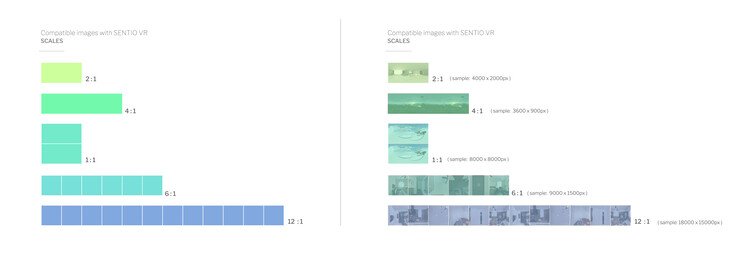
How to View 360 Panoramas on the Web?
One benefit of working with 360 panoramas is that they are very easy to share with clients. The output is a shareable link that you can view across all devices for reviews or even embed within your website. Since all clients and firms do not have VR headsets yet, this is a great way to showcase immersive presentations that go beyond traditional 2D drawings or renders.
Sharing a web link for immersive presentations is a simple 4 step process:
- Export the panorama from your desired rendering softwares to your local PC
- Drag-and-drop your 360 panoramas in Sentio VR
- Edit your virtual tour and create a shareable URL
- View in web from any anywhere on PC, mobile or tablets

How to View Panoramas in VR Headsets Like Meta Quest?
Experiencing high-quality 360 panoramas in a VR headset like Meta Quest 3 offers a completely immersive experience for clients, providing a spatial understanding that is hard to achieve in 2D. Customers can look around the entire space, switch images, and interact with floor plans, audio and video hotspots in order to provide accurate feedback early in the design review process, saving time and rework costs. To view your previously uploaded panoramas:
- Install and download Sentio VR app for Meta Quest
- Note down a 6 digit access code unique to your account
- Select a 360 tour to experience in VR
Additionally, you can also invite other stakeholders to review in real-time for remote presentations or cast your VR view to a screen for in-person meetings. For meetings with unreliable internet, you can download the panoramas for offline viewing, ensuring a complete presentation platform that fits your firm's requirements.
In conclusion, elevating your presentation workflow to include 360 panoramas in addition to 2D images has huge benefits for improving client engagement and saving rework. By using a 360 virtual tour software like Sentio , you can easily create these presentations that can be shared on PC, mobile and tablets, while also bringing in fully immersive experiences using wireless VR headsets like Meta Quest. With advanced workflows like virtual tour editor, multi-user collaboration and offline viewing, it requires very little training to get started with incorporating VR into your design review and presentation workflow.
Want to try immersive client presentations? Try 14 Days free Trial at Sentio VR
- Sustainability
世界上最受欢迎的建筑网站现已推出你的母语版本!
想浏览archdaily中国吗, you've started following your first account, did you know.
You'll now receive updates based on what you follow! Personalize your stream and start following your favorite authors, offices and users.
- Content Types
Presentations Keep your audience engaged.
Documents Formalize your branding.
Videos Add movement to your brand.
Infographics Share information visually.
Whiteboards Brainstorming, plan, and design.
Charts and Graphs Bring life to your data.
Social Media Graphics Create scroll-stopping content.
Forms & Surveys new Visual forms that convert.
Mockups Create high-quality mockups in seconds.
Printables Create content for printing.
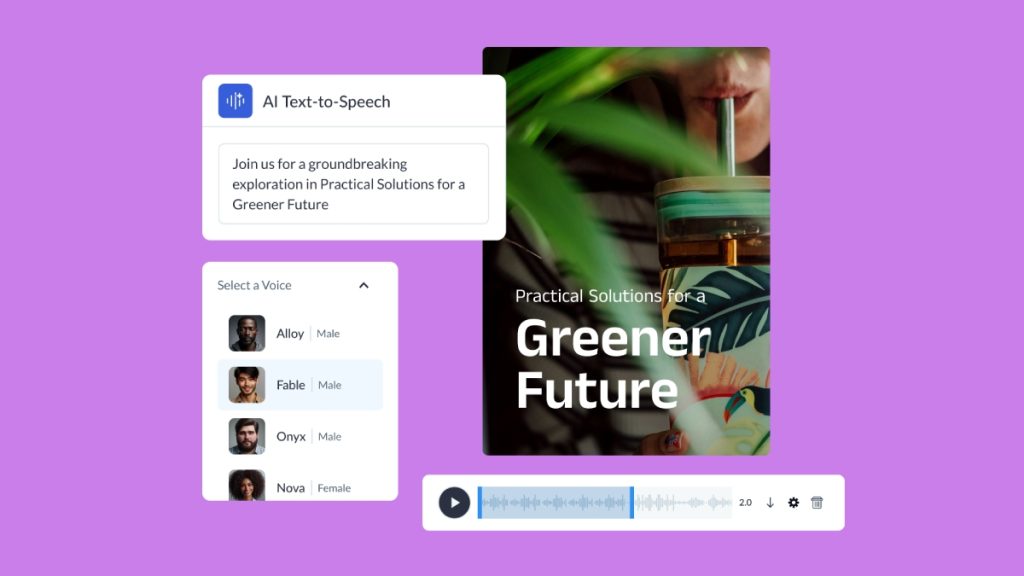
- Features & Assets
AI Designer
Interactivity
AI Image Generator
Integrations
Data Widgets
Collaborations
Social Scheduler
Branded Templates
Presenter Studio
Free Educational Resources See All
Visme Video Tutorials Watch videos on how to use Visme.
Ebooks Read in-depth knowledge for your industry.
Graphic Design Videos Learn design principles & best practices.
Live Webinars Interact with the experts live.
Free Online Courses Get certified with free online courses.
Our Blog See All
- Presentations
Video & Animations
Digital Marketing
Infographics
Design for Business
Data Visualization
Design Inspiration
For Work All Teams
Agencies & Consulting Manage multiple brands.
Education Use Visme in the classroom.
Nonprofit Bring life to your cause.
Enterprises Create visual content at scale.
- Perfect For These Roles
Marketers Creative content that shines.
Human Resources Improve internal communication.
Sales Teams Close more deals with your content.
Training Development Create interactive training content.
Templates See All
Presentations 1000+ layouts and themes.
Chart & Maps Get data visualization ideas.
Social Media Graphics Browse templates for every platform.
Infographics Find the right format for your information.
Documents Templates for every business document.
Videos & GIFs Find the perfect preanimated template.
Branded Templates Get a bundle of templates that match your brand.
Forms & Surveys new Forms for engagement and conversions.
- Other Templates
Website Graphics
Survey Results
Case Studies See All
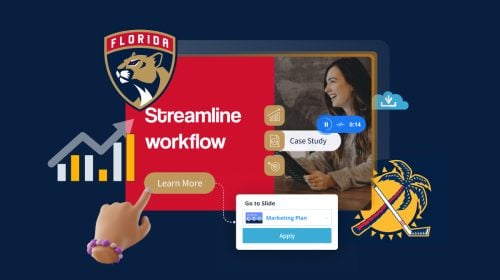
How the Florida Panthers Maximize Their Workflow & Win New Clients Using Visme
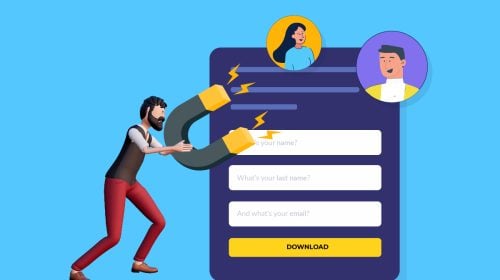
Converting More Leads from Existing Traffic with Visme’s Interactive Form Builder
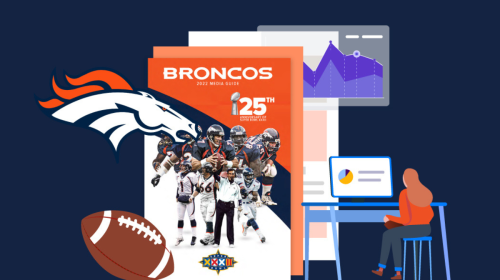
How the Denver Broncos Use Visme to Visualize Data, Execute Strategies & Wow Partners

How a Consultancy Uses Visme to Create Engaging Client-Facing Content
Created with Visme See All
Infographics / Data Viz
Document / EBooks
Forms / Surveys
- Request a Demo
- Sign Up Free
- Free Educational Resources
Virtual Reality Presentation Template
Use this presentation template to educate your audience on the key elements and components of virtual reality..
Use the professional design, monochromatic color scheme and visuals present in this template to produce high-quality content and interactions with your audience.
This presentation template can help you give an idea to your audience of what it is like to use VR. You can also use it to present the latest updates, gadgets and more.
- Change colors, fonts and more to fit your branding
- Access free, built-in design assets or upload your own
- Visualize data with customizable charts and widgets
- Add animation, interactivity, audio, video and links
- Download in PDF, PPTX, MP4 and HTML5 format
- Share online with a link or embed on your website
Make your virtual reality product a success with this engaging presentation template, or browse through other ready-to-use presentation templates to find the design that suits you.
Edit this template with our Presentation Software
Template Specifications
17 Slides, 1366 x 768 pixels – 16:9 Aspect Ratio (HD Presentation Quality)
Customizable
This template can be fully customized. You can edit content, change image(s), apply custom colors, input your own fonts and logo, and more.
Download as a PDF to share with your recipient or generate a shareable link for online sharing.
Compatibility
Related tags.
- presentations
- presentation
- slide decks
Explore other presentation themes
Create your Presentation using thousands of gorgeous slides in 20+ content categories.
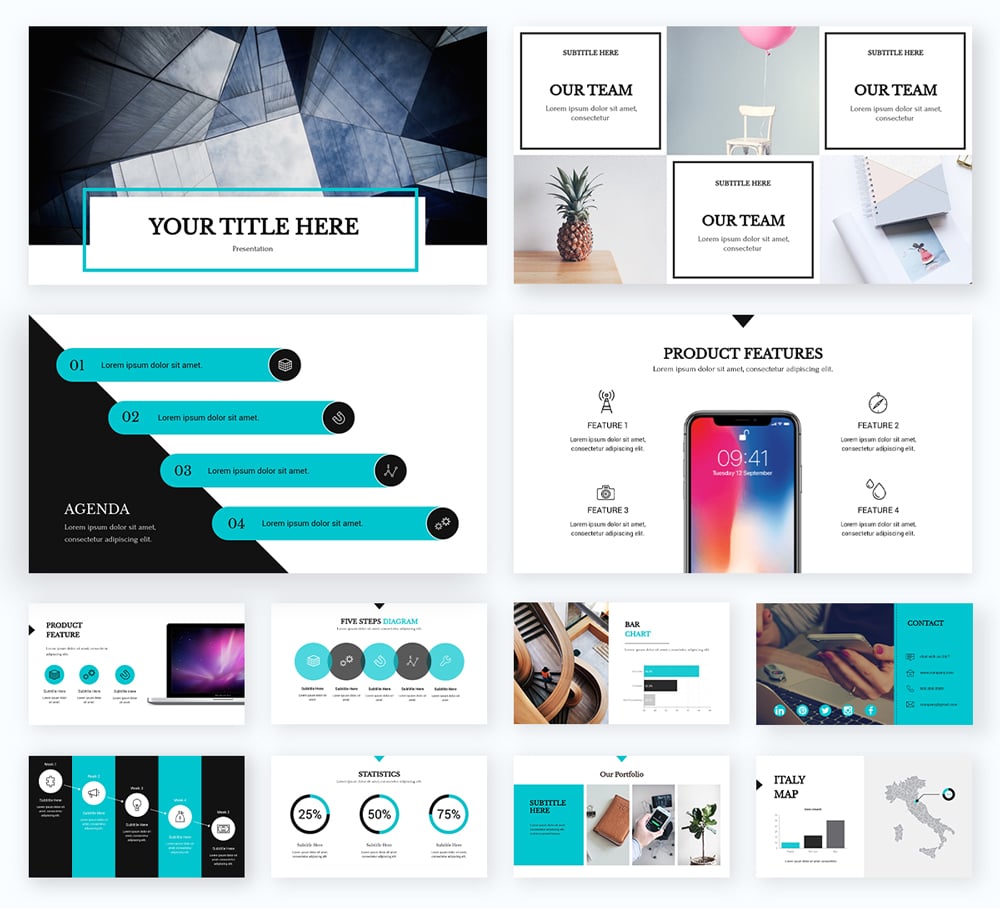
More like this

Nature Background Presentation
Educate your audience on environmental topics or organic products with this nature presentation template.

Comms Pitch Deck Presentation
Share your creative business ideas with investors using this Intercom-inspired pitch deck template.

Evolution of the Projector Presentation
Communicate to and engage with your audience the right way with this educational media presentation template.

HR SWOT Analysis Presentation
Explore small-business HR with this artistic SWOT Analysis presentation template.

Graphic Design - Webinar Presentation
Give your audience a crash course on graphic design using this colorful webinar presentation template.

Communication Skills - Keynote Presentation
Give a show-stopping presentation on the importance of workplace communication with this modern keynote presentation template.
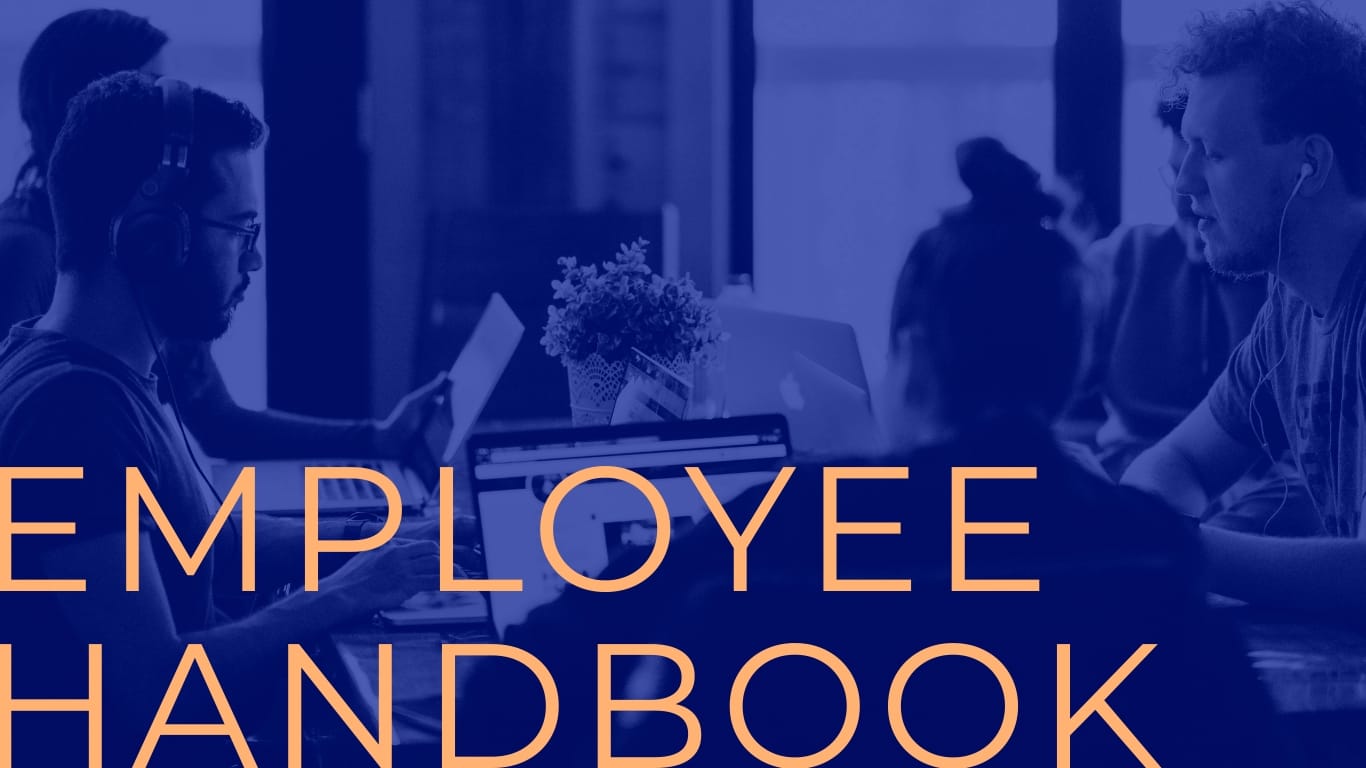
Employee Handbook Interactive Presentation
Transform your employee handbook into a dazzling interactive presentation with this professional interactive presentation template.

Business Case Presentation
Showcase your company's latest case study with this beautiful presentation template.

Risk Analysis Presentation
Walk your audience through conducting a risk analysis with this finance presentation template.

Employee Engagement Presentation
Explain how to boost employee engagement in the workplace using this presentation template.

Business Development Presentation
Create an engaging presentation on your company’s history and showcase its portfolio.

Design Tool Presentation
Use this compelling sales presentation template to highlight your SaaS company and product.

Purple and Black Business Presentation
This all-around, creative business presentation template is a definite head-turner. Get started today.

50 Years After the Moon Landing - Presentation
Design an eye-catching space exploration presentation with this stunning presentation template.

Cybersecurity SWOT Analysis Presentation
Learn about the importance of cybersecurity with this stellar SWOT Analysis presentation template.

Entrepreneurship Webinar Presentation
Reveal the secrets of successful entrepreneurship using this vibrant keynote presentation template.
Free Presentation Templates by Visme
Marketing is all about communication, yes - but it's also about making the best possible impression on your target audience. What you're saying is important, but how you choose to say it is equally so. You can only make one first impression, so you'd better make it the best one that you can - and now, thanks to Visme's presentation templates, it's easier than ever to do precisely that.
Loaded with countless stunning, versatile and totally customizable presentation templates , Visme's presentation software makes it possible to design the engaging, creative collateral that you need without requiring years of design experience under your belt. Visme offers presentation templates for every conceivable industry that you're a part of, making sure that the tools are always available to guarantee that your audience will pay attention to your every word.
Our presentation templates are equal parts colorful, visual, vivid and attractive - but they're also easy to use and even easier to edit, as well. These presentation templates also come with a massive number of free stock images for you to use, guaranteeing that you'll always be able to broadcast your message in exactly the right way at exactly the right moment in your relationship with your audience.
Create Your Presentation
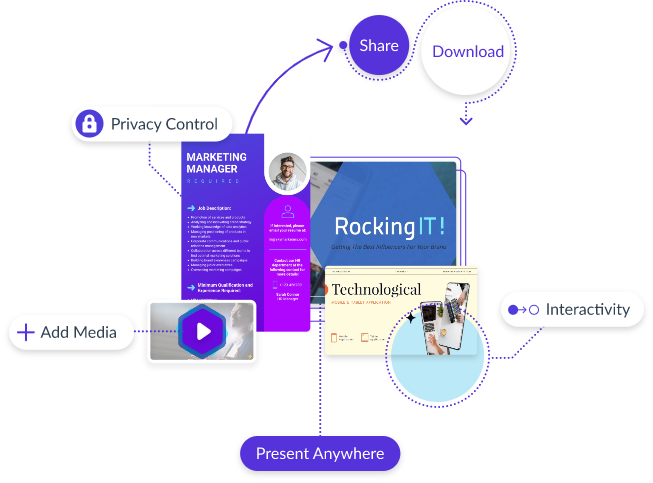
This website uses cookies to improve the user experience. By using our website you consent to all cookies in accordance with our cookie policies included in our privacy policy.
How to Build + Host Your First VR Presentation
Use our sample assets and see how easy it is to create your first Vizible VR Presentation, then invite others to a session for communication and collaboration in VR.
Getting started with Vizible is easy. This quick tutorial will show you how to download and install Vizible, build a simple VR presentation, and then host a VR "session", a multi-user gathering in virtual reality. All of the downloads you need are included below, and they're all free.
If you'd like a longer, more detailed introductory tutorial, check out this video .
Contact us if you are interested in a free evaluation copy of Vizible
1. Downloads
One step of the installer asks how you're using Vizible. Keep "creating virtual reality experiences" selected.
Once installation is complete, download the Sample Asset pack here and unzip the Sample Asset folder. You can use your own assets too, but this way you'll have some sample assets ready to go.
2. Open Vizible Presentation Designer and Create a New Blank Presentation
Open up Vizible Presentation Designer, create an account if you haven't already, and log in with your Vizible credentials. At the top, head to "New Scenes" and then double-click on "Blank Scene".
3. Bring Assets Into Your Presentation
Assets you can bring into Vizible include 3D models , documents , images , photospheres , videos , videospheres , sounds , and more. Feel free to supplement the presentation you make here with Assets of your own. To keep things simple for this tutorial, we're just going to use a few 3D models. Open the Starter Pack of Assets you downloaded earlier and drag the "Modern Lobby" file into the Asset Library at the bottom of Presentation Designer.
Then, go to the bottom of your Asset Library and drag the Modern Lobby Asset into the Scene View in your Presentation. Do the same with the HTC Vive or other Assets. Once Assets are in your Slide, you can move them around, rotate them, scale them, and do a whole lot more that you can learn about in the rest of the documentation.
Just so you know, the bar at the left of Presentation Designer is the Slide View. For the sake of simplicity, the Presentation we are making only has one Slide and just a few Assets. Keep in mind that presentations can have as many Slides as you want, with as many Assets as you want.
Later in the documentation, you'll see how to add interactivity to your presentation with sensors, set actions like animations, create + embed avatar recordings, set user viewpoints, and much, much more.
4. Start a Session
Click the "Sessions" button at the bottom left of Presentation Designer to open the Sessions tab, and and then click the plus button to start a session. The start time will be set to the present time, which is fine since you'll be experiencing it in no time. Give it a name and then click "Add Session". You'll see your session appear in your session list.
Copy the Session ID. The Session ID is what you and those you invite can use to access and experience your Vizible Presentation.
If meeting inside your Vizible Session with others, you'll see each other as avatars and can interact with each other and the virtual environment for real-time communication, collaboration, and shared experiences.
Tip: to make it super easy to invite others, you can send a handy, contained invitation to your Vizible session by right clicking on the Session in the Sessions tab of Vizible Presentation Designer, clicking "copy invitation text", and then pasting the invitation into an email. The invitation will include the Session ID and a link to download Vizible Attendee. There are the only two things someone needs to experience a Vizible Presentation.
6. Experience Your Presentation
Open up Vizible Presenter, put in the Session ID and your Vizible log-in credentials, make sure your hardware is set up properly, and start the session. On the device dropdown, you can select your hardware (Vive, Rift, Desktop PC, VR Projection System, etc).
See how to access the menu and enable various tools by looking at your wrist and tapping the menu button. Here's a look at the laser pointer and the pencil.
One of the tools you have available is the Presenter Tool. When experiencing your Presentation in Vizible Presenter, you can use this tool navigate through the Slides in your Presentation to drive the experience however you want to, with the ability to skip ahead, revisit anything you want, or even let other participants decide the path with triggers that you place throughout the virtual environment.
There you have it! You've created and experienced a Vizible VR Presentation. We're only scratching the surface of what you can do with Vizible, though. Read on in the documentation to learn more!
Note: If you want to skip over the info about the Web Dashboard and start deep diving into Vizible Presentation Designer, go here .
Sign up for the WorldViz newsletter to stay on top of product and company updates.

Virtual Orator
What is virtual orator.
Virtual Orator ® is a revolutionary new technology for training public speaking skills. Maximize your training benefits, by practicing in the same situation for which you are training: speaking in front of people. Virtual Orator is a virtual reality simulator that creates the sensation of being in front of an audience.
Practice where, when and as often as you need. No more forcing your family, friends, or coworkers to endure five rounds of practice presentations. Our virtual audiences will take their place. Adjust the venue, audience size and behavior to fit your training needs; from starting out with a fear to perfecting that important presentation, Virtual Orator provides the right speaking experience for every need.
Practice in a variety of venues. Pick a space similar to where you will present, so you can ‘own’ the stage when you step in front of the audience. Or, Pick a venue and audience to challenge yourself.
Every time you start Virtual Orator, we invite a randomized audience. You choose the size of the crowd and their general behavior, from friendly to distracting and disinterested. Our software creates realistic situations, and our proprietary AI makes the virtual humans behave accordingly.

OVER-COMING Fear
A fear of public speaking is said to affect 70% of all people. Practicing speaking in front of people is universally viewed as the best way to overcome fear . Virtual Orator provides a safe and realistic way to experience public speaking.

Training Skills
Public speaking is craft, composed of many skills. They need to be trained and maintained, so on the big day you can use those skills. Virtual Orator provides a platform to train speaking skills and mechanisms to support that training.
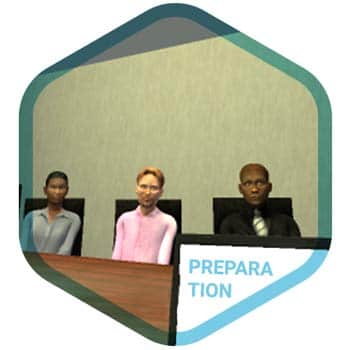
Preparing & Honing
Prepare to speak in public . Even experienced speakers can hone presentations by practicing. With a realistic audience and setting practice is more effective. Rehearse your slide presentations. Challenge yourself with a hostile audience in a distracting environment.
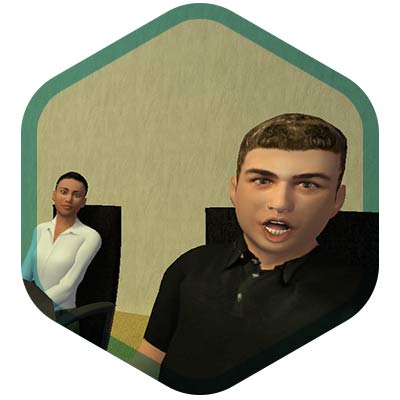
Testing public speaking skills can’t typically be done realistically, til now. Evaluate progress by repeating similar experiences and with objective feedback. Test the speaking skills of potential employees, before you hire them. For instance, sales reps can be tested in a realistic situation, with questions and interjections appropriate to your sales environment.
Realistic Audiences
Your presentation experience is real. Our Virtual Humans to simulate real speaking situations. Select audience types to fit your needs.
Presentations Aides
Practice with your notes or slides. Slides are projected in all venues that support it. A laptop displays the slides in front of you.
Practice Often
Practice as often as you need. Audiences attend your talk each time, as if it was the first time. Randomized audiences and behavior. Don’t get bored, speak about randomized impromptu topic.
Audience Questions
Trainers can record questions and interjections to be included in the virtual scenario. These can then be triggered at appropriate moments and will be spoken by a member of the virtual audience.
Choose a Venue
Practice in a venue that is similar to where you will be giving a speech. Challenge yourself in a larger venue with more people.
Virtual Orator includes an integrated ability to record the environment, a webcam, or both. Ideal for reviewing how you did or sharing with a off-site trainer.
What our users are saying
I’ve tried several other apps, but Virtual Orator is the only one that I feel can really simulate the fear setting and make me improve. Steven S.
Prior to Virtual Reality Exposure (VRE), many clients had difficulty staying focused on the triggers associated with making speeches in front of audiences. With Virtual Orator, I have patients make 1- to 2-minute speeches with the Oculus Rift headset on, and it immediately triggers their fear responses. Dr. Rick Bradshaw
I’ve been using your program for about a week now. I’m really loving this… Believe it or not, I think it’s helping me already in real situations. Luis R.
Clients & Partners

Recent on the Blog
The Virtual Orator is a blog about Public Speaking and VR. Get tips and tricks. Learn ways to improve your skills. Get more out of Virtual Orator. Some of our recent posts:

Privacy Overview
| Cookie | Duration | Description |
|---|---|---|
| CONSENT | 2 years | YouTube sets this cookie via embedded youtube-videos and registers anonymous statistical data. |
| _ga | 2 years | The _ga cookie, installed by Google Analytics, calculates visitor, session and campaign data and also keeps track of site usage for the site's analytics report. The cookie stores information anonymously and assigns a randomly generated number to recognize unique visitors. |
| _ga_F908KXVK0M | 2 years | This cookie is installed by Google Analytics. |
| _omappvp | 11 years | The _omappvp cookie is set to distinguish new and returning users and is used in conjunction with _omappvs cookie. |
| _omappvs | 20 minutes | The _omappvs cookie, used in conjunction with the _omappvp cookies, is used to determine if the visitor has visited the website before, or if it is a new visitor. |
| Cookie | Duration | Description |
|---|---|---|
| VISITOR_INFO1_LIVE | 5 months 27 days | A cookie set by YouTube to measure bandwidth that determines whether the user gets the new or old player interface. |
| YSC | session | YSC cookie is set by Youtube and is used to track the views of embedded videos on Youtube pages. |
| yt-remote-connected-devices | never | YouTube sets this cookie to store the video preferences of the user using embedded YouTube video. |
| yt-remote-device-id | never | YouTube sets this cookie to store the video preferences of the user using embedded YouTube video. |
| Cookie | Duration | Description |
|---|---|---|
| wp-resetpass-e82ca3ca43e2d6d226311dd676bf6d2e | past | No description |
| _bit | 5 months 27 days | No description available. |
| _monsterinsights_uj | 1 year | No description |
Thank you for contacting us. We’ll reply to you as quickly as we can.
12 virtual presentation tips to get your audience’s attention

Delivering an effective virtual presentation is no easy task.
Whether it’s for pitching to potential clients or discussing project goals with your team, you’ll have to compete for your audience’s attention and ensure your message gets through.
In this article, we’ll cover the top 12 virtual presentation tips and best practices for your next virtual meeting. We’ll also look at some of the key benefits of virtual presentations.
This article contains:
(Click on the links below to jump to a specific section)
- Research your Audience Well in Advance
- Be Vigilant with Technical Checks
- Embrace the Use of Technology and Visual Aid Tools
- Start with an Agenda in Mind
- Reduce and Eliminate Distractions
- Stick to Short, Punchy Sentences
- Interact with your Audience
- Pace Yourself and Plan for Delays
- Incorporate Back-Up Systems
- Allot some time for Q&A Sessions
- Know When to Stop
- Reach Out for Feedback and Reflect
- 3 Useful Benefits of Virtual Presentations
Let’s begin!
12 practical tips for your next virtual presentation
Virtual presentations can be intimidating for someone just starting out with them.
But don’t worry.
Here are some practical tips and best practices to ace your next virtual presentation.
1. Research your audience well in advance
With virtual presentations, you need to do a little more research than you’d usually do. It’s best to know your audience and their expectations from the presentation.
For a webinar or similar events, you can create a registration page or an electronic submission form a week in advance.
Collect general information about who’s attending the event; ask questions about what they expect to gain from the meeting, or if they have any pressing questions.
If you’re giving an office presentation, you can set an agenda for the concepts you’ll be covering. For example, think about what your keynote will be.
Seek input from team members about your presentation structure and prioritize the action items that need to be addressed. If possible, send your meeting agenda in advance and have your managers/seniors glance through the key points.
2. Be vigilant with technical checks
You cannot control an unexpected power-cut or internet connectivity issue no matter how much you prepare. So, your best bet is to be super precise with technical checks.
Here are some things you should consider:
- Is your camera working? Can the audience see you clearly?
- Do you have a proper mic and speaker installed?
- Are you well-versed with the tools you’ll be using? For example, can you switch between google slides or enable screen sharing?
These are some questions you should ponder over.
Most importantly, make sure you have solutions for any last-minute technical glitches. Prepare to have a backup or appoint someone who can handle the IT.
3. Embrace the use of technology and visual aid tools
The entire concept of a virtual presentation is based on the premise of technology. So naturally, you want to make good use of as many tools as possible.
You can use Canva to create a Canva QR code , Microsoft Powerpoint, Google slides, etc., to create an interactive presentation .
You can also integrate your virtual meeting software with various tools for better audience engagement during the presentation. For example:
- Tools like Zoom , WebinarNinja, etc, let you conduct virtual polls and quizzes during video conferencing.
- You can also use a tool like Poll Everywhere to create word clouds in real-time.
- Online game tools like Kahoot are great for creating group quizzes.
- Zoom or ClickMeeting can be useful as a whiteboard tool .
Another advantage of being well-equipped with the right tools is having better control over your audience. Virtual presenter tools can help with audience engagement. You can also monitor any distractions and eliminate them.
For example, virtual presenters can mute an audience member due to disturbances or pin an important comment for everyone to see.
4. Start with an agenda in mind
In virtual meetings, if you do not start out with an agenda in mind, you’re setting yourself up for distractions.
A good rule of thumb is to prepare a chronological list of things to be achieved during the presentation. What’s the most important concept you need to cover? Take notes, and make sure that all your other points transition back to your main concept and flow with the structure.
Next, try to simplify your data points. Use visual imagery, gifs, videos, or animations to attract attention to the key points.
Define the outcomes of your presentation, and set a time limit for each goal. For example, if the schedule has four points in total, don’t spend more than 30 minutes on each.
5. Reduce and eliminate distractions
A remote audience is always multitasking between work, so there are bound to be some distractions.
You can brief your audience about these best practices to minimize distractions:
- Everyone stays on mute while the presenter is speaking.
- Instead of directly interrupting the host, people can ‘raise’ their hand on the virtual platform if they wish to speak.
- Request your audience members to limit any distraction on their end. This could be due to background noise, kids, pets, social media, or another family member.
Apart from this, make sure that you run technical checks and prepare for any possible problems. For example, close down all unnecessary tabs if you’ll be using screen sharing features.
On your part, your chats will probably be filled with queries, doubts, or suggestions while you’re interacting with the audience. Instead of getting side-tracked by these chats, it’s a good idea to let a colleague or co-host moderate them for you.
6. Stick to short, punchy sentences
When explaining concepts to a remote audience, you should always stick to shorter, more humorous sentences. That’s because most audiences often tune out after 10 minutes .
Especially in a remote work environment, you have to capture and re-capture your audience’s attention while talking. Shorter sentences are easier to understand. But if it’s your first time being a virtual presenter, you can try these tips:
- Maintain eye contact with the audience (through the webcam).
- Use appropriate hand gestures , facial expressions, and body language.
- If possible, the person presenting should stand up. Set up your webcam accordingly.
- Ensure that your lighting is bright and lively. Make use of natural light for a better virtual background.
Moreover, keep your content prompt and precise. Avoid repetition of points, and do not over-evaluate any concepts. Ideally, do not speak for more than 10 minutes without some form of audience engagement (a story, quiz, or question).
7. Interact with your audience
According to a 2019 Duarte survey , over 68% of people believe that an engaging virtual presentation is more memorable than traditional one-way presentations.
That’s because virtual users have a very limited attention span. It’s fairly easy for them to get distracted, especially if they have to sit through a presentation without any form of interaction.
Interacting with the audience also makes you more ‘human’ in their eyes; you become more relatable. You can also plan your interaction activities in advance.
For example, you can host a quiz or poll or use a whiteboard session every 10 minutes to encourage virtual participation. You can also encourage the use of breakout rooms for audience discussions.
8. Pace yourself and plan for delays
There are little to no social cues to rely on from your audience in a virtual environment. You’ll need to practice and maintain a good pace to not speed through your presentation.
Ideally, rehearse with someone virtually. Take notes of any delay in response you may experience or points that come across as confusing to the attendees.
A remote audience often takes more time to respond. This could be due to technical issues, network delays, or unfamiliarity with the tool. But on your part, you can pace yourself according to your audience.
For example, you’ll need to incorporate longer pauses after questions or slow down your talking speed for better clarity. These changes can be observed during your practice run so that you’re better prepared for your live presentation.
9. Incorporate back-up systems
It’s important to plan for a worst-case scenario while presenting virtually, i.e., if you lose access to the meeting or content. In this case, it’s handy to share your presentation material with a co-host or a moderator.
If you’re giving a video presentation, your co-host can have access rights to the meeting if you accidentally go offline. They can interact with the audience or present the video slides while you go back online.
It’s also a good idea to be well-versed with your content. If you ever face a delay or glitch in your tools, you can always continue presenting the points with the help of a whiteboard.
10. Allot some time for Q&A sessions
When conducting a virtual presentation, it’s good to allot a specific time slot for all the doubts and queries. You can do this before or during the event.
In addition to having your own set of potential questions, inform your audience that you’ll be solving all the queries towards the end of the session.
This serves two purposes:
- Your attendees can pay full attention to the presentation, knowing that their doubts will be cleared towards the end.
- You do not get distracted by stopping and answering questions after every concept.
A Q&A platform like Tribe or BoostHQ can be useful for noting down everyone’s questions. Participants can even ask anonymous questions. This way, all your queries are stored in a single database, and you can run a more organized, distraction-free Q&A session.
11. Know when to stop
Knowing when and how to close a presentation is one of the most important virtual presentation skills you could pick up.
In a virtual event, you are bound to get distracted or carried away, so much so that you may lose track of your points. In that case, you should be precise with how much time you spend on each topic and when you should stop.
Towards the end of the presentation, it’s more productive to be brief and to-the-point and conclude with an informative synopsis. You should properly summarize the conference proceedings, highlight key points, and create a lasting impression on your virtual audience.
Here’s how you can do that:
- Prepare a clear and concise closing statement.
- Include a summary of your main agenda.
- Include a call to action.
- Include a powerful quote/message.
- Allow your audience to stay in touch with you. Consider adding a QR Code linked to your business card to your presentation.
12. Reach out for feedback and reflect
When you’re done with your presentation, a great practice is to reach out to the participants or attendees for any feedback.
If you’re presenting to your office colleagues, you can ask for feedback on your talk. Note down how you can improve, including your content, speech, engagement, or presentation structure.
You can also provide post-presentation support. This could include:
- Extra materials/data to support the topic you covered.
- A brief recap or summary of your presentation.
- Recordings of the online presentation.
- A link to a survey to note the material you could cover in the next presentations, ways you could improve, etc.
Now, let’s take a look at some of the advantages of virtual presentations.
3 useful benefits of virtual presentations
Since the onset of the COVID-19 pandemic, virtual presentations have been the norm for most organizations and companies. They’re more accessible and can accommodate a larger audience.
Here’s how you can benefit from an effective virtual presentation.
1. Higher inclusivity
Virtual presentations offer more room for individuals to collaborate and learn.
In a traditional presentation, most of the audience is limited by their geographical location. Only people who can access the location, and manage the time, can attend.
In contrast, a virtual presentation has no bounds.
People from all over the world can join in at the same time. It’s also highly accessible for people who otherwise wouldn’t attend physically due to health, childcare, or disabilities.
2. More flexibility
Virtual presenters often offer recordings of the event for those who can’t attend. Moreover, you can also choose to keep your camera off while still attending.
This makes it easier to participate in meetings. You also save more time by hosting shorter, more effective presentations.
3. More economical
When you’re virtually connecting with an audience, you use fewer resources than regular presentations. Organizers incur fewer electricity/venue costs, while participants have no travel costs at all.
Virtual presentations also lower the company’s carbon footprint by lowering the number of unnecessary travel trips. They’re a great way to practice sustainable business practices.
Final thoughts
Virtual meetings and webinars often test your public speaking and presentation skills.
You need to plan your presentation design and slide structure, manage distractions, and effectively deliver the content to the audience. You can also make good use of online presentation software to engage your audience better.
Use the tips and tools we covered here to understand how you can deliver effective virtual presentations today.
View a free demo of Time Doctor

Liam Martin is a co-founder of Time Doctor which is software to improve productivity and help keep track and know what your team is working on, even when working from home.
Hiring flexible staff: Everything you need to know
Top 15 ground rules for your team’s virtual meetings, related posts, navigating proximity bias in the age of remote work, 8 strategies that can help optimize remote team structure, no promotions for dell’s work-from-home employees, how remote work is reshaping ireland, the 10 best countries for remote work in 2023, amc and zoom transform movie nights into meeting days.
WWDC 2023 Biggest Reveals: Vision Pro Headset, iOS 17, MacBook Air and More
From its expected AR/VR headset to new Macs to software updates like iOS 17, here's what Apple unveiled at WWDC.

Apple's Worldwide Developers Conference kicked off on Monday with a keynote address showing everything coming to the company's lineup of devices. WWDC has been typically where the company gives us a first look at new software for iPhones, iPads, Apple Watches and Macs. But this year, Apple revealed a bevy of new hardware, too.
The big announcement was the debut of the Apple Vision Pro headset, a "new kind of computer," as CEO Tim Cook put it in the presentation. But with MacBook Air and other Mac hardware announcements -- including new silicon -- as well as software upgrades, no corner of Apple's ecosystem lacked for updates.
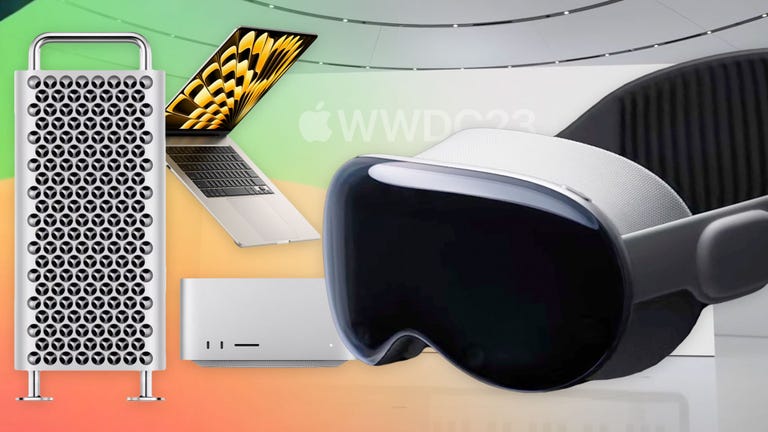
For a detailed summary of everything announced as it happened, give our live blog a look. Read on for the highlights of the presentation and links to our stories.
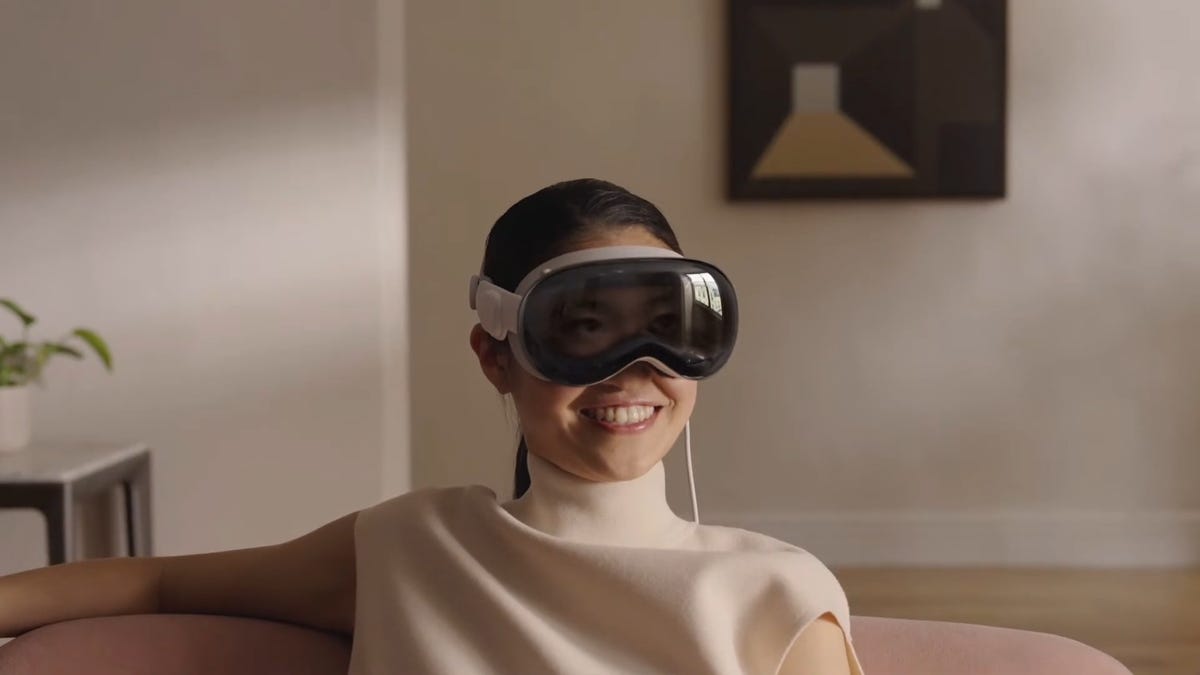
The Vision Pro will cost $3,499.
Apple Vision Pro, a new headset
The Apple Vision Pro is the company's answer to the AR and VR headset race. It's a personal display on your face with all the interface touches you'd expect from Apple, with an operating system that looks like a combination of iOS, MacOS and TVOS. And it's not going to come cheap: The Apple Vision Pro retails for $3,499 and will start shipping early next year, though only in the US.
The device itself looks like other headsets, though the glass front hides cameras and even a curved OLED outer display (more on why later). The headset is secured to the wearer's head with a wide rear band (an over-the-top strap is optional), though as rumors suggested, there's an external battery back that connects over a cable and sits in your pocket. There's a large Apple Watch-style digital crown on the right side that lets you dial immersion (i.e. the outside world) in and out.
The Vision Pro has three-element lenses that enable 4K resolution, though you can swap out lenses, presumably for different vision capabilities. Audio pods are embedded within the band to sit over your ears, and "audio ray tracing" maps sound to your position. A suite of lidar and other sensors on the bottom of the headset track hand and body motions.
Technically speaking, the Vision Pro is a computer, with an M2 chip found on Apple's highest-end computers. But a new R1 chip processes all the other headset inputs from 12 cameras, five sensors and six microphones, and sends it to the M2 to reduce lag and get new images to its displays within 12 milliseconds. The Vision Pro runs the new VisionOS , which uses iOS frameworks, a 3D engine, foveated rendering and other software tricks to make what Apple calls "the first operating system designed from the ground up for spatial computing."
Interior cameras track your facial motion, which is projected to others when on FaceTime and other video chatting apps.
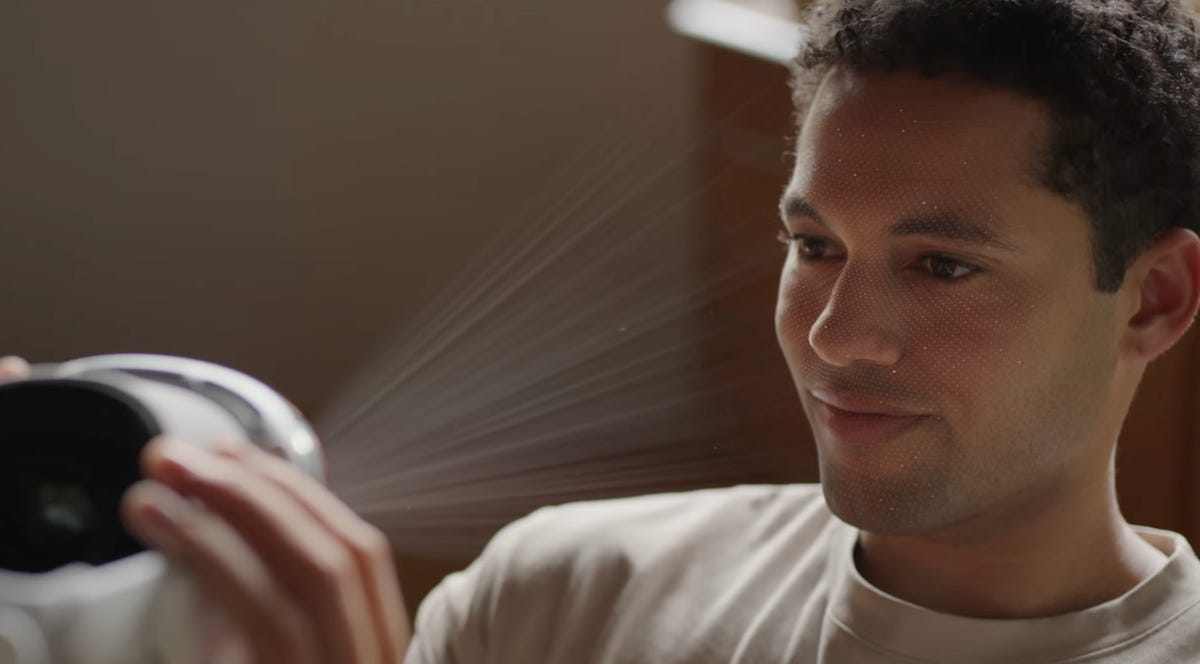
Apple Vision Pro can scan your face to create a digital 3D avatar.
To keep users from being cut off from the outside world, the EyeSight feature uses inside-pointing cameras and the headset's outer display to show your eyes -- essentially showing people around you what your eyes are focusing on . If you've dialed your immersion all the way on, your eyes will disappear on the outside screen. But you're not totally cut off. While wearing the headset, if someone approaches you they'll filter in to your vision.
The interface uses hand motions to control the device, though there are also voice controls. It's tough to tell how these controls will work, and we'd expect that users will need some time to adapt to not using a mouse and keyboard.
This isn't just an entertainment device. Apple is pitching its first new product in eight years as a work-from-home and travel device, essentially letting you open however many windows you want. It can work in the office as a display for Macs, and supports Apple's Magic Keyboard and Trackpad devices.
The Vision Pro has Apple's first 3D cameras and can take spatial photos, providing 3D depth with binaural audio to experience moments with more immersion. Of course, this spatial experience is extended to movies that's "impossible to represent on a 2D screen," Apple said during its presentation, continually teasing the exclusivity that non-headset wearers won't even understand without trying out a Vision Pro. Disney CEO Bob Iger took the WWDC stage to vouch for the headset, and followed with a short video showing interactive 3D experiences that Vision Pro users will soon get to experience on the Disney Plus streaming service.
Now that Apple has all these new cameras and eye-tracking, it's introduced a way to secure your data and purchases with Optic ID , which uses your eyes as an optical fingerprint for authentication. Camera data is processed at the system level, so what the headset sees isn't fed up to the cloud.
Read more: Apple's 'One More Thing' Retrospective
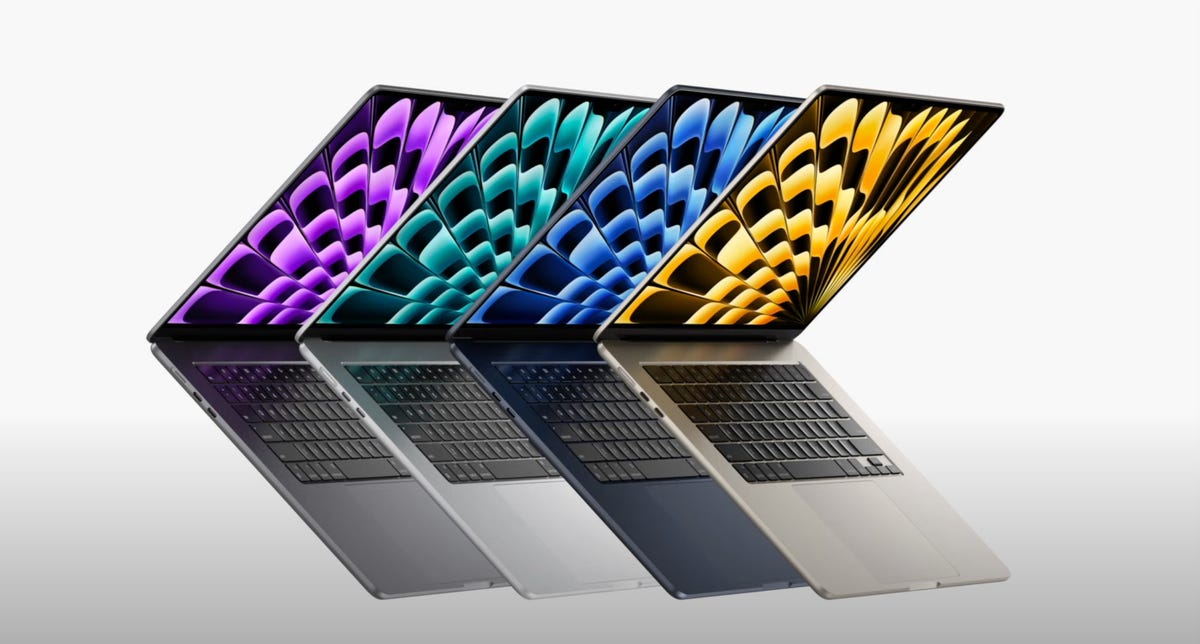
New MacBook Air 15
As was rumored, Apple announced a new MacBook Air 15 , a larger version of the MacBook Air 13 that launched last year.
The 15-inch MacBook Air is powered by an M2 chip and gets up to 18 hours of battery life. Configurations can come with up to 24GB of memory and up to 2TB of storage, retailing for $1,299 to start (or $1,199 with a student discount).
The 15-inch model is 11.5mm thick and 3.3 pounds, and has two Thunderbolt ports and a Magsafe cable connector -- along with a 3.5mm headphone jack. It has an above-display 1080p camera in a notch, three microphones and six speakers with force-canceling subwoofers.
Read more: 15-inch MacBook Air M2 Preorder: Where to Buy Apple's Latest Laptop
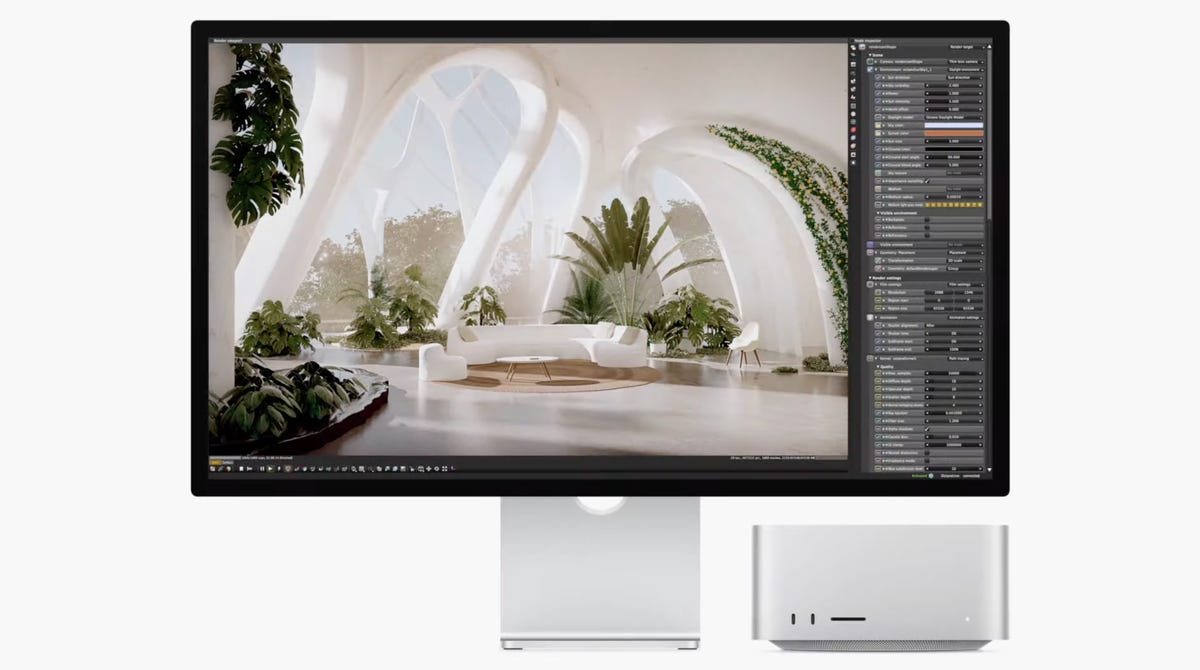
Mac Studio with M2
A new Mac Studio has landed and it comes with Apple's latest silicon. The new model comes with an M2 Max chipset, or the new M2 Ultra chipset -- essentially two M2 Max chips combined, which enables up to 192GB of memory.
The M2 Ultra stole the spotlight with new capabilities, with a 24-core CPU and streaming 22 videos at 8K ProRes resolution at once. It can support up to six Apple Pro Displays at once.
The Mac Studio starts at $1,999 and will be available starting next week.
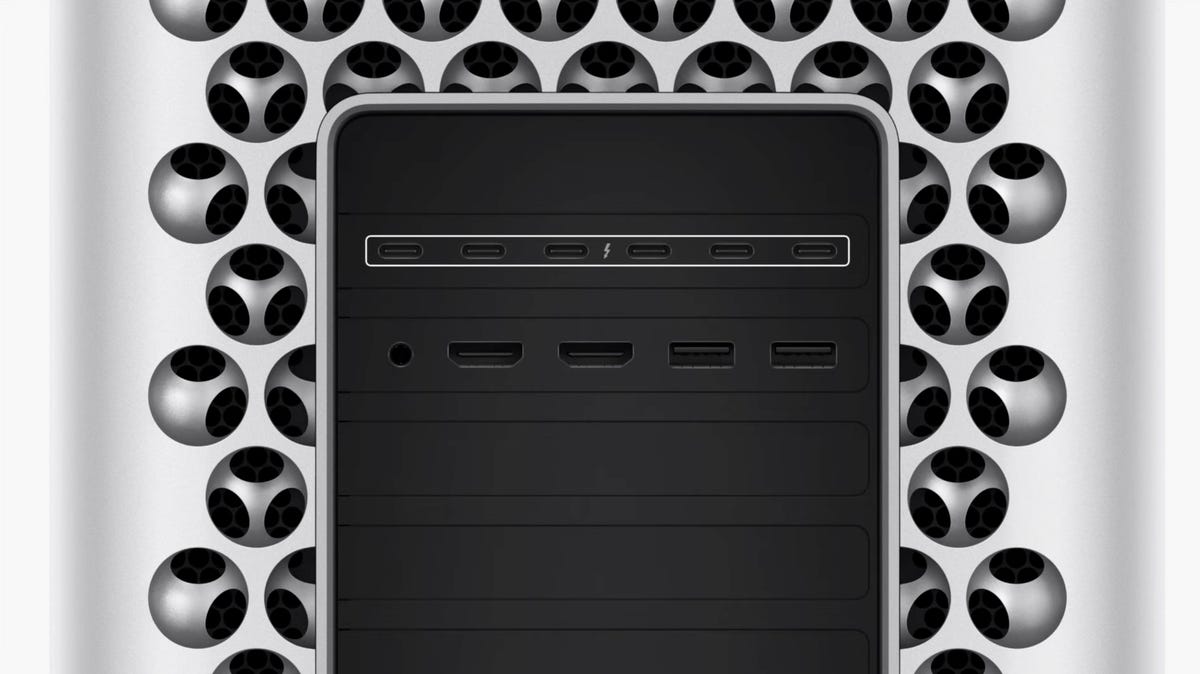
Mac Pro with M2 Ultra
Apple wasted no time announcing that its new high-end desktop Mac Pro model would get the M2 Ultra as well. The new Mac Pro gets all the M2 Ultra upgrades as the Studio, including support for up to 192GB of RAM.
The Mac Pro has eight thunderbolt ports, two HDMI ports and dual 10GB ethernet ports, with six open PCIe Gen 4 slots. The new Mac Pro comes in both upright tower and horizontal rack orientations.
The new Mac Pro starts at $6,999 and will be available starting next week.
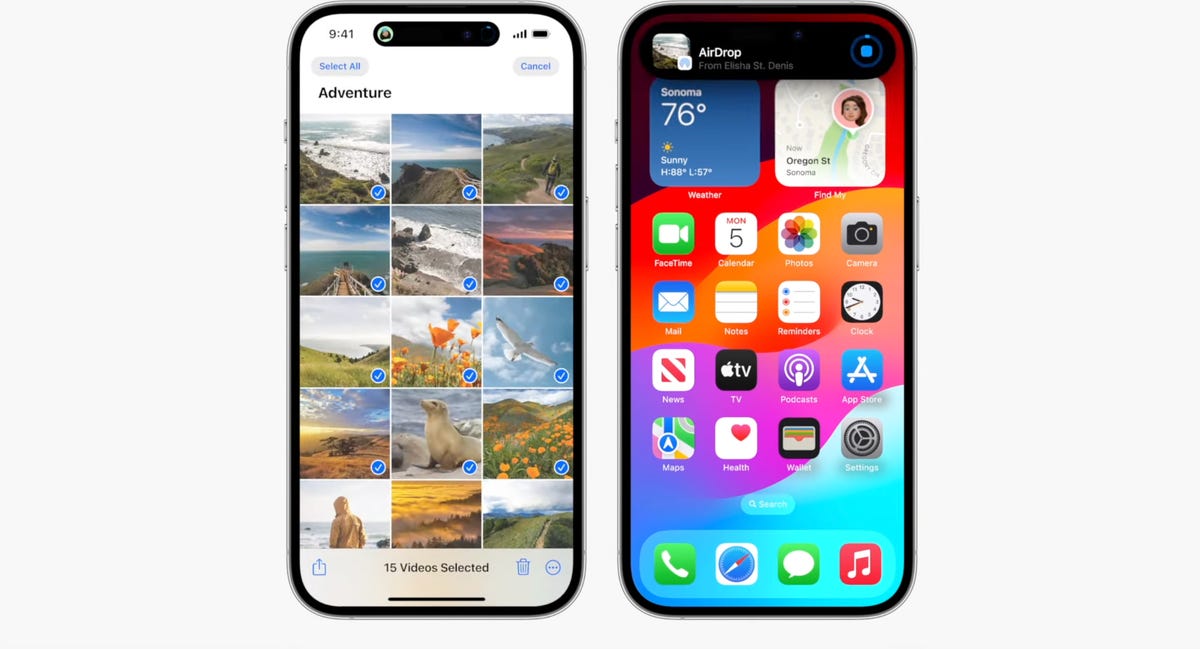
iOS 17 brings a ton of quality-of-life improvements, and the iOS 17 developer beta is available now to download. Finally, you can use more filters while searching within your Messages. In addition to pressing and holding on messages to reply, you can also simply swipe on specific messages to reply to them, and voice notes will be transcribed.
Say goodbye to gray screens when you get calls -- now you can set full-screen photos or Memoji to contacts when they call you. And if someone leaves a voicemail, you can see it transcribed in real time to help you screen calls if you don't recognize a caller.
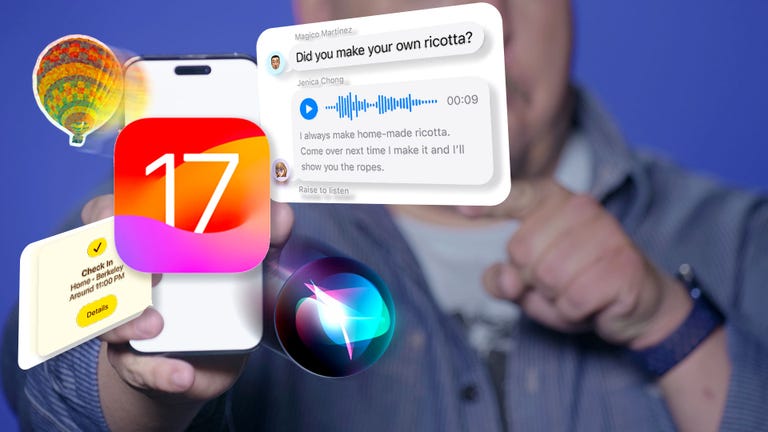
A new safety feature, Check In, sends a note to a trusted contact when you reach a location -- like when you make it home safe after late-night travel. If it's taking you longer to get to a destination, you'll be prompted to extend the timer rather than alert your contact. It also shares your battery and signal status. Check In is end-to-end encrypted.
Last year, Apple introduced an iOS feature to let you copy photo subjects and paste them as stickers -- and now you can do that with video to essentially create GIFs to share with friends or even as responses to Messages. All emoji are now shareable stickers, too.
AirDrop has been a helpful tool to send files between Apple devices, but now you can share your contact info with Name Drop . You can choose what you want to share between email addresses, phone numbers and more.
Also, say goodbye to relying on Notes to jot down your thoughts -- Journal is a new secure app for personal recollections . Apple is pitching it as a gratitude exercise, but iOS will auto-include activities like songs and workouts you've done to your personal log.
Apple Maps got an update that Android owners have had for years -- the ability to use Maps offline , especially helpful when you're outside network range while outdoors or conserving battery.
A new mode, StandBy, converts an iPhone to an alarm clock when it's charging and rotated horizontally. It gets smart interactions like a large visible clockface along with calendar and music controls.
Lastly, as was rumored, you won't have to say, "Hey Siri," anymore. Just saying "Siri" will bring up the voice assistant.
Read more: Apple Finally Lets You Type What You Ducking Mean on iOS 17
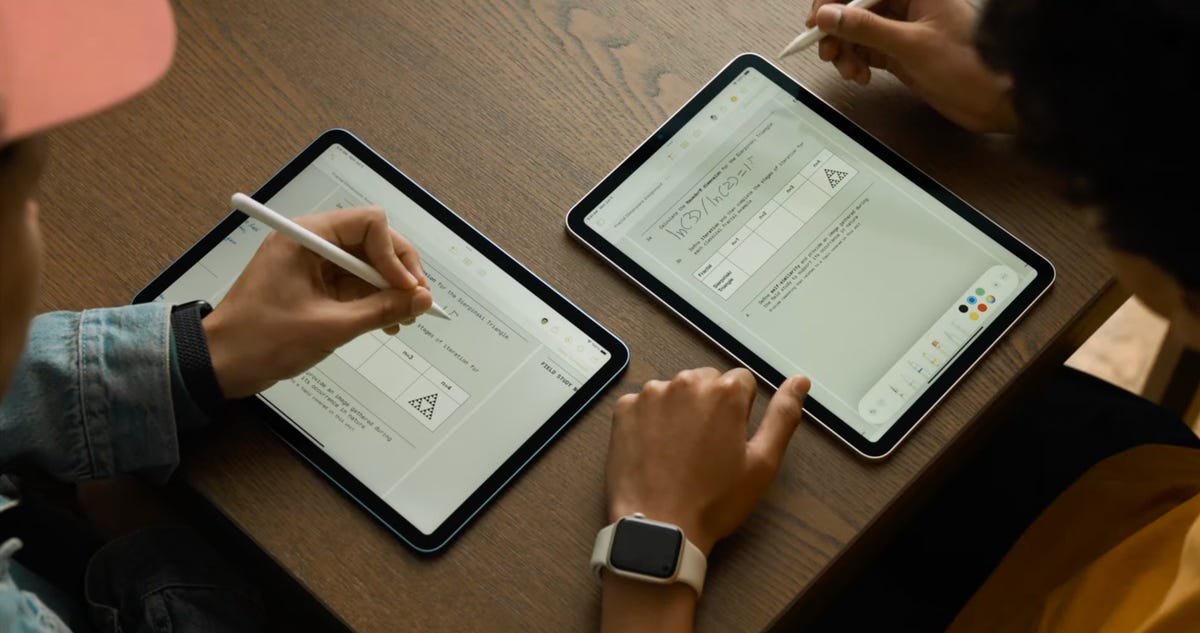
iPadOS 17 brings more controls to widgets, which don't just show more info at a glance -- they have more interactive buttons to let you control your smart home or play music.
iPadOS 17 is bringing more interactive personal data to the Health app, including richer sleep and activity visualization.
The next iPadOS update brings quality-of-life upgrades like more lock screen customization and multiple timers (helpful when cooking), as well as improvements to the follow-you-during-video-calls Stage Manager feature for iPad selfie cameras.
With all the screen space on an iPad, Apple expanded what you can do with PDFs, which can be autofilled and signed from within iPadOS. iPad owners can collaborate in real time while tweaking PDFs, and the files can now be stored in the Notes app.
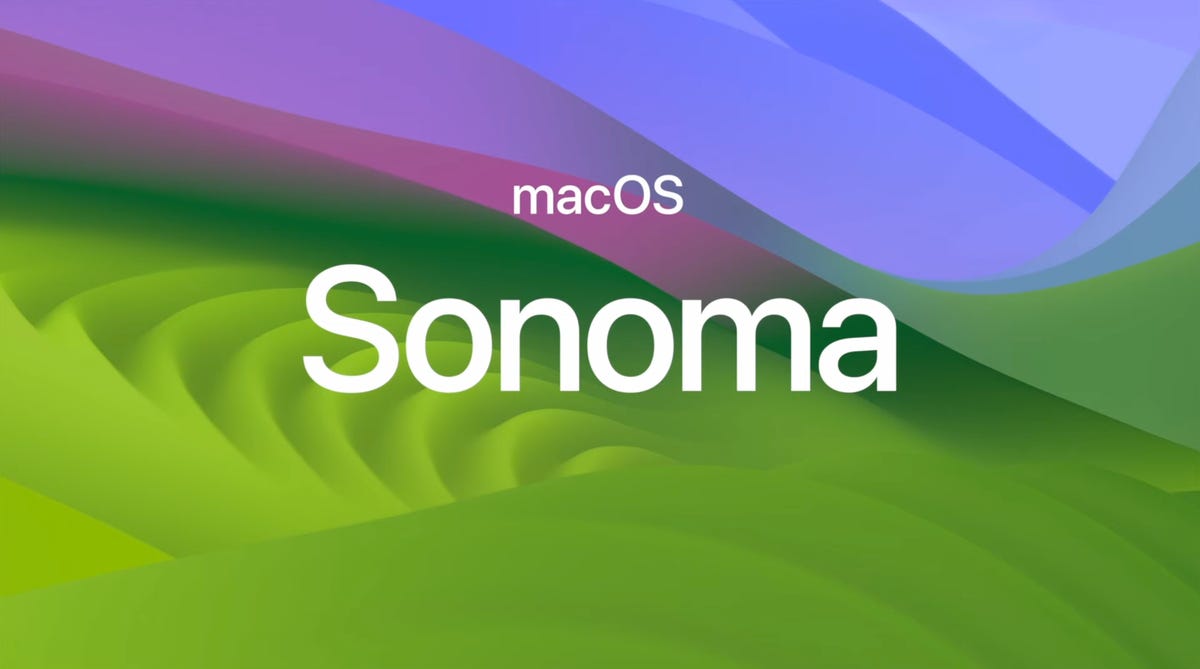
MacOS Sonoma
MacOS Sonoma , named after one of California's most famous wine-producing areas, continues the WWDC theme of adding more widget functionality.
Sonoma also has some gaming upgrades like a new gaming mode that prioritizes CPU and GPU to improve frame rate. Apple is paying attention to immersion with lower latency for wireless controllers and speakers or headsets. The company is also courting developers with game dev kits and Metal 3. But the biggest gaming announcement is that legendary game creator Hideo Kojima's opus Death Stranding is coming to Macs later this year. "We are actively working to bring our future titles to Apple platforms," Kojima said during the WWDC presentation.
On the business side, Mac has improved videoconferencing with an overlay that shows slide controls while you're presenting. Apple also introduced new reactions -- like ticker-tape falling for a congratulations -- that can be triggered with gestures.
PassKey, the end-to-end encrypted password chain tech Apple introduced last year, can now be shared with other contacts , and everyone included can edit and update passwords to be shared with the group.
Safari has security updates including locking the browser window when in private browsing mode, and profiles to separate accounts, logins and cookies between work and personal use.
AirPods and audio upgrades
Apple has a handful of improvements to its audio products. AirPods will get Adaptive Audio, which combines noise canceling with intelligent audio to drown out annoying background noise while letting through important sounds -- like car horns or bike bells. It'll also pass through voices in case someone starts a conversation in person.
And it's far easier to digitally take control of the music with SharePlay while somebody with CarPlay is driving -- a prompt will go out to others in the car asking if they want to take control.
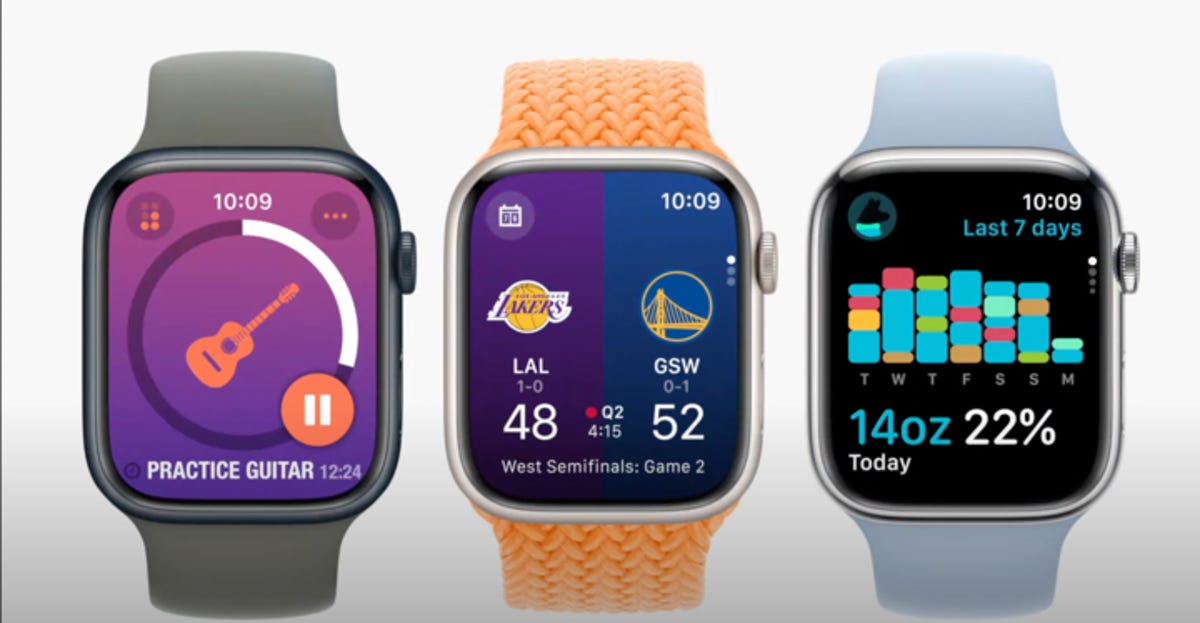
Apps in WatchOS 10 are getting a new look.
Yet again, widgets make an appearance with WatchOS 10 , the next operating system upgrade for Apple Watches. Widgets are now accessible in a stack from your home screen -- just use the digital crown to scroll between them.
Apple has focused on cycling this year, improving workouts by showing functional threshold data, an important metric for cyclists. It also connects over Bluetooth to sensors on bikes, and there's a new full-screen mode for iPhones that allows you to use it as a full screen while cycling.
Hikers, rejoice! WatchOS 10 has upgraded its compass with cellular connection waypoints, telling you which direction to walk and how far you have to go before you can get carrier reception. It also shows SOS waypoint spots, and shows elevation view in the 3D compass view. There's also a neat topographical view.
Apple is also expanding its Mindfulness app to log how you're feeling in State of Mind, choosing between color-coded emotional states. You can even access this from your iPhone in case you're away from your Apple Watch.
Health focuses for 2023
On top of the WatchOS Mindfulness updates, Apple introduced a neutral survey to self-report mood and mental health, which acts as a sort of non-medical way to indicate whether you may want to get professional help.
Apple also has a new cross-device Vision Health focus in the Health app, and a new feature on the Apple Watch measures daylight time spent outside to watch for myopia in younger wearers . Screen Distance uses the TrueDepth camera on iPads to warn people if they're too close to the screen.
Mobile Guides
- Best iPhone
- Best Galaxy S24 Deals
- Best iPhone Deals
- Samsung Galaxy S24 Review
- Best Android Phones
- Best Samsung Galaxy Phone
- Pixel 8 Pro Review
- iPhone 15 Pro/Pro Max Review
- Best iPhone 15 Deals
- Best Foldable Phones
- Galaxy Z Fold 5 Review
- OnePlus Open Review
- Best Galaxy Z Flip Deals
- Best Wireless Earbuds
- Best Noise Canceling Headphones
- Best Headphones
- Best Over Ear Headphones
- Best Wireless Earbuds and Headphones for Making Calls
- Best Headphones for Work at Home
- Best Noise Canceling Wireless Earbuds
- Best Sounding Wireless Earbuds
- Best Cheap Wireless Earbuds
- Best Wireless Headphones
- Best iPhone 15 Cases
- Best iPhone 14 Cases
- Best Power Bank for iPhone
- Best Airpods Pro Accessories
- Best Magsafe iPhone Accessories
- Best Speakerphone
- Best Wireless Car Charger and Mount
- Best iPhone Fast Charger
- Best Portable Chargers and Power Banks for Android
- Apple Watch Series 8 vs Series 7
- Best Apple Watch Bands
- Best Android Smartwatch
- Apple Watch Ultra Review
- Best Smartwatch
- Best Prepaid Phone Plans
- Best Cheap Phone Plans
- Best Unlimited Data Plans
- Best Phone Plans
- Best Phone Plan Deals
- Best Senior Phone Plans
- Best Family Phone Plans
- Best Travel Phone Plans
- Best Verizon Plans
- Use Presenter View Video
- Add speaker notes Video
- Practice and time your presentation Video
- Record a presentation Video
- Print a presentation Video

Use Presenter View

PowerPoint Presenter View shows you the current slide, the next slide, and your speaker notes, to help you focus while presenting and connect with your audience.
Select the Slide Show tab.
Select the Use Presenter View checkbox.

Select which monitor to display Presenter View on.

In Presenter View , you can:
See your current slide, next slide, and speaker notes.
Select the arrows next to the slide number to go between slides.
Select the pause button or reset button to pause or reset the slide timer in the upper left.
See the current time to help you pace your presentation.
Select the font icons to make the speaker notes larger or smaller.
Select the annotations pen icon to draw on the screen in real time, or select a laser pointer.
Select the thumbnail icon to see all the slides in your presentation and quickly jump to another slide.
Select the magnifying glass icon to zoom in on a particular part of a slide.
The screen icon let's you make the screen temporarily black to focus the attention on you.
Select END SLIDESHOW when you're done presenting.
Start the presentation and see your notes in Presenter view

Need more help?
Want more options.
Explore subscription benefits, browse training courses, learn how to secure your device, and more.

Microsoft 365 subscription benefits

Microsoft 365 training

Microsoft security

Accessibility center
Communities help you ask and answer questions, give feedback, and hear from experts with rich knowledge.

Ask the Microsoft Community

Microsoft Tech Community

Windows Insiders
Microsoft 365 Insiders
Was this information helpful?
Thank you for your feedback.
Summer of Gaming 2024 Schedule: How to Watch and What to Expect
IGN's Summer of Gaming is back for its fifth year and will be the place where you can catch all the biggest gaming events in the world, including IGN Live , the Xbox Games Showcase, the Wholesome Games Direct, Summer Game Fest, and so much more.
From exclusive game reveals to developer interviews to surprises you simply won't want to miss, there is a ton to look forward to this summer. To ensure you don't miss a thing, this guide will not only keep track of all the events, but will also be a place to catch all the recaps and biggest moments.
When Is Summer of Gaming 2024?
IGN's Summer of Gaming kicks off today and will run through the end of June and possibly beyond, depending on when all the showcases take place! So far, the first event we have on the schedule is Sony's State of Play on May 30. There are a lot of shows below, but also a few unknowns, like the Nintendo Direct that Nintendo itself confirmed would be arriving sometime in June.
How to Watch Summer of Gaming 2024
Here’s a list of places you can watch IGN’s Summer of Gaming event:
- IGN.com (homepage)
- IGN's Facebook Channel
- IGN’s Twitter
- IGN's Twitch Channel
- IGN’s Youtube Channel
- IGN's iOS App
- IGN's Android App
- Amazon Fire Games Channel
- Samsung TV Plus
Summer of Gaming 2024 Schedule and What to Expect
You can find the current schedule for IGN's Summer of Gaming below, but it will be updated regularly with new shows, details, dates, and much more. Be sure to check back often!
Thursday, May 30
- The Sony State of Play will be a 30+ minute show, featuring updates on the PS5, PS VR2, along with 14 titles from PlayStation Studios' games. Make sure to tune in after the livestream for a live episode of IGN's PlayStation Podcast Beyond!
Tuesday, June 4
- The OTK Games Expo is a 3-hour 'digital exposition' that promises a look at over 30 video games spanning a dozen genres. You can check out the full list of games that were featured in 2023's show right here, including Toxic Crusaders, Aloft, Turnip Boy Robs a Bank, and Gangs of Sherwood.
Thursday, June 6
- The Guerrilla Collective is returning for another big show, and this year they will be hosting an online showcase on June 6 and an on-site showcase on June 7 at 5pm PT/8pm ET. Once again, the Guerilla Collective will showcase some of the best indie games headed our way with new trailers and a ton of gameplay. Some of the highlights from 2023's show were Europa, Lil' Guardsman, SacriFire, and more.
Friday, June 7
- IGN Live, our new in-person fan event that will feature exclusive reveals from the biggest names in video games, movies, TV shows, and comics alongside trailers, gameplay, panels and interviews, live episodes of IGN shows, demos, and so much more, will kick off on June 7. While we haven't revealed everything yet, fans can expect this first day to include the Borderlands movie, Beverly Hills Cop: Axel F, Street Fighter 6's Akuma DLC, Despicable Me 4, The Legend of Vox Machina, and and an exclusive sneak peak of the new movie Hit Man.
Saturday, June 8
- Day 2 of IGN Live will continue the fun with a celebration of Tetris' 40th anniversary, a Star Trek: Strange New Worlds sing-along, a special screening of Transformers: Earthspark, and an in-depth interview with Team Sonic head Takashi Ilzuka.
- The Future of Play Direct 2024, which is inspired by Toonami and is hosted by V-Tuber A.I. broadcaster Melios, will bring more indie goodness to fans on June 8 with "big announcements, brand new trailers, musical guests, and show-stopping galaxy premieres that are dripping in style." Future of Play Direct 2023 featured Hermit and Pig, Psychroma, Ritual Knight, Yasuke: A Lost Descendant, and more.
- The Wholesome Games Direct is returning on June 8 to gift us more "cute, friendly, compassionate, cozy video games." 2023's Wholesome Games Direct was highlighted by such titles as Frogsong, Venba, Unpacking, and Smushi Come Home.
- GamesRadar+'s Future Game Show will be a big show with over 40 upcoming games headed to PS5, Xbox, Switch, and PC in its "most ambitious showcase yet."
- Presented by Devolver Digital and Raw Fury, the Latin American Games Showcase will boast over 70 games from all around Latin America with exclusive announcements and world premieres.
- The Women-Led Games Showcase is set for June 8 and will include games that are being developed by woman-led and majority women studios. The goal of this show is to "highlight all the amazing things women do in games and support their efforts in order to create a more equitable games industry."
Sunday, June 9
- The final day of IGN Live will feature a chat with Xbox head Phil Spencer and other members of the team after the Xbox Games Showcase and a one-on-one fireside chat with legendary game developer Stig Asmussen.
- The PC Gaming Show is celebrating its 10th anniversary this year and the team is marking the moment with a show filled with over 50 games. Fans can also expect "some reflection on the positively transformative changes PC gaming has seen in that time, but don't worry, we won't let the navel gazing get in the way of the world premieres, exclusive announcements, and developer interviews."
- The highly-anticipated Xbox Games Showcase will give fans a glimpse into the future of the games from the studios across Activision, Blizzard, Bethesda, and Xbox Game Studios. As always, there will also be big surprises from Xbox's third-party partners. Last year's Xbox Games Showcase gave us a look at Playground Games' Fable, Cyberpunk 2077: Phantom Liberty, Avowed, Star Wars Outlaws, and much more. Right after the Xbox Games Showcase, there will be a Call of Duty: Black Ops 6 Direct that will reveal a ton more about the next entry in the legendary series.
Monday, June 10
- Ubisoft's big games will take center stage on June 10 with the latest Ubisoft Forward, which promises "exciting news on upcoming games from our teams around the world." There is a very good chance we'll see more of such games as Assassin's Creed Shadows and Star Wars Outlaws during the event. You can check out all the big reveals from 2023's Ubisoft Forward right here.
Wednesday, June 12
- Black Voices in Gaming is all about providing the spotlight for Black game developers in the game industry and this showcase is about giving them their deserved moments to shine. For an idea of what to expect, you can check out everything announced during 2023's Black Voices in Gaming.
- Dames 4 Games is teaming up with Black voices in Gaming and Stream for a Cause for another big show celebrating the "diverse voices of devs and gamers in the gaming industry." Last year was the first Dames 4 Games showcase and it featured a great selection of games from women creators across the world.
- Stream for a Cause, the nonprofit organization that "works with content creators and gamers to uplift and support communities," is back with another big show.
Tuesday, June 25
- The Gayming Awards, the "world's only LGBTQ video game award show," is back for its fourth year to celebrate "LGBTQ excellence in gaming." Fans can look forward to such categories as Game of the Year, Gayming Magazine Readers Award, Best LGBTQ Indie Game, and more.
Wednesday, June 26
- The Upload VR Showcase, which is presented by UploadVR, IGN, and more, will showcase the best upcoming games in the world of virtual reality.
It's very likely that there are many more showcases on the way we just don't know about yet, and we will include some of those below when we get some concrete info.
- We may not know the exact date, but Nintendo did confirm it will be holding a Nintendo Direct in June that will focus on Switch games due out during the latter half of 2024. Temper those expectations, however, as it also mentioned there will be no talk of the next Switch console.
IGN Recommends

Thank you for visiting nature.com. You are using a browser version with limited support for CSS. To obtain the best experience, we recommend you use a more up to date browser (or turn off compatibility mode in Internet Explorer). In the meantime, to ensure continued support, we are displaying the site without styles and JavaScript.
- View all journals
- Explore content
- About the journal
- Publish with us
- Sign up for alerts
- Open access
- Published: 30 March 2024
Cigarette craving in virtual reality cue exposure in abstainers and relapsed smokers
- Benedikt Schröder 1 ,
- Agnes Kroczek 2 , 3 ,
- Leon O. H. Kroczek 1 ,
- Ann-Christine Ehlis 2 , 4 ,
- Anil Batra 2 , 3 , 4 &
- Andreas Mühlberger ORCID: orcid.org/0000-0002-8352-0946 1
Scientific Reports volume 14 , Article number: 7538 ( 2024 ) Cite this article
992 Accesses
1 Citations
16 Altmetric
Metrics details
- Health care
Cue exposure therapy (CET) in substance-use disorders aims to reduce craving and ultimately relapse rates. Applying CET in virtual reality (VR) was proposed to increase its efficacy, as VR enables the presentation of social and environmental cues along with substance-related stimuli. However, limited success has been reported so far when applying VR-CET for smoking cessation. Understanding if effects of VR-CET differ between future abstainers and relapsing smokers may help to improve VR-CET. Data from 102 participants allocated to the intervention arm (VR-CET) of a recent RCT comparing VR-CET to relaxation in the context of smoking cessation was analyzed with respect to tolerability, presence, and craving during VR-CET. Cue exposure was conducted in four VR contexts (Loneliness/Rumination, Party, Stress, Café), each presented twice. Relapsed smokers compared to abstainers experienced higher craving during VR-CET and stronger craving responses especially during the Stress scenario. Furthermore, lower mean craving during VR-CET positively predicted abstinence at 6-month follow-up. Attempts to improve smoking cessation outcomes of VR-CET should aim to identify smokers who are more at risk of relapse based on high craving levels during VR-CET. Specifically measuring craving responses during social stress seems to be well suited to mark relapse. We propose to investigate individualized treatment approaches accordingly.
Similar content being viewed by others
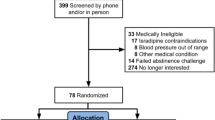
Isradipine augmentation of virtual reality cue exposure therapy for tobacco craving: a triple-blind randomized controlled trial
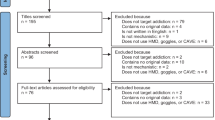
Virtual reality: a powerful technology to provide novel insight into treatment mechanisms of addiction
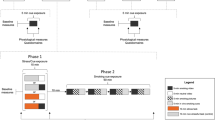
A novel stress-based intervention reduces cigarette use in non-treatment seeking smokers
Introduction.
Craving is a diagnostic criterion for substance-use disorders according to DSM-5 and is defined as longing or urge for the substance, which can occur at any time but is more likely in an environment where the substance was previously obtained or consumed 1 . Most theoretical models of addiction consider craving as a central motivational component of ongoing substance use and closely linked to relapse 2 . Among smokers, craving is typically increased in the presence of smoking-related stimuli 3 , rises in phases of abstinence 4 , and is reported as the most distressing symptom of a smoking cessation attempt 2 . However, as reviewed for several substance-use disorders 5 and also specifically with respect to smoking 6 , there are inconsistent results as to whether craving is able to predict relapse. Tiffany et al. 2 (p. 181) suggest that conflicting findings might be explained partly by the fact that the association of craving with maintained substance use and relapse only exists when “the conditions of craving assessment and/or induction are maximally representative of the natural expression of craving.” However, this representativeness is limited in clinical settings by the fact that they do not provide a typical context of consumption.
Cue reactivity (CR) is a motivational response to drug-related cues and is considered a core characteristic of addiction as drug consumption is strongly influenced by cues (e.g. environments, objects, emotions) previously associated with the drug's effects through classical conditioning 7 . CR consists of three modalities: a physiological reaction, a behavioral reaction (e.g. drug-seeking), and craving 8 . Of these, self-reported craving is most commonly used as a measure of CR and was found to be a stronger indicator of CR than physiological variables 7 .
Drawing from the successful treatment of anxiety disorders through exposure 9 , cue exposure therapy (CET) has been proposed in the treatment of substance use disorders to reduce CR and ultimately the probability of relapse since both disorders have in common that conditioning processes were proposed to be responsible for their maintenance and to be targeted during treatment 10 .
CET aims to reduce the conditioned response (i.e. craving) to conditioned stimuli (e.g. smoking paraphernalia) through extinction learning, which is supposed to be achieved by repeated confrontation with the conditioned stimuli without smoking 9 . Despite this plausible treatment rationale, CET has not yet proven to be a consistently effective intervention in the treatment of substance use disorders 11 , 12 , 13 . A possible cause for this could be that traditional CET in substance use disorders usually presents substance-related stimuli in a clinical setting in the form of images, videos, or tactile objects such as wine glasses or bongs, which is accompanied by relatively low ecological validity 14 . It has been argued that this limitation might be overcome by applying CET in virtual reality (VR-CET) because in addition to substance-associated objects, environments and social contexts, including interactions (e.g. consumption offers) and emotional triggers, can be presented that more closely reflect real-life situations 15 , thus promoting both cue and contextual extinction 9 , 14 . This is important as craving usually increases due to a complex combination of environmental cues, emotional states, reactivation of autobiographical experiences, and sensory information 16 . Accordingly, VR cue exposure reliably induced craving across various substance use disorders including nicotine 17 .
Early treatment studies supported the feasibility of VR-CET in smoking cessation and found concomitant decreases in craving 18 and lower smoking rates and craving in smokers receiving VR-CET and nicotine replacement therapy compared to nicotine replacement therapy alone 19 . In addition, a preliminary study with a small sample size compared cognitive behavioral therapy (CBT) alone with VR-CET alone and found both treatments comparably effective 20 . Another study, though without a control group, reported that VR-CET reduced the number of smoked cigarettes per day, carbon monoxide in exhaled air, and craving across exposure sessions 21 . Surprisingly, however, a recent RCT with a long follow-up period found that CBT combined with VR-CET was not superior to CBT alone in terms of abstinence rates and thus could not demonstrate specific efficacy of VR-CET 22 . A question important for understanding the effect of VR-CET that has so far remained unaddressed in the aforementioned VR-CET studies, is whether individuals who later achieve abstinence differ in terms of their craving from those who do not. In addition, there is a lack of research examining potentially relevant aspects of VR-CET aside from craving such as emotion induction, self-efficacy, presence, and tolerability.
The goal of the present study was to identify possible differences in the course of craving during VR-CET in future successful abstainers compared to relapsing smokers in order to obtain indications for future improvements of VR-CET, and to clarify the predictive ability of craving in ecologically valid contexts. In addition, we aimed to evaluate the scenarios used for VR-CET in terms of emotion induction, presence, and tolerability.
We hypothesize that smokers who relapse within 6 months after completing treatment in principle experience stronger craving in VR-CET than those who maintain abstinence. We additionally hypothesize that craving during VR-CET is predictive for future medium-term relapse.
Design and participants
This study analyzes data from participants allocated to the intervention arm of a bicentric RCT (ClinicalTrials.gov Identifier: NCT03707106), which investigated the efficacy of cue exposure therapy in virtual reality (VR-CET) in the context of smoking cessation. In this RCT, VR-CET was compared to an unspecific relaxation intervention (control group). Both arms were incorporated into an already evaluated cognitive-behavioral smoking cessation group therapy. The study protocol 23 and the primary results are reported elsewhere. All participants provided written informed consent, and the RCT was approved by the Ethics Committee of the Faculty of Medicine at the University Hospital of Tuebingen (no. 836/2016BO1) and by the Ethics Committee of the German Psychological Society (DGPs) (no. AM022017). The study was conducted according to the approved procedures. Inclusion criteria were being between 18 and 70 years of age and smoking a minimum of 10 cigarettes daily for at least 2 years. Exclusion criteria were pregnancy, participation in another smoking cessation program within 6 months before assignment, current diagnosis of a psychiatric disease including current depression or substance use disorder (other than nicotine), and lifetime diagnosis of psychosis, bipolar affective disorder or posttraumatic stress disorder.
The intervention arm included a total of 122 randomized participants of which 102 participants received the allocated VR-CET (n = 20 dropped out before the start of the intervention). As the present study focuses on the processes during VR-CET, the current sample consists of the 102 participants who received VR-CET, including 43 female (42.2%) and 59 male smokers (57.8%) aged M = 45.67 years (SD = 13.40; range 20–68 years). On average participants attended three out of a total of four VR-CET appointments (M = 3.00, SD = 1.03). Prior to starting smoking cessation, participants in the analyzed sample reported to smoke M = 17.93 cigarettes per day (SD = 5.81) and they scored at M = 4.46 points (SD = 2.04) on the Fagerström Test for Nicotine Dependence 24 (FTND). The mean age at smoking initiation was 17.44 years (SD = 4.78). The exhalation carbon monoxide (CO) level at the beginning of smoking cessation was M = 17.23 (SD = 11.09). Among this sample, 24 participants (23.5%) remained continuously abstinent 6 months after treatment while 78 participants (76.5%) relapsed (intention to treat). Prior to the smoking cessation intervention, abstainers and relapsed smokers did not differ significantly in terms of cigarettes per day ( p = 0.739), FTND scores ( p = 0.169), age of regular smoking onset ( p = 0.713), age at time of study inclusion ( p = 0.849), and CO level at the first appointment of smoking cessation ( p = 0.647). In addition, abstainers and relapsed smokers did not differ significantly regarding gender ( p = 0.317).
During treatment, in the days before the first VR-CET session, 81 participants were abstinent (validated by results of < 10 ppm in CO measurement) and 16 participants still smoked. In the days before the second VR-CET session, 71 participants were abstinent and 5 participants smoked. In the days before the third VR-CET session, 64 participants were abstinent and 8 participants smoked. In the days before the fourth VR-CET session, 61 participants were abstinent and 9 participants smoked.
Apparatus and VR scenarios
VR was presented with the VIVE Pro head-mounted display (HMD; HTC Corporation, Taoyuan, Taiwan). Integrated headphones played the sound. Hardware to run the VR included the NVIDIA GeForce GTX 1080 Ti graphics card (Nvidia Corporation, Santa Clara, CA, United States), the Intel(R) Core(TM) i7-7740X CPU @ 4.30 GHz (Intel Corporation, Santa Clara, CA, United States), 16 GB DDR4 RAM, and the Samsung SSD 850 hard disc (Samsung Group, Suwon, South Korea). The VR environment was controlled using CyberSession Research 5.8 (VTplus GmbH, Würzburg, Germany). Participants used a gamepad (F710 Wireless Gamepad, Logitech international S.A., Apples, Switzerland) to navigate within the VR. Experimenters were able to follow participants' view and audio via a separate computer screen and speaker (set to the lowest volume and turned in the direction of the investigators away from the participants to avoid double hearing of the audio for participants).
A total of four virtual environments were presented, each lasting between approx. 13 and 18 min. All environments included standardized pre-recorded instructions that were played via the headphones. Two of the VR environments described below (Loneliness/Rumination and Stress) were created using the Steam Source engine (Valve Corporation, Bellevue, WA, United States) at the Department of Psychology (Clinical Psychology and Psychotherapy) at the University of Regensburg. Another two VR environments (Party and Café) were created with Unreal Engine 4 (Epic Games, Raleigh, NC, United States) by VTplus GmbH (Würzburg, Germany).
Each VR environment contained three-dimensional smoking-related stimuli (e.g. cigarette packs, loose cigarettes, lighters, ashtrays). The cigarette packets were individually configured to the participants' preferred smoking brand from a list of 21 tobacco brands. If the own brand was not included, the preferred brand among the existing brands was selected. The RCT did not assess how frequently this occurred. Inquiries among investigators indicated that the participants' own brand was mostly available for selection in VR, which is supported by the fact that the brands available for selection included the 9 largest cigarette brands in Germany in terms of market share 25 .
Development of VR environments was based on a survey of participants in a smoking cessation course 23 . In the following we describe the four VR scenarios used for cue exposure in detail (see Fig. 1 for screenshots of the scenarios). (1) Loneliness/Rumination: Before the VR session, investigator and participant select the most burdensome concern from the participant's daily life based on results of the German version of the Worry Domains Questionnaire 26 (WDQ-D) already completed at baseline. After putting on the HMD, the participants are instructed to explore the VR environment consisting of a living room and a balcony freely for one minute using the gamepad. Participants are then assisted in sitting down and are instructed to describe the selected concern and the associated mood, thoughts, feelings, and physical experiences. They are further instructed to ruminate on the selected concern (worry induction). Participants sit alone on a sofa while smoking paraphernalia (cigarette pack, lighter, six loose cigarettes) are displayed on a table in front of them. In the direction of the participants' view, there is a window facade with an open door to a roofed balcony. On a table on the balcony an ashtray is placed and there is another pack of cigarettes and a lighter. Rain is visible and audible through the windows. Slow piano music comes from a stereo. Following worry induction, participants are instructed to inspect the smoking paraphernalia in detail (specifically to perceive the color of the lighter, the color and the logo of the cigarette pack, and to count the number of cigarettes). The scenario lasts approx. 18 min. (2) Party: Participants are immersed in a virtual barbecue party and are informed that they will receive cigarette offers and that their task is to firmly refuse them. Initially, participants are given one minute to freely navigate within the VR environment. After that, the participants are assisted to sit down. In VR, participants are placed at a table together with five virtual agents (two female, three male), three of whom are currently smoking. Two other characters also light a cigarette in the course of the scenario. Three characters drink beer, one red wine, and one water. There are cigarette packs, lighters, and ashtrays on the table. The terrace is surrounded by a garden, a barbecue is next to the table, and the sun is shining. The smokers talk about the pleasure of smoking and how well smoking fits the current situation. One character offers the only character not yet smoking a cigarette, which the character refuses on the grounds that he has recently quit smoking. One smoking character replies that he had already tried to quit, but wonders why he should put himself through this strain when he enjoyed smoking so much. While the four smoking characters continue to talk about the pleasurable aspects of smoking, the previously declining character changes his mind saying he wants a cigarette after all and starts to smoke as well. Over the course of this scenario, participants receive four offers of cigarettes, at about 3.5, 6, 6.5 and 7 min after the start of the scenario. Overall, the scenario lasts approx. 13 min. (3) Stress: This scenario is based on the Trier Social Stress Test paradigm 27 (TSST), which has already been able to generally induce psychosocial stress in previous VR adaptations 28 and also specifically in smokers 29 . In the present adaptation, participants begin this scenario in a standing position in an office space. In the room there is a desk and several chairs. One end of the room consists of a glass front with an open door to a terrace surrounded by trees. On the terrace the sun is shining and one character is smoking next to a floor-standing ashtray. Additionally, there is a closed opaque door next to which hangs a sign that states "Interviews". Participants are again informed that they should decline cigarette offers during the course of the scenario. They are further informed that they participate in an interview for their dream job and should now prepare to give a talk about their own strengths and their particular suitability for the job. It is announced that this talk would subsequently be presented to an application committee of three psychologists trained in behavioral observation. The participants are also informed that there are three other applicants, one of whom is currently in the interview room, another is smoking on the terrace, and one has not yet arrived. After two minutes of preparation time, the third applicant enters the room, mentions how nervous she is, notices the character smoking on the terrace and states that she now also needs a cigarette. Before going to the terrace, she also offers a cigarette to the participant. Once the offer is declined, she answers that she has enough cigarettes in case the participant wants one later and starts smoking next to the character already standing on the terrace. Next, a character from the interview room approaches the participant and informs that the preparation time is over and that she is now accompanying the participant to the committee. Participants are then led into the interview room and are asked to stand in front of a committee (three persons) and a camera. Subsequently, participants perform their presentation for two minutes while standing in front of the expressionless committee. If participants finish their presentation before the end of the two minutes, one committee member asks to continue the presentation stating there is still time available (triggered by the investigator). Upon completing the presentation, a previously unannounced arithmetic task is introduced by the committee. Participants are instructed to continuously subtract 17 from 2023 and to calculate as quickly and correctly as possible. The arithmetic task lasts two minutes and participants are prompted by the committee to start over at 2023 if they made a mistake. After these tasks, participants find themselves together with the two smoking competitors on the terrace. The competitors talk about the relaxing and rewarding effect of smoking during this stressful situation and one competitor offers the participant a cigarette a total of three times, at about 4, 10 and 10.5 min after the start of the scenario. Overall, the scenario lasts approx. 17 min. (4) Café: Participants begin this scenario standing on a terrace of a café and are informed that they will receive cigarette offers which they should refuse firmly. Participants are given one minute to freely navigate within the VR environment. Next, the participants are assisted to sit down at a table of the café. Four characters (two female, two male) are already sitting at the table. On the table there are plates with cakes, cups, two ashtrays, two cigarette packs and lighters. The weather is good. A park and a lake are visible in the background. The characters first talk about the beautiful weather, about the nice atmosphere at the lake, and about the delicious cake and coffee. They further talk about how well-fitting cigarettes and coffee are and the four characters start smoking. One character offers the participant a cigarette. After the participant's refusal, the characters express their opinion that one should not forbid oneself every pleasure in life and that smoking is part of the enjoyment at that particular moment. More conversation follows about a previous overnight stay together at a mountain hut, where they had always gone out together to smoke. In addition, they talk about earlier bar visits when it was still allowed to smoke in bars and how pleasant those times were without smoking restrictions. They state, that for them, smoking is associated with freedom, which they do not want to be taken away. During the conversation described above, the first offer of cigarettes is followed by an additional two offers. The offers occur at about 3, 4.75 and 9.25 min after the start of the scenario. Overall, the scenario lasts approx. 16 min.
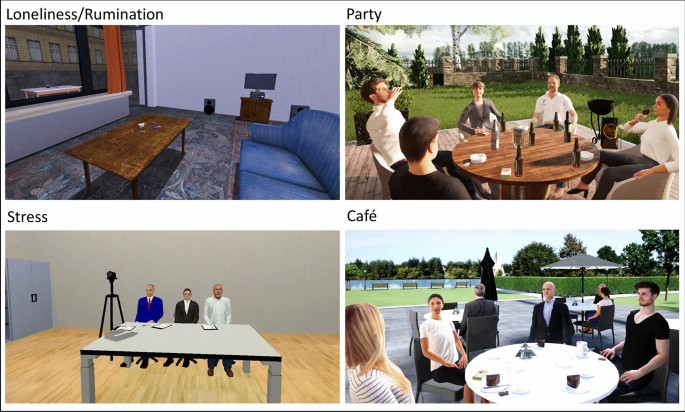
Screenshots of the virtual environments used for cue exposure. Persons depicted are virtual agents and not real persons.
This description focuses on the VR-CET intervention arm (see Fig. 2 for a schematic overview). The overall procedure of the RCT can be found elsewhere 23 . After random allocation to VR-CET, a 6-week group-based cognitive behavioral smoking cessation program 30 , 31 started in group sizes of 6 to 8 participants and with weekly appointments. Each group session lasted 90 min and was scheduled for late afternoon or evening. In session 2, the treatment rationale for CET was introduced. In addition, session 2 involved scheduling a date to quit smoking in the upcoming week prior to session 3. VR-CET took place individually in sessions 3 to 6 and lasted an additional 40 min per session. With two VR systems per study center, part of the participants completed the VR-CET before the group session and part of them afterwards. VR-CET took place in a separated room for each participant. The investigator being in the same room as the participant repeated the CET rationale, assisted in putting on the HMD, informed about steering in VR, selected the tobacco brand, noted the participants' answers to rating questions, and controlled the VR. Controlling the VR involved starting and stopping of the VR session as well as reacting to the participants' voice by continuing to the next part of the VR scenario by button press whenever interactions between the participants and the VR such as rejecting cigarette offers took place. Each VR-CET session included the successive completion of two scenarios. VR-CET started with the scenarios Loneliness/Rumination and Party, followed by Stress and Café in session 4. Session 5 was identical to session 3, while session 6 was identical to session 4. After each VR session, participants completed the VR-related questionnaires.

Sequence of treatment weeks and VR-CET sessions.
Measures of the RCT included in the present analysis consist of questionnaires, rating questions, and the clinical outcome measure.
Questionnaires: At study inclusion, participants completed a demographic questionnaire, a smoking questionnaire documenting smoking history and current smoking behavior, the Fagerström Test for Nicotine Dependence 24 (FTND), and the German version of the Worry Domains Questionnaire 26 (WDQ-D). After each session of VR-CET, the experience of presence during VR was measured with the Igroup Presence Questionnaire 32 (IPQ). The potential occurrence of cybersickness symptoms (i.e. headache, nausea, vertigo) was assessed with a brief version of the Simulator Sickness Questionnaire 33 (SSQ-b).
Ratings: All rating questions should be answered by the participants with a number between 0 (lowest rating) and 100 (highest rating). To check whether the scenarios induced the target emotions (worry in Loneliness/Rumination, stress in Stress, and sociability in Party and Café), the intensity of each emotion was rated at the end of each scenario using the following questions: “How worried were you in the situation?”, “How stressed were you in the situation?”, and “How much sociability did you feel in the situation?”. Craving ratings (4 to 6 ratings depending on the scenario) were presented before, during (e.g. after having received cigarette offers) and after each session of VR-CET with the question “How strong is your current desire to smoke a cigarette?”. At the end of each VR scenario, an additional craving rating phase existed with a total of 8 craving ratings conducted at 30-s intervals during which the VR environment continued to be presented. If the study participants' answer was 0 two times in a row, the remaining questions of the craving rating phase were skipped. For the analysis, the remaining values following a two-time response of 0 were set to 0. In the course of the scenarios Loneliness/Rumination, Party and Café, craving was rated a maximum of 12 times each, and in the Stress scenario a maximum of 14 times. Each scenario included an initial craving rating at the beginning (rating 1). In Loneliness/Rumination this was followed by a craving rating after describing the selected concern (rating 2), a craving rating after ruminating over the concern (rating 3), and a further rating after inspecting the smoking paraphernalia (rating 4). Ratings 5 to 12 consisted of the concluding craving rating phase. In Party, following the initial craving rating, further ratings took place after the first, second, and fourth cigarette offer (rating 2 to 4). Ratings 5 to 12 were again the final craving rating phase. In Café, the initial rating was followed by ratings that took place after each of the three cigarette offers (rating 2 to 4). Ratings 5 to 12 were again the final craving rating phase. In Stress, after the initial rating (rating 1), further ratings were asked for after the first cigarette offer (rating 2), after being informed about the end of the preparation time (rating 3), after the completion of the interview in front of the committee consisting of the presentation and arithmetic task (rating 4), and after the second and third cigarette offer (ratings 5 and 6). Ratings 7 to 14 were the final craving rating phase. In addition to the IPQ, which measured presence after each VR session (i.e. after two VR scenarios), presence ratings were also presented at the end of each VR scenario using the phrase “Between 0 and 100, how strongly do you agree with the following statement: In the computer-generated world, I had the impression of being there. 0 means not at all and 100 means very strongly.” Finally, the question “How confident are you not to smoke in a similar situation?” was used to rate self-efficacy.
Clinical outcome: Continuous abstinence was assessed 6 months after the end of treatment adhering to Russel Standard 34 (RS). RS includes self-reported smoking less than 5 cigarettes during the follow-up period and results of carbon monoxide (CO) measurement below 10 ppm at final follow-up.
Data reduction and statistical analysis
The lme4 package (v.1.1–34) 35 was used to analyze linear mixed-effects models in the R environment (v.4.3.1). The random effects structure was determined with model convergence as a requirement and based on Likelihood ratio tests 36 . F -tests with Satterthwaite approximations for degrees of freedom 37 were used to evaluate significance for main effects and interactions in linear mixed-effects models. Post-hoc tests were conducted with the R package emmeans (v.1.8.7) 38 and corrected for multiple comparisons according to Holm 39 .
For a manipulation check, ratings regarding emotion induction were modeled by including the main effects emotion (treatment coding: Worry = reference, Stress, Sociability) and scenario (treatment coding: Loneliness/Rumination = reference, Party, Stress, Café) as well as their interaction as fixed effects. Random intercepts were included per participant and s cenario was included as random slope per participant in the final model.
Self-efficacy ratings were modeled by including the main effects scenario (treatment coding: Loneliness/Rumination = reference), presentation (coding: first = reference, second) and group (coding: abstainers = reference, relapsed smokers), as well as their interactions as fixed effects. Random intercepts were included per participant in the final model.
Presence ratings were modeled by including the main effects scenario (treatment coding: Loneliness/Rumination = reference), presentation (coding: first = reference), and group (coding: abstainers = reference), as well as their interactions as fixed effects. Random intercepts were included per participant, and s cenario and presentation were included as random slopes per participant in the final model.
Craving ratings were modeled by including the main effects scenario (treatment coding: Loneliness/Rumination = reference), presentation (coding: first = reference), group (coding: abstainers = reference), and within-scenario time (modelled as orthogonal polynomials relating to linear and quadratic effects of test position within a session). The linear effect of within-scenario time describes the linear course of craving within a scenario. To have the additional possibility to model the steepness of the increase and decrease of craving within a scenario, we also included the quadratic effect of within-scenario time (referred to as within-scenario time 2 ). In addition, the model included the interactions of presentation , scenario , group and within-scenario time (linear and quadratic). In the final model, random intercepts were included per participant and random slopes were included for s cenario , presentation and their interaction. In addition to the main analysis of craving, which included all participants, we conducted an exploratory analysis of craving with the same model, however including only abstinent participants at the time of each VR session. This aimed to account for the fact that some participants were still smoking after the planned quit day (see section Design and Participants above), which might alter craving and bias results.
To analyze the prognostic value of craving during VR-CET on abstinence/relapse, two binomial logistic regression models were calculated in R. In the first model, mean craving across all VR-CET sessions was entered as a predictor. To additionally investigate whether the extent of craving reduction had predictive value, a second model was tested in which the average difference between maximum and last craving rating across VR-CET sessions was entered as a predictor. Likelihood ratio tests were used for overall model estimations. In case of significant model estimations, the model was applied to predict abstinence/relapse based on an optimal cut-off for the craving marker (i.e. simultaneously maximizing specificity and sensitivity), which was calculated with the R package OptimalCutpoints (v.1.1–5) using the Youden index method 40 . In the prediction, participants with values above the optimal threshold were classified as relapsing, participants with values less than or equal to the threshold as abstinent.
The remaining statistical analyses were performed with SPSS 26 (IBM Corp., Armonk, NY, United States). SSQ-b results and presence ratings were non-normally distributed (tested by Kolmogorov–Smirnov tests and visual inspection of the histograms) and non-parametric testing (Wilcoxon test, Spearman correlation) was used. Alpha level was 5% in all statistical analyses.
Emotion induction of VR scenarios
For the purpose of a manipulation check we analysed whether induced emotion differed as a function of VR scenario. The linear mixed-effects model revealed a significant interaction between emotion and scenario , F (6, 1491.80) = 106.61, p < 0.001, indicating that different scenarios induced different emotions. Follow-up pairwise comparisons indicated that the emotions targeted in each scenario were rated significantly higher than the remaining two emotions (for descriptives see Table 1 ). In Loneliness/Rumination, worry was significantly higher than stress (b = 8.71, SE = 2.35, t (1416) = 3.71, p < 0.001) and sociability (b = 35.33, SE = 2.35, t (1417) = 15.01, p < 0.001). In Party, sociability was significantly higher than worry (b = 26.47, SE = 2.35, t (1418) = 11.25, p < 0.001) and stress (b = 17.15, SE = 2.35, t (1417) = 7.30, p < 0.001). In the Stress scenario, stress was higher than worry (b = 20.13, SE = 2.51, t (1416) = 8.03, p < 0.001) and sociability (b = 27.69, SE = 2.52, t (1418) = 10.98, p < 0.001). Finally, in Café, sociability was higher than worry (b = 28.87, SE = 2.53, t (1417) = 11.41, p < 0.001) and stress (b = 25.83, SE = 2.53, t (1417) = 10.21, p < 0.001). Supplementary Table S1 provides a full model summary.
Self-efficacy in VR scenarios
When asked to rate their confidence about not smoking in a similar (real) situation, participants reported high self-efficacy in the scenarios across both presentations with Café descriptively receiving the highest ratings ( M = 82.62, SD = 60.07), followed by Stress ( M = 80.00, SD = 18.20), Loneliness/Rumination ( M = 75.88, SD = 22.93), and Party ( M = 70.38, SD = 24.16). The linear mixed-effects model yielded neither significant main effects for scenario , F (3, 507.23) = 2.05, p = 0.101, presentation, F (1, 532.10) = 0.98, p = 0.323, or group, F (1, 98.99) = 2.65, p = 0.106, nor significant interactions ( p s > 0.201). Supplementary Table S2 provides a full model summary.
Presence during VR
Another analysis investigated the effect of abstinence group, VR scenario, and number of presentation (first, second) on presence ratings in the virtual environment. The linear mixed-effects model revealed significant main effects for scenario , F (3, 96.11) = 9.24, p < 0.001, and presentation , F (1, 64.37) = 33.28, p < 0.001 (for descriptives see Table 2 ). Main effect group and interactions were not significant ( p s > 0.110). Follow-up tests for the main effect scenario indicated that Loneliness/Rumination received significantly higher presence ratings than Stress (b = 10.37, SE = 2.84, t (84.8) = 3.66, p = 0.002) and Café (b = 8.73, SE = 2.55, t (82.1) = 3.43, p = 0.003), whereas Loneliness/Rumination and Party did not differ significantly (b = − 1.76, SE = 2.29, t (84.4) = − 0.77, p = 0.853). Party received significantly higher presence ratings than Stress (b = 12.13, SE = 2.46, t (81.9) = 4.93, p < 0.001) and Café (b = 10.49, SE = 2.50, t (82.4) = 4.20, p < 0.001). Stress and Café did not differ significantly (b = − 1.64, SE = 2.05, t (76.5) = − 0.77, p = 0.853). With respect to the main effect presentation , follow-up tests indicated that presence decreased significantly from the first to the second run of each scenario (Loneliness/Rumination: b = 10.55, SE = 2.92, t (233) = 3.62, p < 0.001; Party: b = 11.92, SE = 2.90, t (235) = 4.11, p < 0.001; Stress: b = 11.87, SE = 3.20, t (251) = 3.71, p < 0.001; Café: b = 9.05, SE = 3.21, t (253) = 2.82, p = 0.005). Supplementary Table S3 provides a full model summary.
To assess presence across VR sessions, we furthermore used the IPQ (range from − 3 to 3). Presence as measured with the IPQ was M = 0.18 (SD = 1.06) in session 1 of VR-CET, M = − 0.31 (SD = 1.17) in session 2, M = − 0.36 (SD = 1.29) in session 3, and M = − 0.31 (SD = 1.28) in session 4. To validate presence ratings for each scenario, we averaged the single-item ratings of each scenario presented within one VR session and compared these values to the IPQ scores of each VR session by conducting Spearman correlation coefficients. This yielded significant and large positive correlations between the presence measured by single-item ratings and the presence measured via IPQ, indicating the validity of the single-item ratings (session 1: r (95) = 0.70, p < 0.001; session 2: r (78) = 0.79, p < 0.001; session 3: r (62) = 0.83, p < 0.001; session 4: r (60) = 0.82, p < 0.001).
Tolerability of VR scenarios
Across the scenarios, symptoms of simulator sickness such as headache (M = 0.33, SD = 0.46), nausea (M = 0.18, SD = 0.40), and vertigo (M = 0.56, SD = 0.61) were reported to a low degree, indicating good tolerability of the VR scenarios. The scale for each symptom category ranged from 0 (no symptoms at all) to 3 (severe symptoms). Future abstainers and relapsed smokers did not differ significantly with regard to the severity of symptoms ( p s > 0.455).
Course of craving during VR-CET
The linear mixed-effects model for craving ratings yielded significant main effects of group , presentation , scenario , within-scenario time , and within-scenario time 2 , significant two-way interactions of presentation × scenario , presentation × within-scenario time , presentation × within-scenario time 2 , and scenario × within-scenario time , and significant three-way interactions of presentation × scenario × within-scenario time , presentation × group × within-scenario time , and scenario × group × within-scenario time 2 (statistical results shown in Table 3 ). All other effects were not significant.
The main effect group indicated that smokers who relapse experience stronger craving throughout VR-CET than those who maintain abstinence, thus confirming our hypothesis (see Fig. 3 for an overview of craving ratings during the course of the VR-CET; for a presentation of craving by scenario, including specific events within the scenarios, see supplementary Fig. S1).
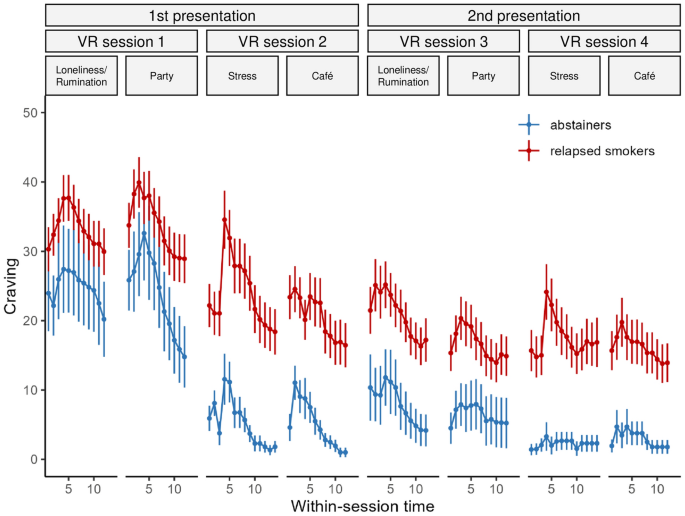
Within and between scenario craving ratings during the course of the VR-CET for abstainers and relapsed smokers. Fifth and tenth craving rating is marked on the x-axis for each scenario. Error bars show standard errors.
In the following, we first describe the additional effects that include the factor group , second the effects that include the factor presentation (without group ), and third the effects that include the factor scenario (without group and presentation ).
Post hoc tests for the three-way interaction of presentation × group × within-scenario time indicated that, relative to relapsed smokers, abstainers tended to have stronger linear decreases in craving in the first presentation of scenarios, b = − 3.43, SE = 1.62, t (6580) = − 2.11, p = 0.069 ( p = 0.035 without adjustment for multiple comparisons), whereas this effect was not significant for the second presentation (b = 2.32, SE = 1.92, t (6601) = 1.21, p = 0.228). Post hoc tests for the three-way interaction of scenario × group × within-scenario time 2 indicated that the quadratic trend of within-scenario time was stronger in relapsed smokers relative to abstainers in the stress scenario, b = 4.95, SE = 1.86, t (6571) = 2.67, p = 0.031, whereas this effect was not significant in the remaining three scenarios ( p s > 0.320). This means that relapsed smokers showed more craving directly following the stress induction.
Post hoc tests with respect to the interaction of presentation × scenario indicated that craving during the first presentation was significantly higher compared to the second presentation for all scenarios (Loneliness/Rumination: b = 16.35, SE = 2.75, t (86.8) = 5.95, p < 0.001; Party: b = 17.92, SE = 2.45, t (83.7) = 7.32, p < 0.001; Stress: b = 6.18, SE = 2.37, t (65.2) = 2.60, p = 0.023; Café: b = 5.02, SE = 2.24, t (70.4) = 2.24, p = 0.028) and that this decrease was more pronounced in the scenarios Loneliness/Rumination and Party than in Stress and Café (Loneliness/Rumination compared with Stress: b = 10.17, SE = 3.61, t (72.6) = 2.82, p = 0.019; Loneliness/Rumination compared with Café: b = 11.34, SE = 3.48, t (76.9) = 3.26, p = 0.007; Party compared with Stress: b = 11.74, SE = 3.29, t (69.4) = 3.57, p = 0.003; Party compared with Café: b = 12.91, SE = 3.28, t (70.8) = 3.93, p = 0.001; no significant differences for comparisons of Loneliness/Rumination and Party, p = 1.000, and Stress and Café, p = 1.000). The interactions of presentation × within-scenario time and presentation × within-scenario time 2 , indicate that the linear and quadratic course of craving differed across presentations. Post hoc comparisons revealed that the second presentation of scenarios resulted in smaller linear decreases in craving, b = − 6.37, SE = 1.26, t (6596) = − 5.07, p < 0.001, and in terms of the quadratic effect, in a flatter increase and decrease of craving, b = 3.46, SE = 1.22, t (6580) = 2.83, p = 0.005. In addition, the three-way interaction of presentation × scenario × within-scenario time indicates that the presentation × within-scenario time effect described above, differed between scenarios. Whereas in Loneliness/Rumination, the difference in the linear course of craving between first and second presentation was not significant, b = 4.84, SE = 2.58, t (6583) = 1.88, p = 0.060, for all three remaining scenarios, stronger linear decreases of craving were observed in the first compared to the second presentation (Party: b = − 16.67, SE = 2.62, t (6597) = − 6.36, p < 0.001; Stress: b = − 7.24, SE = 1.88, t (6620) = − 3.84, p < 0.001; Café: b = − 6.43, SE = 2.86, t (6608) = − 2.25, p = 0.060).
The interaction of scenario × within-scenario time results from a more negative linear decrease of craving in Party compared to Stress, b = − 9.33, SE = 1.62, t (6611) = − 5.78, p < 0.001, in Party compared to Café, b = − 5.20, SE = 1.94, t (6609) = − 2.68, p = 0.030, in Loneliness/Rumination compared to Stress, b = − 5.87, SE = 1.60, t (6607) = − 3.68, p = 0.001, and in Café compared to Stress, b = − 4.13, SE = 1.71, t (6621) = − 2.42, p = 0.0495. Finally, the main effect scenario results from higher craving in Loneliness/Rumination than in Stress, b = 7.57, SE = 1.90, t (79.7) = 3.98, p < 0.001, in Loneliness/Rumination than in Café, b = 9.91, SE = 1.86, t (73.5) = 5.33, p < 0.001, in Party than in Stress, b = 5.63, SE = 1.77, t (80.8) = 3.18, p = 0.006, and in Party than in Café, b = 7.97, SE = 1.55, t (75.6) = 5.13, p < 0.001. Loneliness/Rumination and Party ( p = 0.204), and Stress and Café ( p = 0.129) did not differ significantly. Supplementary Table S4 provides a full model summary.
An identical analysis, including only abstinent participants at the time of each VR session, is detailed in the supplementary materials (see Table S5 and Fig. S2) and yielded basically similar results.
Predictive ability of craving on abstinence
Two binomial logistic regressions with mean craving across all VR-CET sessions and with the difference between maximum craving and the final craving rating averaged across all VR-CET sessions as predictors for the likelihood of abstinence at 6-month follow-up were performed. The overall model evaluation for the first model using mean craving as a predictor was statistically significant, χ 2 (1) = 12.69, p < 0.001, R 2 N = 0.176. Mean craving was positively associated with relapse ( β = 0.058, SE = 0.019, z = 2.98, p = 0.003, OR = 1.06). Applying Youden’s criterion yielded an optimal cut-off for mean craving of M > 12.63 for predicting relapse. This way, the model correctly classified 17 of 24 future abstainers (70.8% specificity) and 55 of 78 future relapsing smokers (70.5% sensitivity) resulting in overall 72 of 102 correct classifications (70.6% accuracy).
The overall model evaluation for the second model using the difference between maximum and final craving rating as a predictor was statistically not significant, χ 2 (1) = 0.691, p = 0.406, R 2 N = 0.010.
To the best of our knowledge, the present study is the first to analyze craving ratings during VR-CET prospectively with regard to subsequent abstinent and relapsing smokers. In addition, we investigated further parameters of the VR-CET scenarios, namely emotion induction, self-efficacy, presence, and tolerability, which might influence their efficacy.
The analysis of craving across the virtual exposure sessions with respect to future abstainers and relapsed smokers revealed three interesting patterns: First, future relapsed smokers showed generally higher craving than future abstainers which also predicted relapse. Second, relapsed smokers showed stronger increases in craving elicited by the Stress scenario than abstainers. Third, abstainers tended to down-regulate craving faster within the first presentation of scenarios. Regarding the first aspect, smokers that relapsed within 6 months after end of treatment showed higher craving levels than future abstainers during VR-CET. While craving generally decreased across VR-CET (which is in line with previous reports 21 , 22 and also consistent with the CE rational), it remained consistently higher in relapsing smokers. This is in line with previous findings from the neuroimaging literature, which found increased brain activation in substance use disorders with respect to substance-related cues in cue-reactivity tasks in relapsing individuals relative to individuals who remained abstinent 41 . Additionally, our results are consistent with an analysis of several nicotine replacement therapy (NRT) trials, which found that low craving was associated with a higher likelihood of sustained abstinence 42 . The differences found in craving between future abstainers and relapsing smokers appear even more relevant as the two groups did not significantly differ in any other smoking parameter such as cigarettes per day, Fagerström score or carbon monoxide levels. Furthermore, high craving was a significant prognostic factor for higher relapse probability. This effect was small, however, demonstrating the need for further research in identifying additional predictors of relapse. As reviewed by Wray et al. 6 , cue-induced craving during classical cue-reactivity assessment was only rarely a significant predictor of treatment outcome in previous studies, which contrasts our finding. One reasons for this difference could be, in accordance with the argumentation of Tiffany et al. 2 , the higher correspondence of the situation of the craving assessment and real-life situations by using VR. Therefore, the predictive effect of craving may be still larger if presence in VR could be further increased. Another reason could be that the VR-CET sessions took place after the smoking cessation program’s planned quit date, thus craving during VR-CET was assessed in a phase in which the majority of the participants had achieved abstinence. This could have been beneficial for the prognostic capacity of craving, as it was argued that the combination of substance-related cues and abstinence is better suited for detecting craving as an indicator of relapse than during periods of nicotine saturation 43 . Taken together, the first pattern implies that participants with high craving should be considered a high-risk group for relapse and therapy should be individualized accordingly. This could include both increased discussion of coping strategies for craving in the CBT component of treatment and possibly a stronger recommendation of additional NRT.
Second, future relapsed smokers showed a stronger craving response to the stress induction in the Stress scenario than future abstainers. This suggests that reducing the craving response to stress should be an important therapeutic goal in smoking cessation, which is in line with previous research underscoring the particular role of stress by reporting that stress increases cigarette craving and promotes relapse 44 , 45 . The fact that craving amplitudes generally attenuate across presentations is consistent with the rational of CE and suggests that reducing the craving response to stress may be achieved by further runs of the Stress scenario. In addition, participants with a strong craving response to stress might benefit from an intensification of stress management and the development of further coping strategies as part of the CBT component of smoking cessation. Future trials should examine whether these considerations translate into higher efficacy of VR-CET.
Third, the linear decrease in craving within a scenario significantly differed as a function of whether a scenario was presented for the first or the second time and whether participants would remain abstinent. Thus, the linear within-scenario decrease in craving may affect treatment success as future abstainers tended to down-regulate their craving more quickly. However, this finding should be treated with caution for three reasons. First, whereas there was a trend of faster craving regulation by future abstainers in the first presentation of scenarios, this was not the case with respect to the second presentation (although floor effects in the second presentation may have contributed). Second, this three-way interaction did not show up significantly in the supplementary analysis that included only abstainers at the time of VR-CET as linear within-scenario craving reductions of future abstainers and relapsed smokers were more similar than in the main analysis. And third, the importance of the role of within-scenario craving decrease is reduced by the fact that the regression analysis examining the difference from maximum craving to the last craving rating did not significantly predict abstinence.
As part of the VR-CET, participants were confronted with a variety of smoking related situations. The Loneliness/Rumination scenario featured an intensive cue exposure with detailed observation of smoking paraphernalia while simultaneously inducing worry. The Party scenario, like the Stress and Café scenario, included interactions with smoking characters who offered cigarettes to the participants, whereby the presence of alcoholic beverages and witnessing a relapse were distinctive features. The stress scenario required participants to complete a job application presentation and an unannounced math task while smoking was presented as a beneficial coping strategy and reward by other characters. Finally, the Café scenario included coffee as a typical smoking associated stimulus and a conversation of smokers about smoking as a feeling of freedom and enjoyment in life. These scenarios were able to induce the specific intended emotions (worry, stress, sociability), which demonstrates the usefulness of VR for CET as it enables the presentation of substance-related cues in emotional contexts thus increasing ecological validity compared to traditional CET paradigms. This is in line with previous research that found VR to be generally effective in inducing emotions 46 and showed that different emotional states can be induced with relative distinctness 47 . With regard to the general decline in craving across the VR scenarios, we can only speculate whether certain elements of the scenarios were particularly important or whether it was the variety that was decisive (see also limitations below on order effects). However, the Stress scenario stands out because of the most pronounced increase in craving after the stress task, which only disappeared for future abstainers in the second run. Particularly the elements of stress relief and reward after completing a task, which are not present in the other scenarios, may lead to this sharper increase in craving. This notion is in line with Fagerström 48 who emphasizes the importance of the rewarding function of smoking.
In terms of self-efficacy, participants reported high levels of confidence in not smoking in similar situations in the future for all scenarios without significant differences between future abstainers and relapsed smokers. This conviction is understandable because treatment-seeking participants must exhibit a certain level of self-efficacy expectancy to enroll in treatment in the first place, because the majority of participants had already achieved abstinence at the time of VR-CET, and because the question about self-efficacy was asked at the end of the scenario, which virtually had just been successfully completed without smoking. Nevertheless, the results suggest that therapists should remain cautious and not base therapeutic actions on self-efficacy as the majority of participants later relapsed, although self-efficacy was high during VR-CET.
With respect to presence (the sense of being there), VR scenarios generated moderate levels of presence. Party and Loneliness/Rumination induced significantly higher levels of presence than Café and Stress, and presence generally decreased in the second compared to the first presentation of scenarios. Both measures of presence (single item rating and IPQ) were highly correlated, indicating validity of the single item measure. Presence is regarded as an indicator of felt similarity to real-life situations 9 , therefore high presence is desirable to generalize the learning experiences within VR to real life. Higher presence could be achieved through the ongoing graphical progress in the field of VR 49 . In addition, tactile (e.g. feeling a real table of a café in front of oneself), olfactory (e.g. smell of tobacco, smoke, coffee, barbecue), and auditory (audio renderings which simulate room acoustics and spatial sound) sensory modalities could be added to increase the observed moderate presence in future applications. The differences between the scenarios in terms of experienced presence probably mainly reflect the decrease in presence over several sessions, since the earlier scenarios generated higher presence than the later scenarios. It is a known phenomenon that stronger emotional experience is associated with higher presence, which is explained by increased arousal 49 . In this respect, the reduction in presence over time may be explained by decreasing arousal with repeated VR-CET through habituation processes. Although presented first, the relatively high level of presence in Loneliness/Rumination is somewhat surprising given that it is the only scenario without interaction with virtual agents. However, in this scenario, the aforementioned auditory aspect might have additionally contributed to the experienced presence through the sound of rain and music. It is noticeable that despite high emotional arousal in the Stress scenario, the experience of presence was comparatively lower. We suppose that there may have been a lower felt similarity to real-life situations as participants are likely to be exposed to other stressful situations in their daily lives. This intensive stress induction, which tends to be more distant from everyday life, nonetheless led to craving reductions over the course of the treatment and enabled future abstainers and relapsing smokers to be distinguished. Future studies could investigate whether the approach of the present study or the induction of a more moderate but everyday stress would result in higher presence and be more favorable for use in VR-CET. While presence is an important parameter in VR research, it will often not be feasible to assess presence with questionnaires (e.g. in case of multiple ratings) and these have the potential disadvantage of assessing presence retrospectively when immersion in VR has already ended. In this regard, our results support the further use of single item ratings during VR as a more economical alternative.
Finally, regarding tolerability, VR-CET sessions were well tolerated with no evidence that this could account for differences in treatment success.
An important limitation of the current study is that the data analyzed derive from a treatment study primarily designed to evaluate the efficacy of VR-CET as an additional intervention to group CBT compared with a relaxation procedure and group CBT. In this respect, we cannot rule out the possibility that the observed craving reductions are due to causes other than VR-CET, such as effects of CBT alone, or to the simple progression of time. These explanations nevertheless seem unlikely as they cannot explain the within scenario craving reductions, because VR-CET alone led to craving reductions in a previous study 21 , and because cue-induced craving usually increases and not decreases following abstinence, a phenomenon called incubation of craving 50 . An additional limitation is the likely occurrence of order effects with respect to presence and craving as scenarios were presented in a uniform order without counterbalancing. As an example, despite the significantly higher craving in Party than in Café, we cannot conclude that this is due to content differences of the scenarios (the presence of alcoholic beverages produces higher craving than coffee could be such a content interpretation), because Café was chronologically always presented after Party. We therefore refrained from interpreting such direct scenarios comparisons. Future studies could use our scenarios in a counterbalanced design to further examine these content differences.
In conclusion, we found evidence that smokers who relapse within 6 months exhibit higher levels of craving during VR-CET than do smokers who maintain abstinence and that craving during VR-CET predicts relapse. Furthermore, we found that craving responses evoked by the Stress scenario were discriminative with respect to future abstinence as relapsing smokers reacted with stronger craving. Attempts to improve VR-CET and ultimately smoking cessation outcomes, should aim to identify smokers who are more at risk of relapse based on their persistently high craving levels and individualize smoking cessation accordingly. Additionally, particular emphasis should be placed on the strength of the craving response to stress, which may be lowered by further therapeutic efforts applying stress-inducing scenarios.
Data availability
The datasets analyzed during the current study are available from the corresponding author on reasonable request.
American Psychiatric Association. Diagnostic and Statistical Manual of Mental Disorders. 5th ed. (American Psychiatric Association, 2013).
Tiffany, S. T., Warthen, M. W. & Goedeker, K. C. The functional significance of craving in nicotine dependence. Nebraska Symp. Motiv. 55 , 171–197. https://doi.org/10.1007/978-0-387-78748-0_10 (2009).
Article Google Scholar
Ferguson, S. G. & Shiffman, S. The relevance and treatment of cue-induced cravings in tobacco dependence. J. Subst. Abuse Treat. 36 , 235–243. https://doi.org/10.1016/j.jsat.2008.06.005 (2009).
Article PubMed Google Scholar
Teneggi, V. et al. Effect of sustained-release (SR) bupropion on craving and withdrawal in smokers deprived of cigarettes for 72 h. Psychopharmacology 183 , 1–12. https://doi.org/10.1007/s00213-005-0145-x (2005).
Article CAS PubMed Google Scholar
Tiffany, S. T. & Wray, J. M. The clinical significance of drug craving. Ann. N. Y. Acad. Sci. 1248 , 1–17. https://doi.org/10.1111/j.1749-6632.2011.06298.x (2012).
Article ADS CAS PubMed Google Scholar
Wray, J. M., Gass, J. C. & Tiffany, S. T. A systematic review of the relationships between craving and smoking cessation. Nicotine Tob. Res. 15 , 1167–1182. https://doi.org/10.1093/ntr/nts268 (2013).
Article PubMed PubMed Central Google Scholar
Betts, J. M., Dowd, A. N., Forney, M., Hetelekides, E. & Tiffany, S. T. A meta-analysis of cue reactivity in tobacco cigarette smokers. Nicotine Tob. Res. 23 , 249–258. https://doi.org/10.1093/ntr/ntaa147 (2021).
Drummond, D. C. What does cue-reactivity have to offer clinical research?. Addiction (Abingdon, England) 95 (Suppl 2), S129–S144. https://doi.org/10.1080/09652140050111708 (2000).
Hone-Blanchet, A., Wensing, T. & Fecteau, S. The use of virtual reality in craving assessment and cue-exposure therapy in substance use disorders. Front. Hum. Neurosci. 8 , 844. https://doi.org/10.3389/fnhum.2014.00844 (2014).
Conklin, C. A. & Tiffany, S. T. Applying extinction research and theory to cue-exposure addiction treatments. Addiction (Abingdon, England) 97 , 155–167. https://doi.org/10.1046/j.1360-0443.2002.00014.x (2002).
Martin, T., LaRowe, S. D. & Malcolm, R. Progress in cue exposure therapy for the treatment of addictive disorders: a review update. TOADDJ 3 , 92–101. https://doi.org/10.2174/1874941001003010092 (2010).
Article CAS Google Scholar
Mellentin, A. I. et al. Cue exposure therapy for the treatment of alcohol use disorders: A meta-analytic review. Clin. Psychol. Rev. 57 , 195–207. https://doi.org/10.1016/j.cpr.2017.07.006 (2017).
Kiyak, C., Simonetti, M. E., Norton, S. & Deluca, P. The efficacy of cue exposure therapy on alcohol use disorders: A quantitative meta-analysis and systematic review. Addict. Behav. 139 , 107578. https://doi.org/10.1016/j.addbeh.2022.107578 (2023).
Mazza, M., Kammler-Sücker, K., Leménager, T., Kiefer, F. & Lenz, B. Virtual reality: a powerful technology to provide novel insight into treatment mechanisms of addiction. Transl. Psychiatry 11 , 617. https://doi.org/10.1038/s41398-021-01739-3 (2021).
Winkler, M. H., Li, Y., Pauli, P. & Mühlberger, A. Modulation of smoking cue reactivity by social context—Implications for exposure therapy in virtual reality. Front. Virtual Real. 4 , 1. https://doi.org/10.3389/frvir.2023.926679 (2023).
Thompson-Lake, D. G. Y. et al. Withdrawal symptoms and nicotine dependence severity predict virtual reality craving in cigarette-deprived smokers. Nicotine Tob. Res. 17 , 796–802. https://doi.org/10.1093/ntr/ntu245 (2015).
Segawa, T. et al. Virtual reality (VR) in assessment and treatment of addictive disorders: A systematic review. Front. Neurosci. 13 , 1409. https://doi.org/10.3389/fnins.2019.01409 (2020).
Kaganoff, E., Bordnick, P. S. & Carter, B. L. Feasibility of using virtual reality to assess nicotine cue reactivity during treatment. Res. Soc. Work Pract. 22 , 159–165. https://doi.org/10.1177/1049731511428617 (2012).
Bordnick, P. S., Traylor, A. C., Carter, B. L. & Graap, K. M. A feasibility study of virtual reality-based coping skills training for nicotine dependence. Res. Soc. Work Pract. 22 , 293–300. https://doi.org/10.1177/1049731511426880 (2012).
Park, C.-B. et al. Comparison of the effectiveness of virtual cue exposure therapy and cognitive behavioral therapy for nicotine dependence. Cyberpsychol. Behav. Soc. Network. 17 , 262–267. https://doi.org/10.1089/cyber.2013.0253 (2014).
Pericot-Valverde, I., Secades-Villa, R., Gutiérrez-Maldonado, J. & García-Rodríguez, O. Effects of systematic cue exposure through virtual reality on cigarette craving. Nicotine Tob. Res. 16 , 1470–1477. https://doi.org/10.1093/ntr/ntu104 (2014).
Article CAS PubMed PubMed Central Google Scholar
Pericot-Valverde, I., Secades-Villa, R. & Gutiérrez-Maldonado, J. A randomized clinical trial of cue exposure treatment through virtual reality for smoking cessation. J. Subst. Abuse Treat. 96 , 26–32. https://doi.org/10.1016/j.jsat.2018.10.003 (2019).
Kroczek, A. et al. Studienprotokoll für eine randomisiert-kontrollierte Studie zur Untersuchung der Cue-Exposure in der virtuellen Realität: Herausforderungen und Ausblick [Study Protocol for a Randomized-Controlled Study Investigating Cue-Exposure in Virtual Reality: Challenges and Chances]. SUCHT 69 , 56–64. https://doi.org/10.1024/0939-5911/a000812 (2023).
Heatherton, T. F., Kozlowski, L. T., Frecker, R. C. & Fagerström, K.-O. The Fagerström test for nicotine dependence: a revision of the Fagerstrom Tolerance Questionnaire. Br. J. Addict. 86 , 1119–1127 (1991).
Schaller, K., Kahnert, S., Graen, L., Mons, U. & Ouédraogo, N. Tabakatlas Deutschland 2020 [Tobacco Atlas Germany 2020] 1st edn. (Pabst Science Publishers, 2020).
Google Scholar
Stöber, J. Besorgnis: Ein Vergleich dreier Inventare zur Erfassung allgemeiner Sorgen [Worry: A comparison of three inventories to capture common concerns]. Zeitschrift für Differentielle und Diagnostische Psychologie 16 , 50–63 (1995).
Kirschbaum, C., Pirke, K. M. & Hellhammer, D. H. The ’Trier Social Stress Test’–a tool for investigating psychobiological stress responses in a laboratory setting. Neuropsychobiology 28 , 76–81. https://doi.org/10.1159/000119004 (1993).
Shiban, Y. et al. Trier social stress test in vivo and in virtual reality: Dissociation of response domains. Int. J. Psychophysiol. 110 , 47–55. https://doi.org/10.1016/j.ijpsycho.2016.10.008 (2016).
Schröder, B. & Mühlberger, A. Measuring attentional bias in smokers during and after psychosocial stress induction with a Trier Social Stress Test in virtual reality via eye tracking. Front. Psychol. https://doi.org/10.3389/fpsyg.2023.1129422 (2023).
Batra, A. & Buchkremer, G. Tabakentwöhnung: Ein Leitfaden für Therapeuten [Tobacco cessation: a guide for therapists] (W. Kohlhammer Verlag, 2004).
Book Google Scholar
Batra, A. et al. A cluster-randomized effectiveness trial of smoking cessation modified for at-risk smoker subgroups. J. Subst. Abuse Treat. 38 , 128–140. https://doi.org/10.1016/j.jsat.2009.08.003 (2010).
Schubert, T., Friedmann, F. & Regenbrecht, H. The experience of presence: Factor analytic insights. Presence 10 , 266–281 (2001).
Kennedy, R. S., Lane, N. E., Berbaum, K. S. & Lilienthal, M. G. Simulator sickness questionnaire: An enhanced method for quantifying simulator sickness. Int. J. Aviat. Psychol. 3 , 203–220. https://doi.org/10.1207/S15327108IJAP0303_3 (1993).
West, R., Hajek, P., Stead, L. & Stapleton, J. Outcome criteria in smoking cessation trials: Proposal for a common standard. Addiction (Abingdon, England) 100 , 299–303. https://doi.org/10.1111/j.1360-0443.2004.00995.x (2005).
Bates, D., Mächler, M., Bolker, B. & Walker, S. Fitting linear mixed-effects models using lme4. J. Stat. Soft. 6 , 7. https://doi.org/10.18637/jss.v067.i01 (2015).
Matuschek, H., Kliegl, R., Vasishth, S., Baayen, H. & Bates, D. Balancing Type I error and power in linear mixed models. J. Memory Lang. 94 , 305–315. https://doi.org/10.1016/j.jml.2017.01.001 (2017).
Luke, S. G. Evaluating significance in linear mixed-effects models in R. Behavior Res. Methods 49 , 1494–1502. https://doi.org/10.3758/s13428-016-0809-y (2017).
Lenth, R. emmeans: Estimated Marginal Means, aka Least-Squares Means . https://CRAN.R-project.org/package=emmeans (2023).
Holm, S. A simple sequentially rejective multiple test procedure. Scand. J. Stat. 6 , 65–70 (1979).
MathSciNet Google Scholar
López-Ratón, M., Rodríguez-Álvarez, M. X., Suárez, C. C. & Sampedro, F. G. OptimalCutpoints : An R package for selecting optimal cutpoints in diagnostic tests. J. Stat. Soft. https://doi.org/10.18637/jss.v061.i08 (2014).
Moeller, S. J. & Paulus, M. P. Toward biomarkers of the addicted human brain: Using neuroimaging to predict relapse and sustained abstinence in substance use disorder. Prog. Neuro-Psychopharmacol. Biol. Psychiatry 80 , 143–154. https://doi.org/10.1016/j.pnpbp.2017.03.003 (2018).
Germovsek, E. et al. A time-to-event model relating integrated craving to risk of smoking relapse across different nicotine replacement therapy formulations. Clin. Pharmacol. Therap. 109 , 416–423. https://doi.org/10.1002/cpt.2000 (2021).
Sayette, M. A. & Tiffany, S. T. Peak provoked craving: An alternative to smoking cue-reactivity. Addiction (Abingdon, England) 108 , 1019–1025. https://doi.org/10.1111/j.1360-0443.2012.04013.x (2013).
Baker, T. B., Brandon, T. H. & Chassin, L. Motivational influences on cigarette smoking. Ann. Rev. Psychol. 55 , 463–491. https://doi.org/10.1146/annurev.psych.55.090902.142054 (2004).
Schultz, M. E., Fronk, G. E., Jaume, N., Magruder, K. P. & Curtin, J. J. Stressor-elicited smoking and craving during a smoking cessation attempt. J. Psychopathol. Clin. Sci. 131 , 73–85. https://doi.org/10.1037/abn0000702 (2022).
Diniz Bernardo, P., Bains, A., Westwood, S. & Mograbi, D. C. Mood induction using virtual reality: A systematic review of recent findings. J. Technol. Behav. Sci. 6 , 3–24. https://doi.org/10.1007/s41347-020-00152-9 (2021).
Felnhofer, A. et al. Is virtual reality emotionally arousing? Investigating five emotion inducing virtual park scenarios. Int. J. Human-Comput. Stud. 82 , 48–56. https://doi.org/10.1016/j.ijhcs.2015.05.004 (2015).
Fagerström, K. Determinants of tobacco use and renaming the FTND to the Fagerstrom Test for Cigarette Dependence. Nicotine Tob. Res. 14 , 75–78. https://doi.org/10.1093/ntr/ntr137 (2012).
Diemer, J., Alpers, G. W., Peperkorn, H. M., Shiban, Y. & Mühlberger, A. The impact of perception and presence on emotional reactions: a review of research in virtual reality. Front. Psychol. 6 , 26. https://doi.org/10.3389/fpsyg.2015.00026 (2015).
Bedi, G. et al. Incubation of cue-induced cigarette craving during abstinence in human smokers. Biol. Psychiatry 69 , 708–711. https://doi.org/10.1016/j.biopsych.2010.07.014 (2011).
Download references
Open Access funding enabled and organized by Projekt DEAL. Deutsche Krebshilfe, Grant Number 70111871 to AB, AE and AM.
Author information
Authors and affiliations.
Department for Psychology, Clinical Psychology and Psychotherapy, University of Regensburg, Universitätsstraße 31, 93053, Regensburg, Germany
Benedikt Schröder, Leon O. H. Kroczek & Andreas Mühlberger
Department of Psychiatry and Psychotherapy, Tübingen Center for Mental Health (TüCMH), University Hospital Tübingen, Tübingen, Germany
Agnes Kroczek, Ann-Christine Ehlis & Anil Batra
Department of Psychiatry and Psychotherapy, Tübingen Center for Mental Health (TüCMH), Section for Addiction Research and Medicine University Hospital Tübingen, Tübingen, Germany
Agnes Kroczek & Anil Batra
German Center for Mental Health (DZPG), partner site Tübingen, Tübingen, Germany
Ann-Christine Ehlis & Anil Batra
You can also search for this author in PubMed Google Scholar
Contributions
Data was analyzed by BS and LK under consultation of AM, AK, and ACE. BS wrote the first draft of the manuscript, which was finalized with substantial contributions of all remaining authors. All authors reviewed the manuscript and have approved its final version and its submission.
Corresponding author
Correspondence to Benedikt Schröder .
Ethics declarations
Competing interests.
AB is the author of the smoking cessation program “Nichtraucher in 6 Wochen” [“Non-smoker in 6 weeks”]. AM is stakeholder of a commercial company (VTplus GmbH) that develops and sells virtual environment research systems. The remaining authors declare no competing interests.
Additional information
Publisher's note.
Springer Nature remains neutral with regard to jurisdictional claims in published maps and institutional affiliations.
Supplementary Information
Supplementary information., rights and permissions.
Open Access This article is licensed under a Creative Commons Attribution 4.0 International License, which permits use, sharing, adaptation, distribution and reproduction in any medium or format, as long as you give appropriate credit to the original author(s) and the source, provide a link to the Creative Commons licence, and indicate if changes were made. The images or other third party material in this article are included in the article's Creative Commons licence, unless indicated otherwise in a credit line to the material. If material is not included in the article's Creative Commons licence and your intended use is not permitted by statutory regulation or exceeds the permitted use, you will need to obtain permission directly from the copyright holder. To view a copy of this licence, visit http://creativecommons.org/licenses/by/4.0/ .
Reprints and permissions
About this article
Cite this article.
Schröder, B., Kroczek, A., Kroczek, L.O.H. et al. Cigarette craving in virtual reality cue exposure in abstainers and relapsed smokers. Sci Rep 14 , 7538 (2024). https://doi.org/10.1038/s41598-024-58168-7
Download citation
Received : 18 October 2023
Accepted : 26 March 2024
Published : 30 March 2024
DOI : https://doi.org/10.1038/s41598-024-58168-7
Share this article
Anyone you share the following link with will be able to read this content:
Sorry, a shareable link is not currently available for this article.
Provided by the Springer Nature SharedIt content-sharing initiative
This article is cited by
- Cara C. Young
- Santiago Papini
- Jasper A. J. Smits
Neuropsychopharmacology (2024)
By submitting a comment you agree to abide by our Terms and Community Guidelines . If you find something abusive or that does not comply with our terms or guidelines please flag it as inappropriate.
Quick links
- Explore articles by subject
- Guide to authors
- Editorial policies
Sign up for the Nature Briefing newsletter — what matters in science, free to your inbox daily.

PlayStation State Of Play Will Bring PSVR 2 Game Updates Tomorrow
PlayStation's State of Play presentation returns tomorrow, promising new updates on PSVR 2 games.
Airing on May 30, Sony revealed the latest State of Play presentation will last for over 30 minutes. "Tune in live for updates on PS5 and PS VR2 titles, plus a look at PlayStation Studios games arriving later this year," Sony states.
Going by previous presentations , we'd expect this latest State of Play to primarily focus on flatscreen PS5 games with only a handful of PSVR 2 titles.
Not much else is known about the upcoming presentation, though there's a few games this might include. Alien: Rogue Incursion , Metro Awakening and Skydance's Behemoth are all major third-party titles confirmed as coming to PSVR 2 later this year, though it's unclear if any first-party games are in development. Sony also plans to let the headset work on PC , and a PSVR 2 PC Adapter was recently certified in South Korea.
We've also seen Sony pushing PSVR 2 in its Days of Play 2024 celebration. Yesterday it announced that it's adding six PSVR 2 games into its PlayStation Plus Premium subscription catalog next week, which includes Walkabout Mini Golf, Synth Riders and The Walking Dead: Saints & Sinners + Chapter 2: Retribution.
It's also discounting the PSVR 2 headset by $100 for the next two weeks. The headset is available for $450, while the Horizon Call Of The Mountain bundle is also available for $500. Anyone who buys the headset or console from PlayStation Direct during this time will also receive 12 months of Netflix Premium.
PlayStation's State of Play presentation airs on May 30 at 3pm PT across YouTube , Twitch , and TikTok .
On Point Is A 90s-Inspired VR Lightgun Shooter Coming To Quest & Steam
Weekly newsletter.
Get a weekly summary of the most important VR and AR news.
Check your inbox to confirm! (it might also be in your spam folder)
Camouflaj Is Testing Quest 3’s Power For Batman: Arkham Shadow
Icymi this week: ghost of tsushima vr mod, nope challenge, chrono weaver & more, community discussion.
Sign up to get a weekly summary of the most important VR and AR news, straight to your inbox.
More VR Gaming
Quest 3 exclusive batman: arkham shadow story trailer reveals gotham threat, latest articles, john carmack "tried hard" to kill quest pro, correctly predicting it would fail, arcade paradise vr adds customization & new music in first major update, bonelab update adds quest 3 enhancements & major physics upgrades, visionos 2 reportedly won't bring any fundamental changes to apple vision pro, homeworld: vast reaches brings the iconic franchise to virtual and mixed reality, miracle pool cues up mixed reality billiards soon on quest, vrider review-in-progress: all about the road, silent slayer: vault of the vampire scares up a steam release later this year.

IMAGES
VIDEO
COMMENTS
With the VirtualSpeech app, you can add your own presentation slides into the virtual room with you, so that you can practice for an upcoming event. Simply save your presentation as a PDF document and add it to the app - you can change the slides in the virtual world by pressing your VR headset trigger. Add your own slides to the virtual ...
A quick tutorial showing how to create a VR Presentation in minutes using Vizible, Worldviz's no-coding solution for creating business presentations in VR. Q...
VR has many unique advantages over its printed or PowerPoint counterparts. For one, VR presentations are more interactive, leading to a greater level of engagement from viewers. No presentation can match the immersive nature of standing in a virtual world that reacts to your actions, while a narrator explains the significance during the session.
Begin With a Goal in Mind. The first step in creating a compelling VR presentation is deciding what the goal is. Once you have the goal, it will inform other questions like how to author the application and how to distribute it. It will even help determine which type of 360 media you want to use — images, video or CGI.
The downside of using VR for meetings, presentations, or collaborative efforts among a team is the need for the VR equipment. In most cases, you will need the VR headgear, VR controllers, and a machine with the appropriate specifications to support the equipment. Fortunately, the cost of VR equipment has dropped and the specifications for the ...
Starting VR within Enscape. The process to get into VR only takes these three steps: 1. Open a supported model (Revit, SketchUp, Rhino, Archicad, or Vectorworks) 2. Start Enscape. 3. Enable VR. In this scenario, it is possible to make changes in the design platform and have them appear within a live VR session.
The use of immersive presentations in VR has not only saved time for researchers but also elevated the quality of their research output.Arthur's personalized approach to presentations allows Societe Generale to move away from traditional slide-based formats and embrace interactive VR experiences. In these virtual environments, hierarchies are ...
You can also spread your presentation in a VR office environment and literally walk your clients through it slide by slide while also making real-time mark-ups and comments on the presentation. If you want to showcase a video in a cinematic feeling, you can easily upload a mp4-video file to Arthur. Want to have an in-depth discussion with your ...
Speech + Q&A: Deliver your presentation then answer questions about it. Conversation: Choose any topic and discuss it with simulated participants. Interview: ... "As an executive communications and public speaking coach, I was looking for a VR platform to add to my suite of client services. And I was so impressed by the capabilities of ...
Learn how to transform your PowerPoint presentation into a 3D virtual reality experience with FrameVR. Watch this tutorial and join the metaverse.
Business presentations can be intimidating. Follow Alice as she prepares for hers with help from Ovation in virtual reality. Learn more: https://bit.ly/2raRMwM
Number of slides: 10. Signup Free to download. A virtual reality (VR) PowerPoint template for professionals that want to share the latest trends in VR for education, VR for work, VR games, and interactive experiences. You'll be able to showcase key findings, descriptions, data, and more in a simple manner to make VR accessible for everyone.
Sharing a web link for immersive presentations is a simple 4 step process: Export the panorama from your desired rendering softwares to your local PC. Drag-and-drop your 360 panoramas in Sentio VR ...
This presentation template can help you give an idea to your audience of what it is like to use VR. You can also use it to present the latest updates, gadgets and more. Make your virtual reality product a success with this engaging presentation template, or browse through other ready-to-use presentation templates to find the design that suits you.
Availability: $14.99 on Valve Index, HTC Vive, Oculus Rift and Windows Mixed Reality. 4. Limelight VR. This straight-to-the-point public speaking app has just enough to offer to give you the right ...
Click the "Sessions" button at the bottom left of Presentation Designer to open the Sessions tab, and and then click the plus button to start a session. The start time will be set to the present time, which is fine since you'll be experiencing it in no time. Give it a name and then click "Add Session". You'll see your session appear in your ...
Virtual Orator is a virtual reality simulator that creates the sensation of being in front of an audience. Practice where, when and as often as you need. No more forcing your family, friends, or coworkers to endure five rounds of practice presentations. Our virtual audiences will take their place. Adjust the venue, audience size and behavior to ...
Download your presentation as a PowerPoint template or use it online as a Google Slides theme. 100% free, no registration or download limits. Get these VR templates to create immersive presentations that transport your audience to virtual worlds. No Download Limits Free for Any Use No Signups.
In this video I use my Oculus Quest VR headset and the sideloaded app Engage from https://engagevr.io/. I am in a Lecture Hall environment and I load a video...
Use visual imagery, gifs, videos, or animations to attract attention to the key points. Define the outcomes of your presentation, and set a time limit for each goal. For example, if the schedule has four points in total, don't spend more than 30 minutes on each. 5. Reduce and eliminate distractions.
Creating interactive VR walkthroughs of your architectural designs can significantly enhance your presentations, allowing clients to explore and understand your vision with unparalleled clarity.
The big announcement was the debut of the Apple Vision Pro headset, a "new kind of computer," as CEO Tim Cook put it in the presentation. But with MacBook Air and other Mac hardware announcements ...
Select the Slide Show tab. Select the Use Presenter View checkbox. Select which monitor to display Presenter View on. Select From Beginning or press F5. In Presenter View, you can: See your current slide, next slide, and speaker notes. Select the arrows next to the slide number to go between slides. Select the pause button or reset button to ...
Upload VR Showcase. The Upload VR Showcase, which is presented by UploadVR, IGN, and more, will showcase the best upcoming games in the world of virtual reality. Date TBA. It's very likely that ...
Add your presentation slides to the VR app, so that you can practice delivering a presentation with them.Learn more about this featurehttps://support.virtual...
Applying CET in virtual reality (VR) was proposed to increase its efficacy, as VR enables the presentation of social and environmental cues along with substance-related stimuli. However, limited ...
Airing on May 30, Sony revealed the latest State of Play presentation will last for over 30 minutes. "Tune in live for updates on PS5 and PS VR2 titles, plus a look at PlayStation Studios games ...